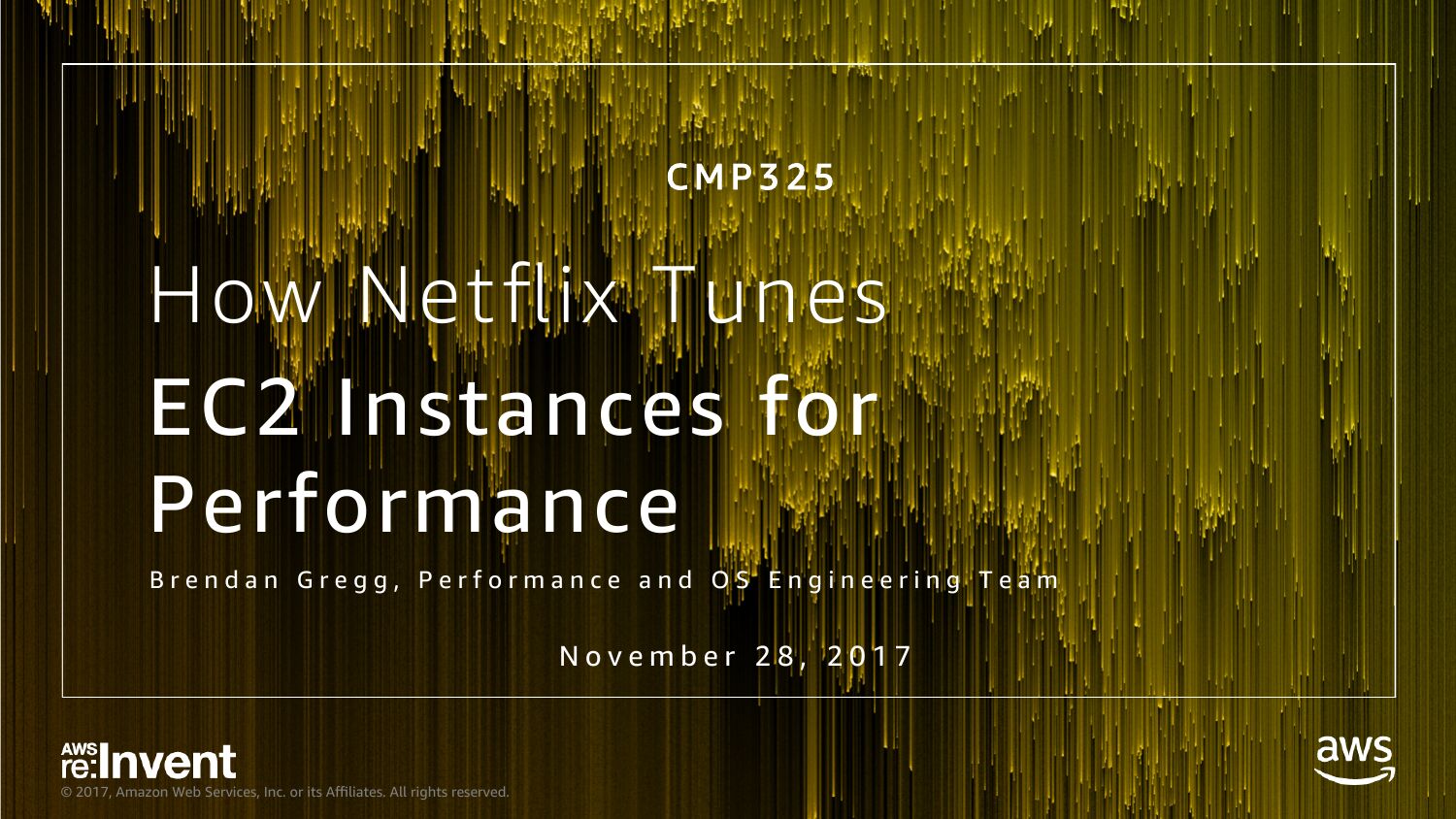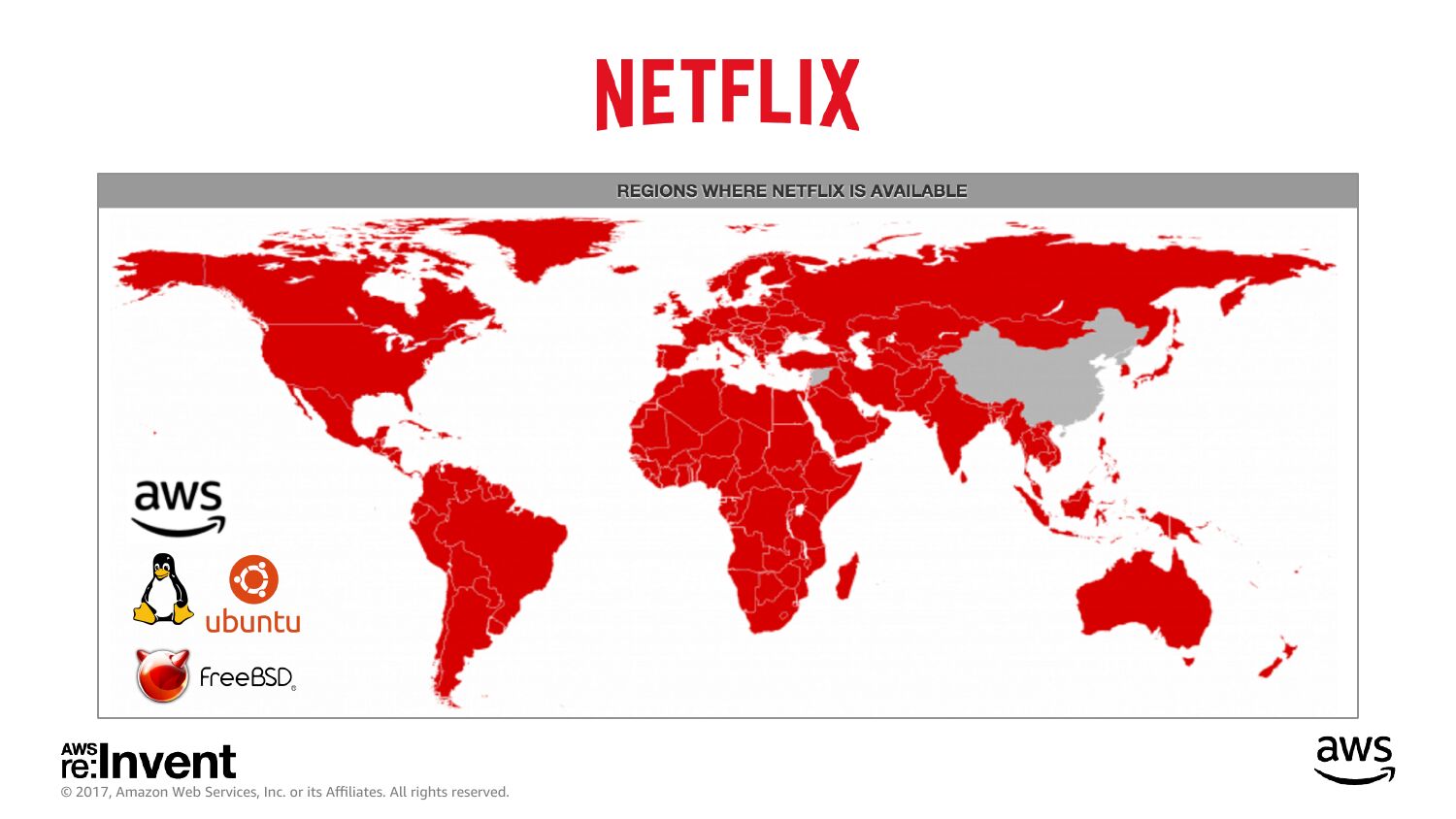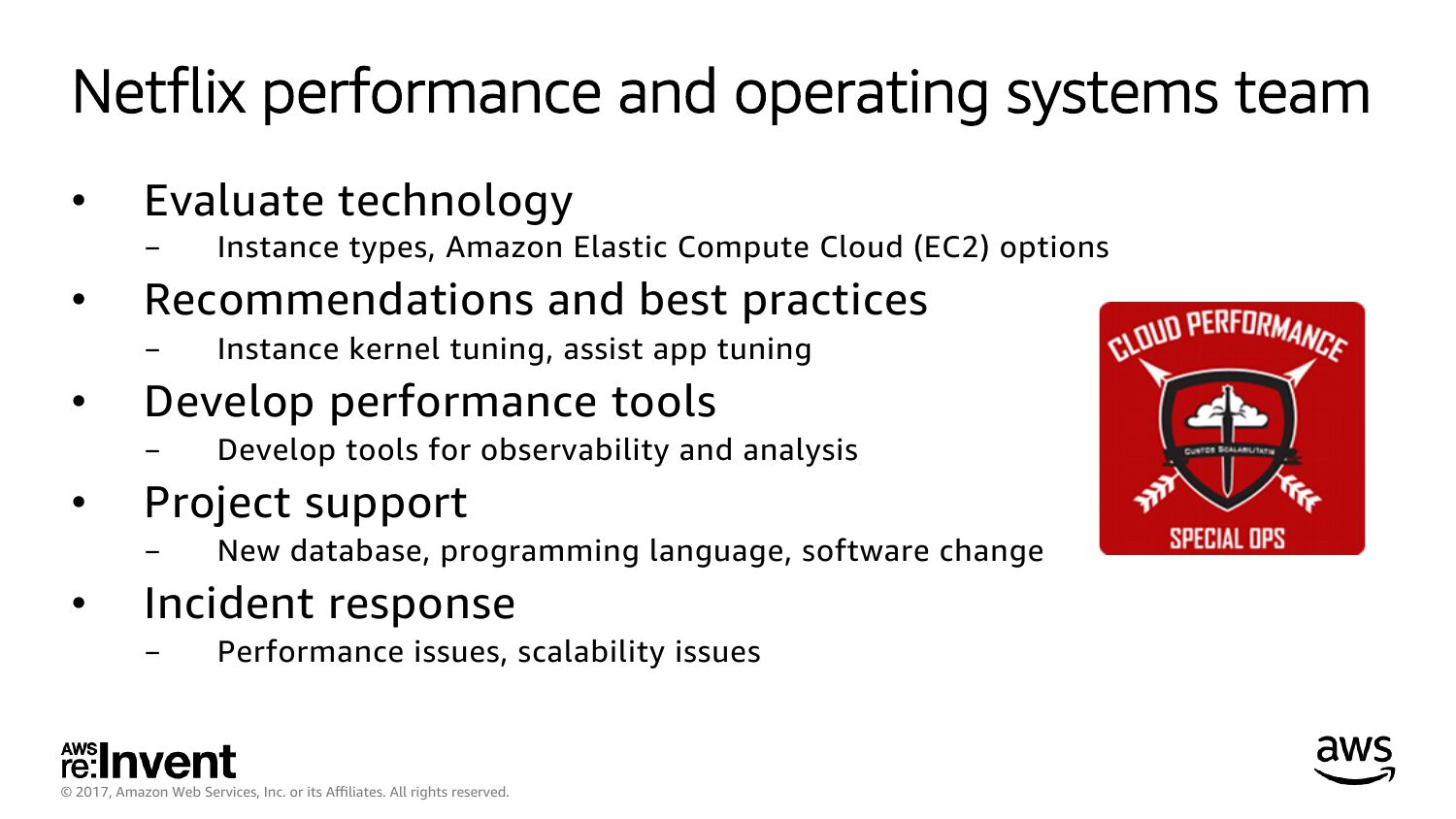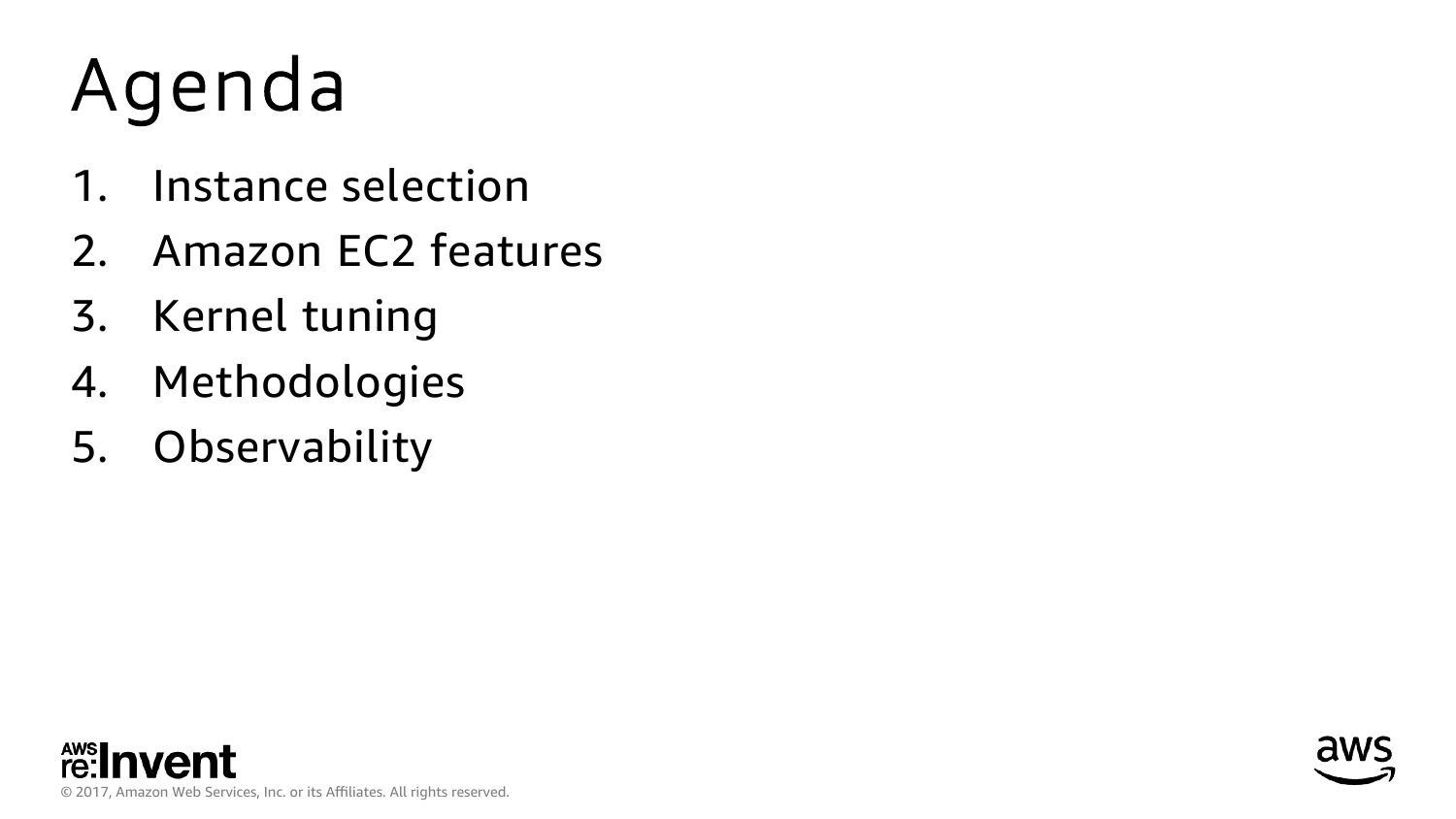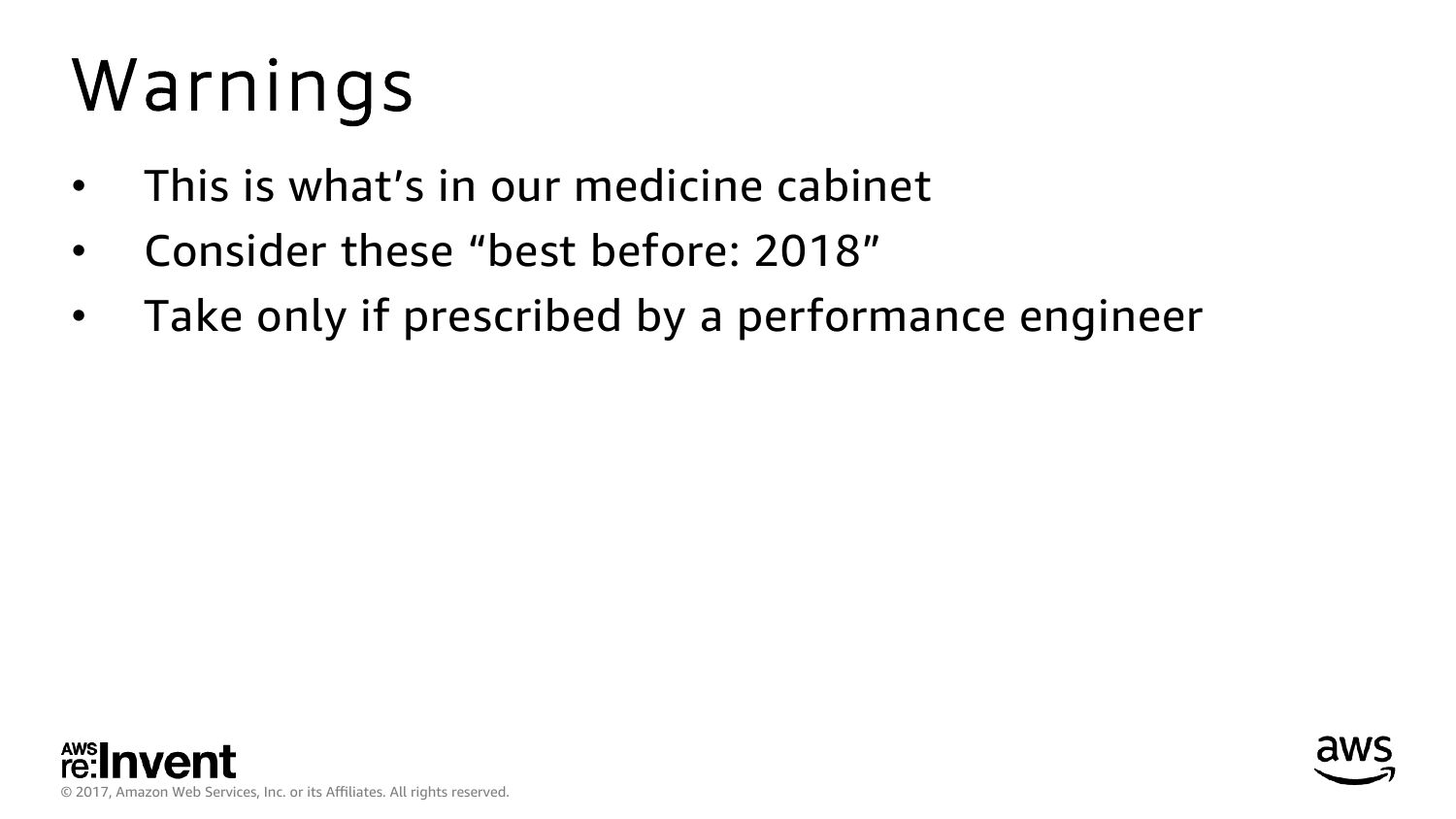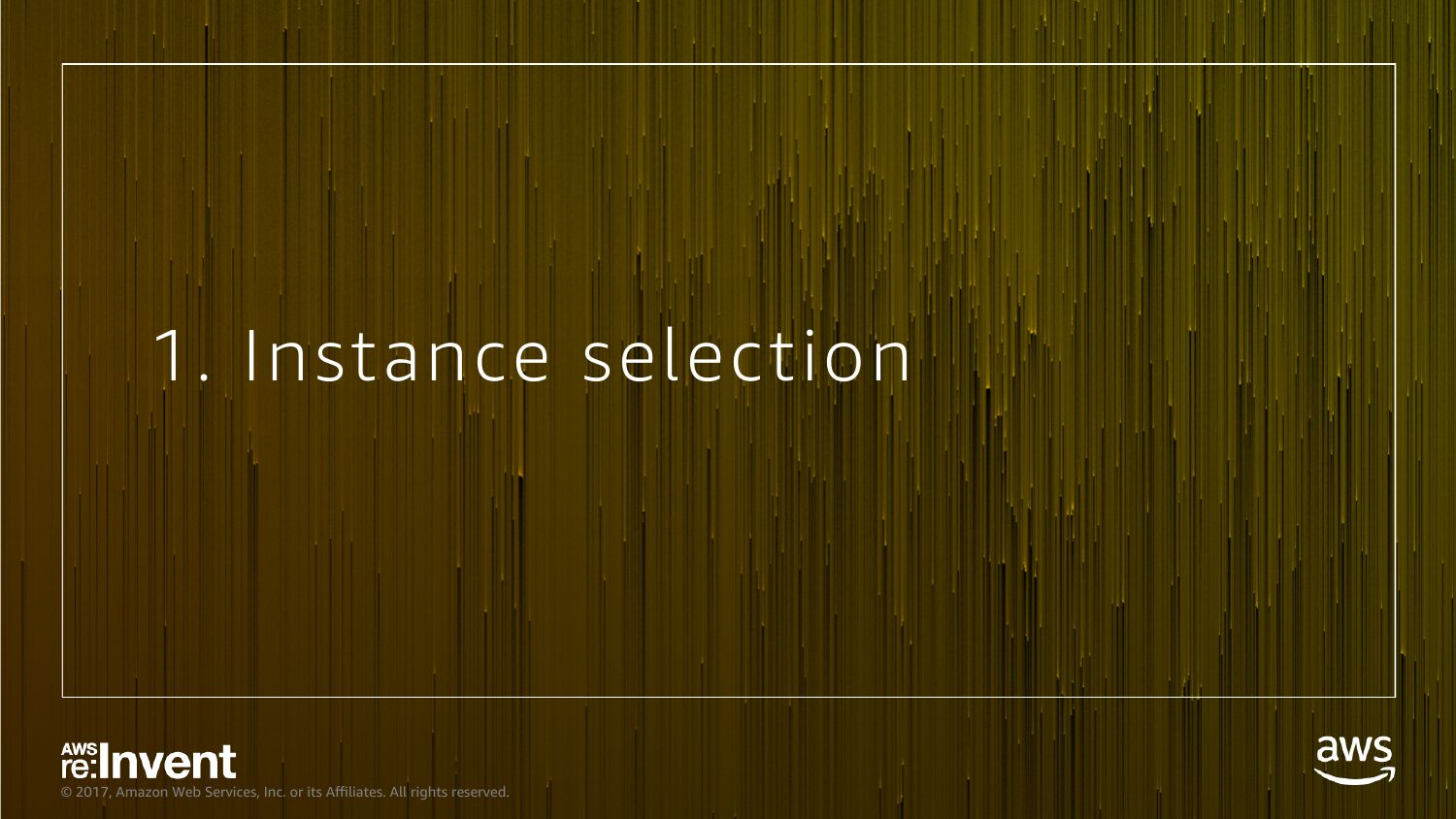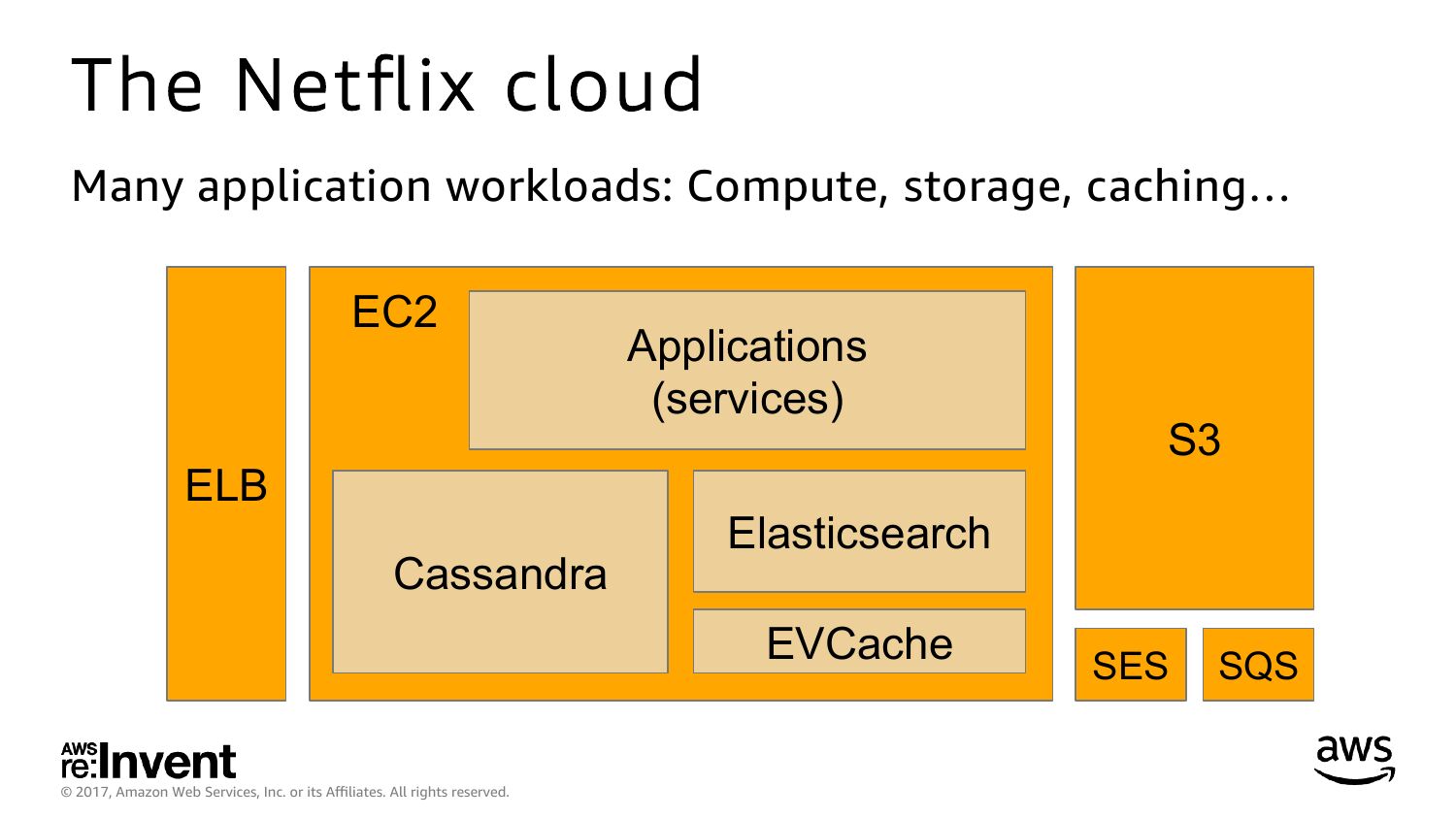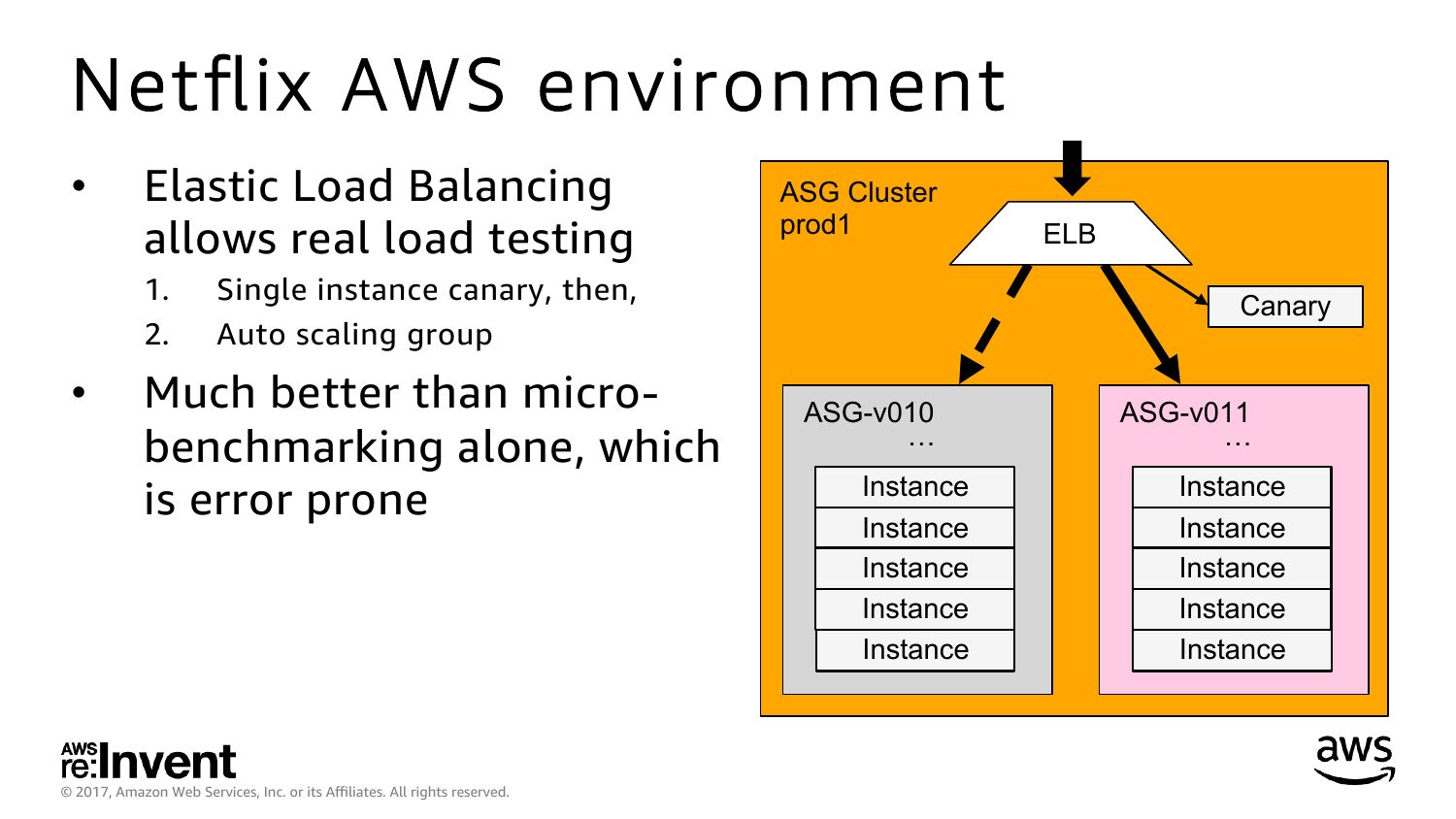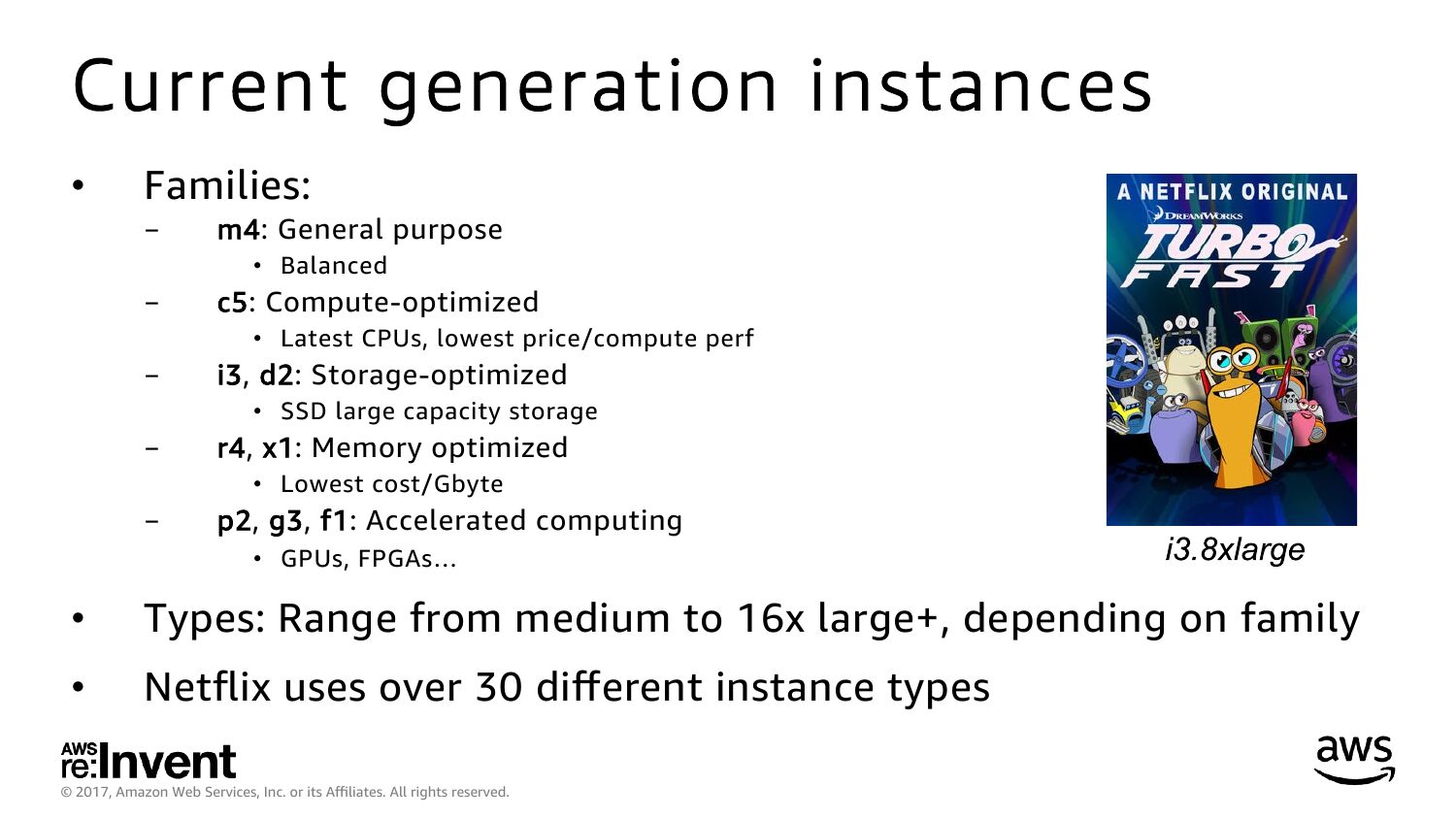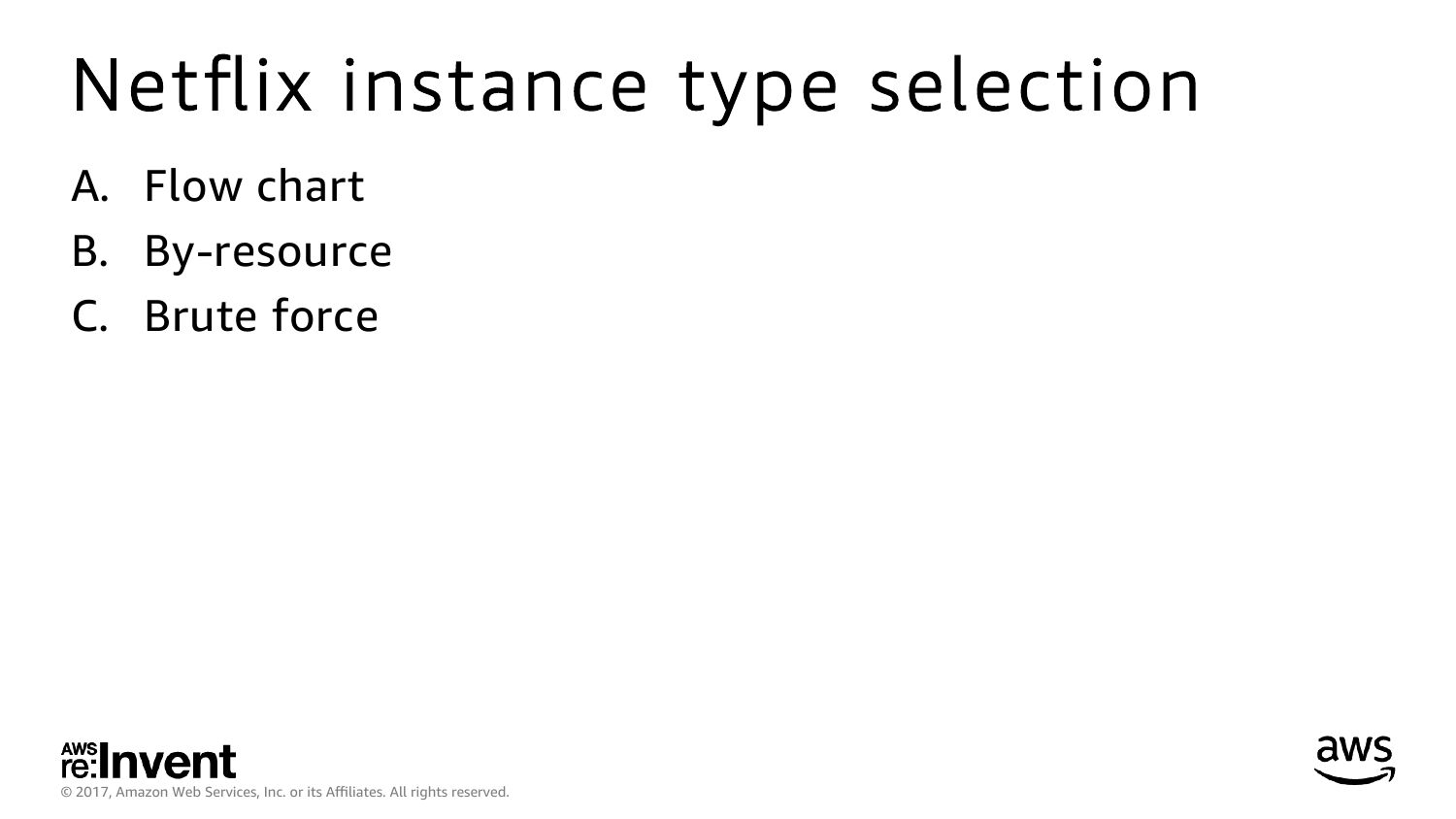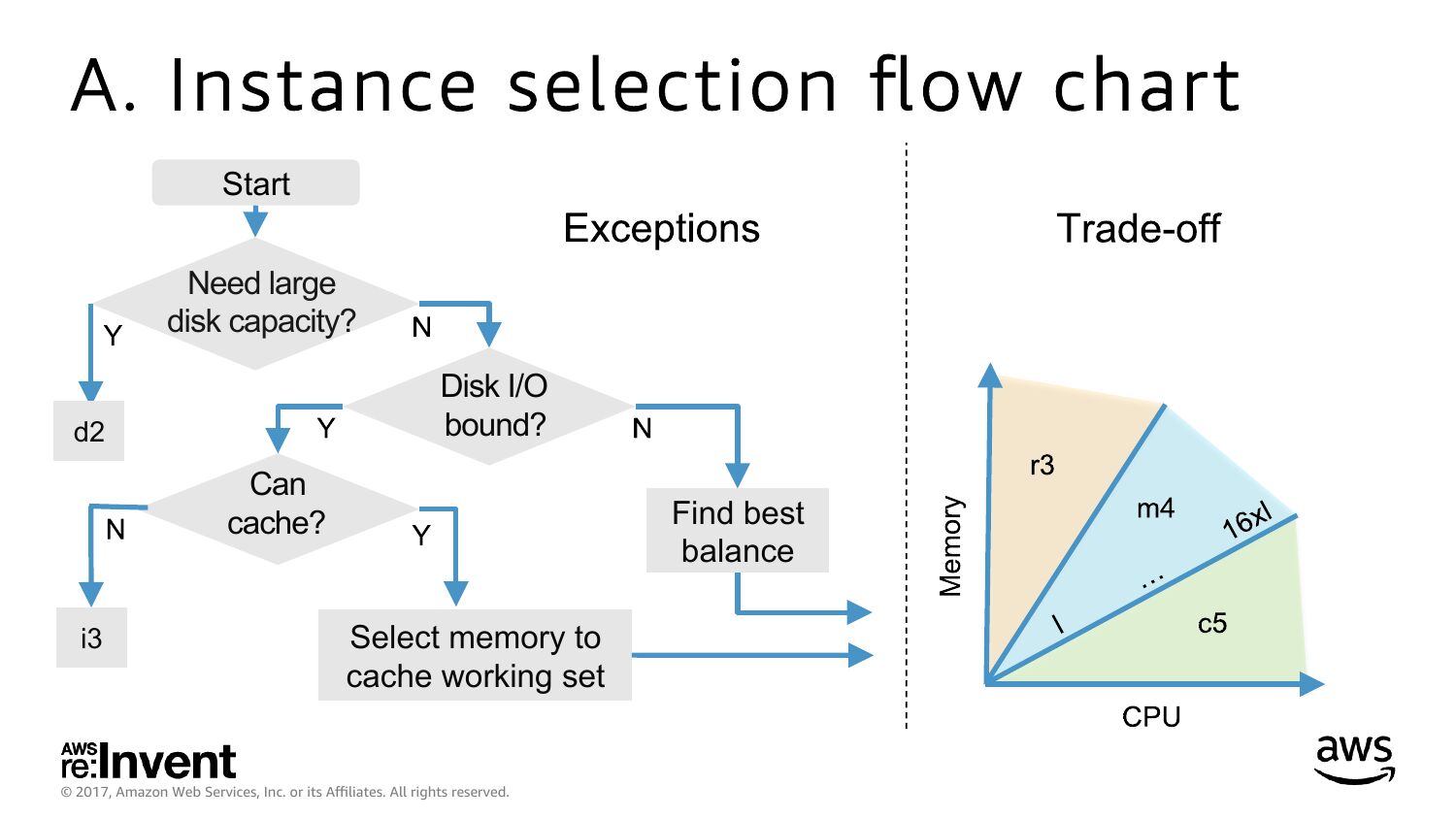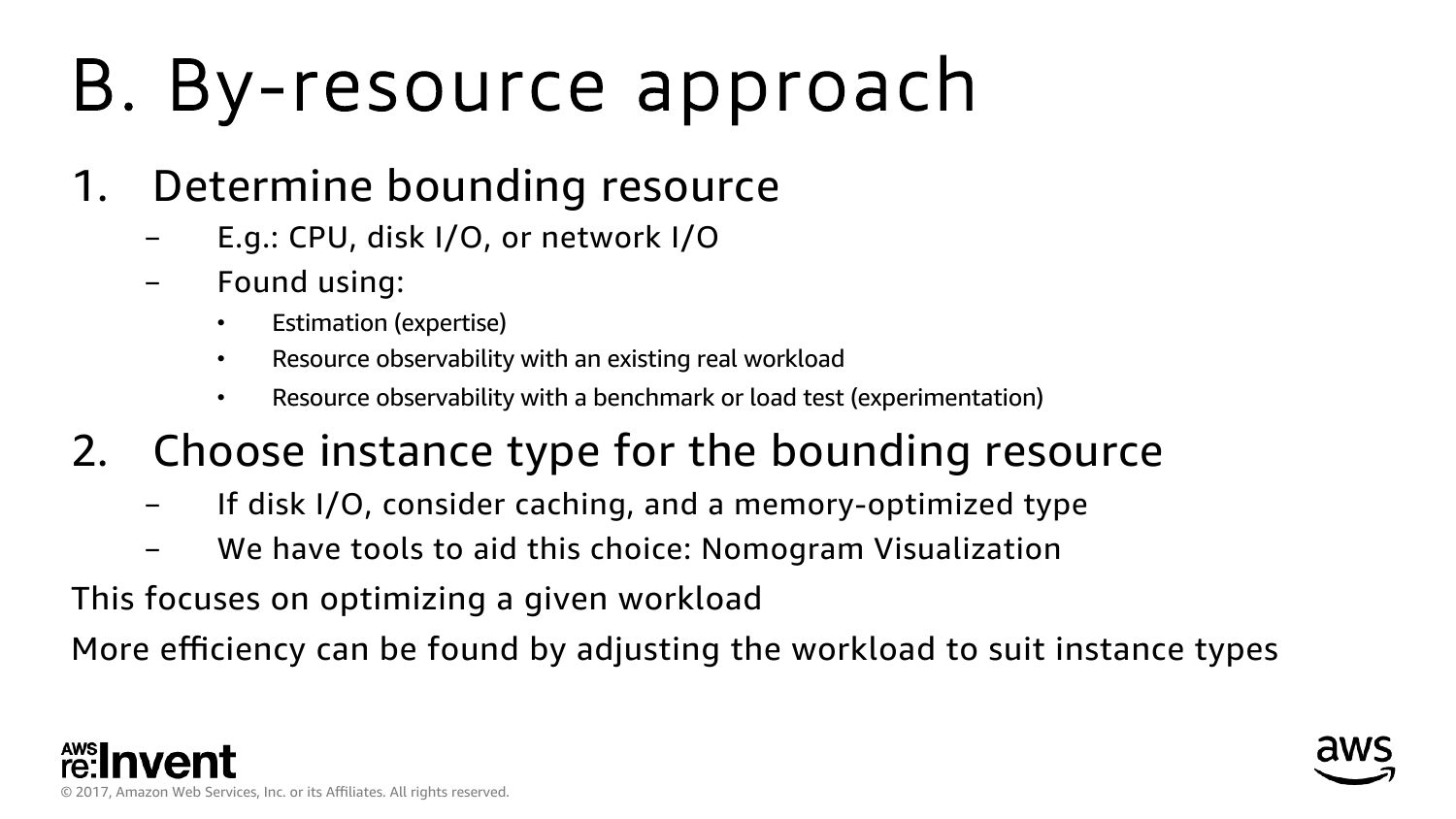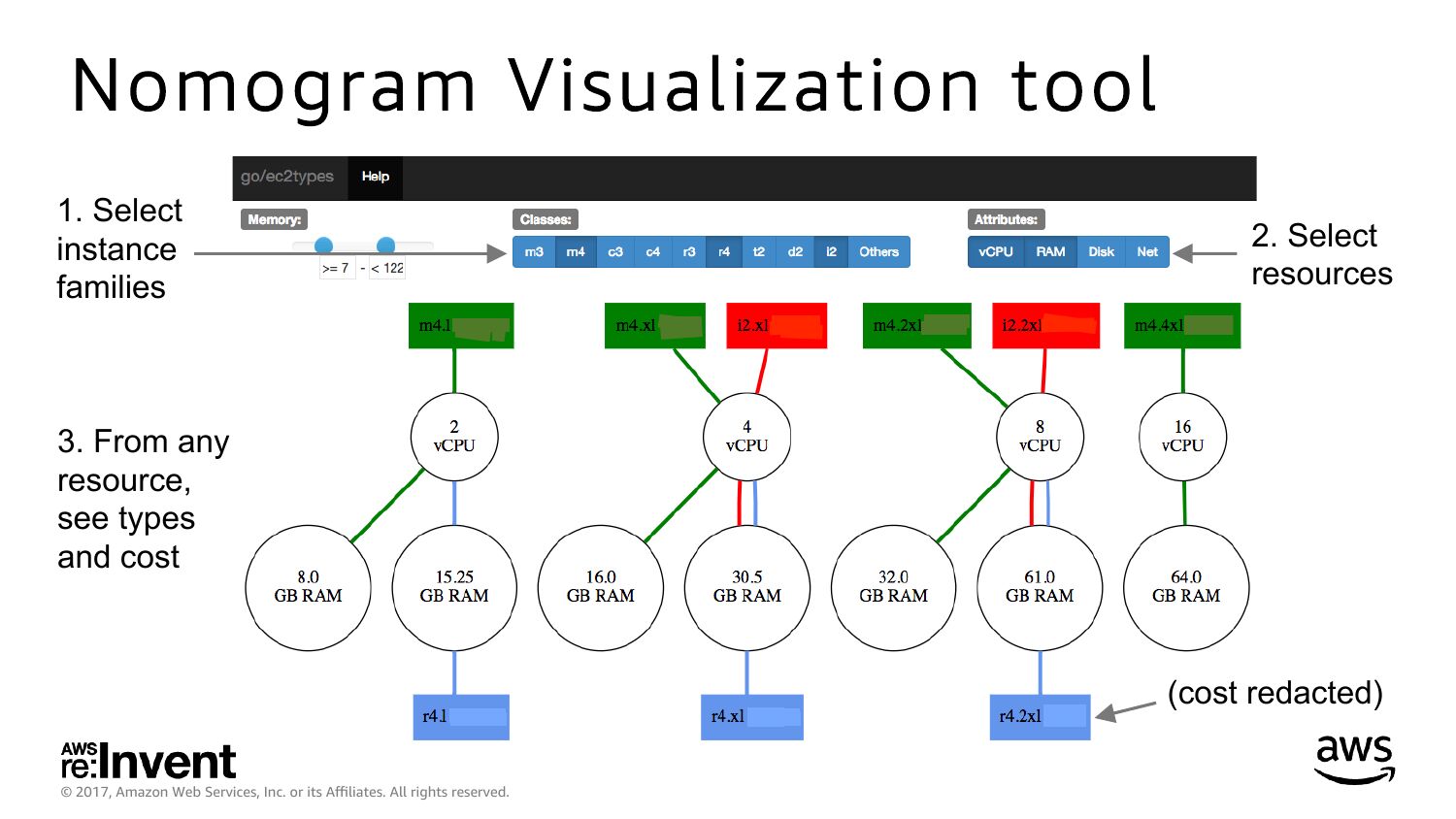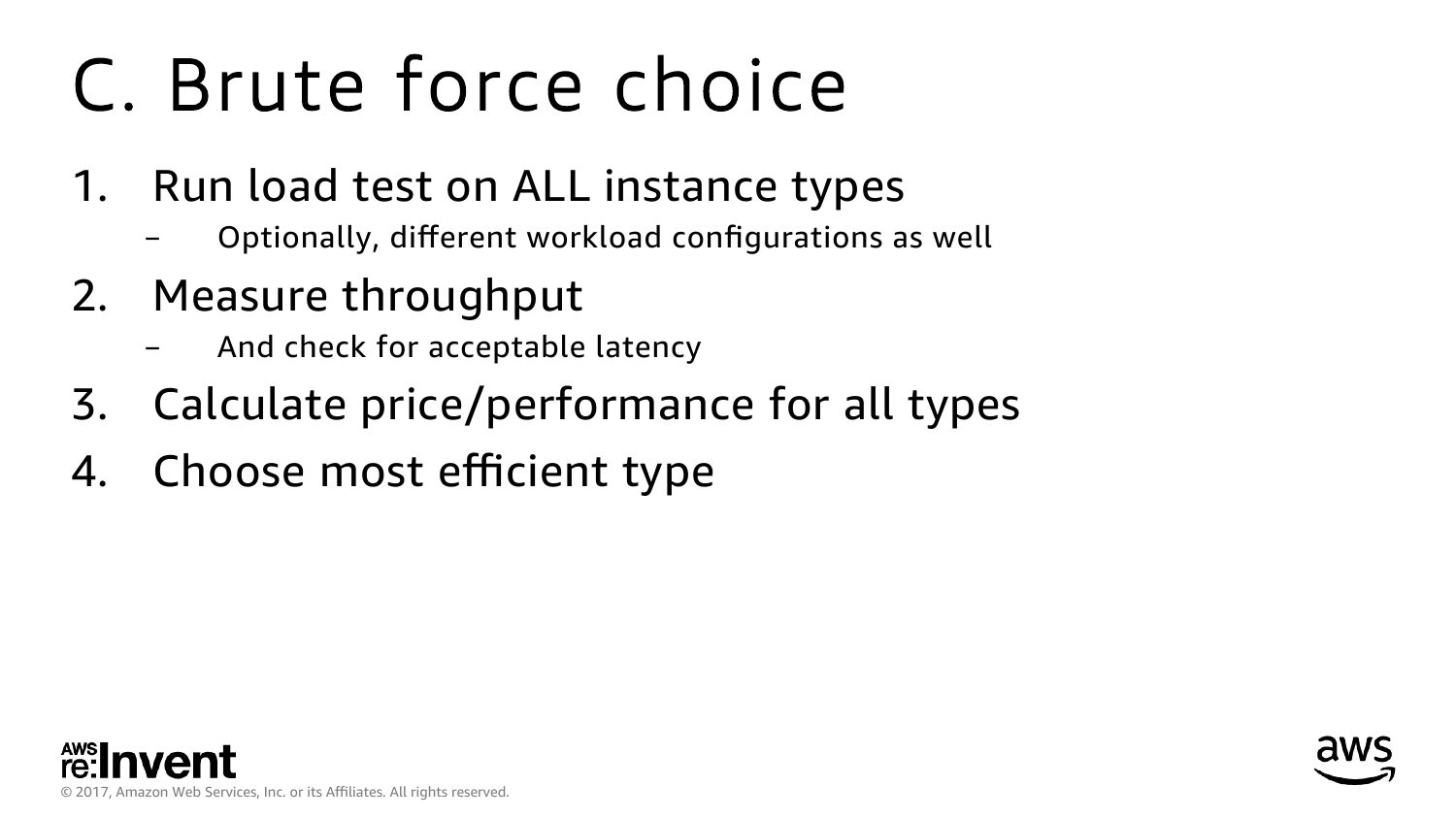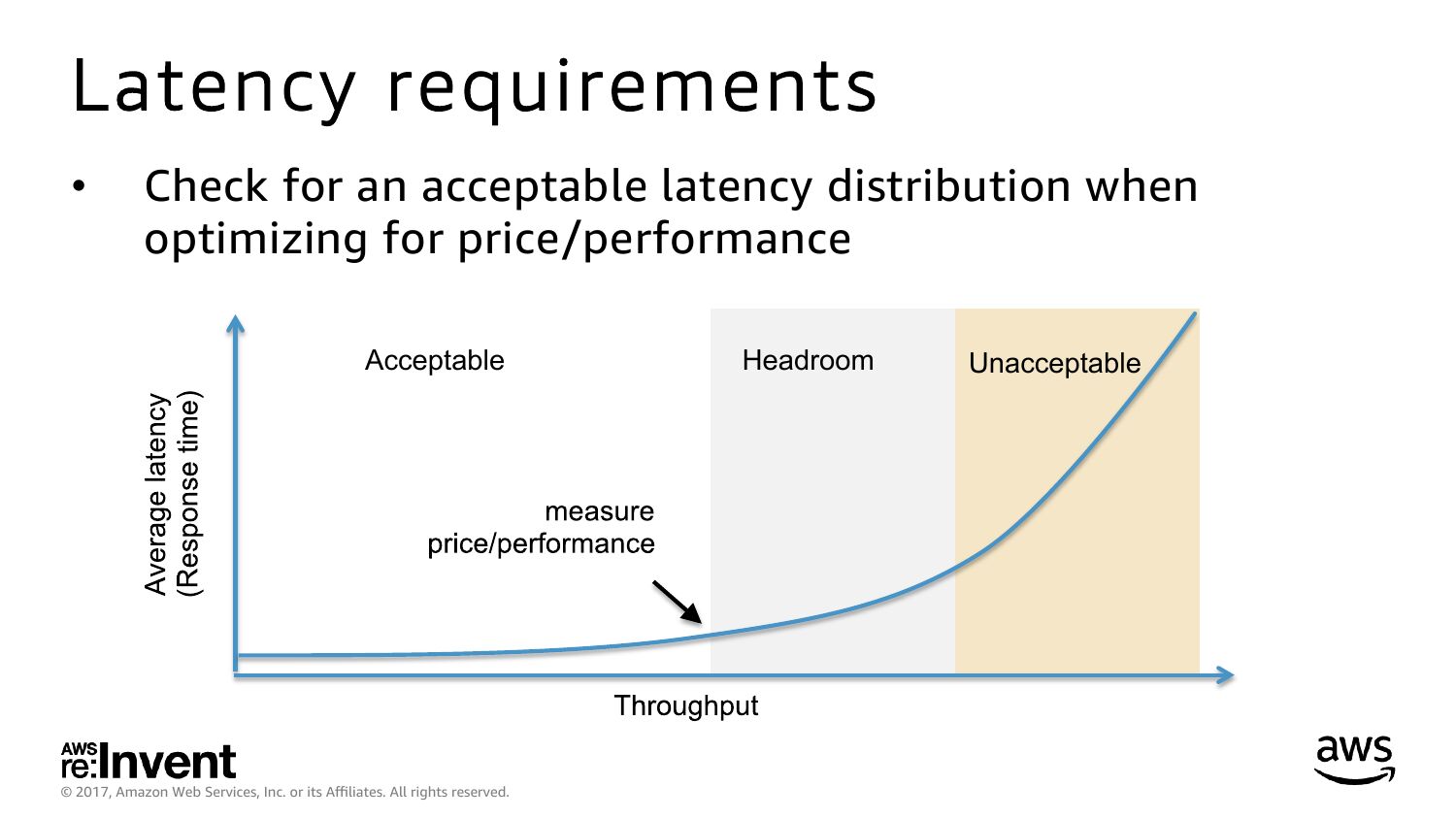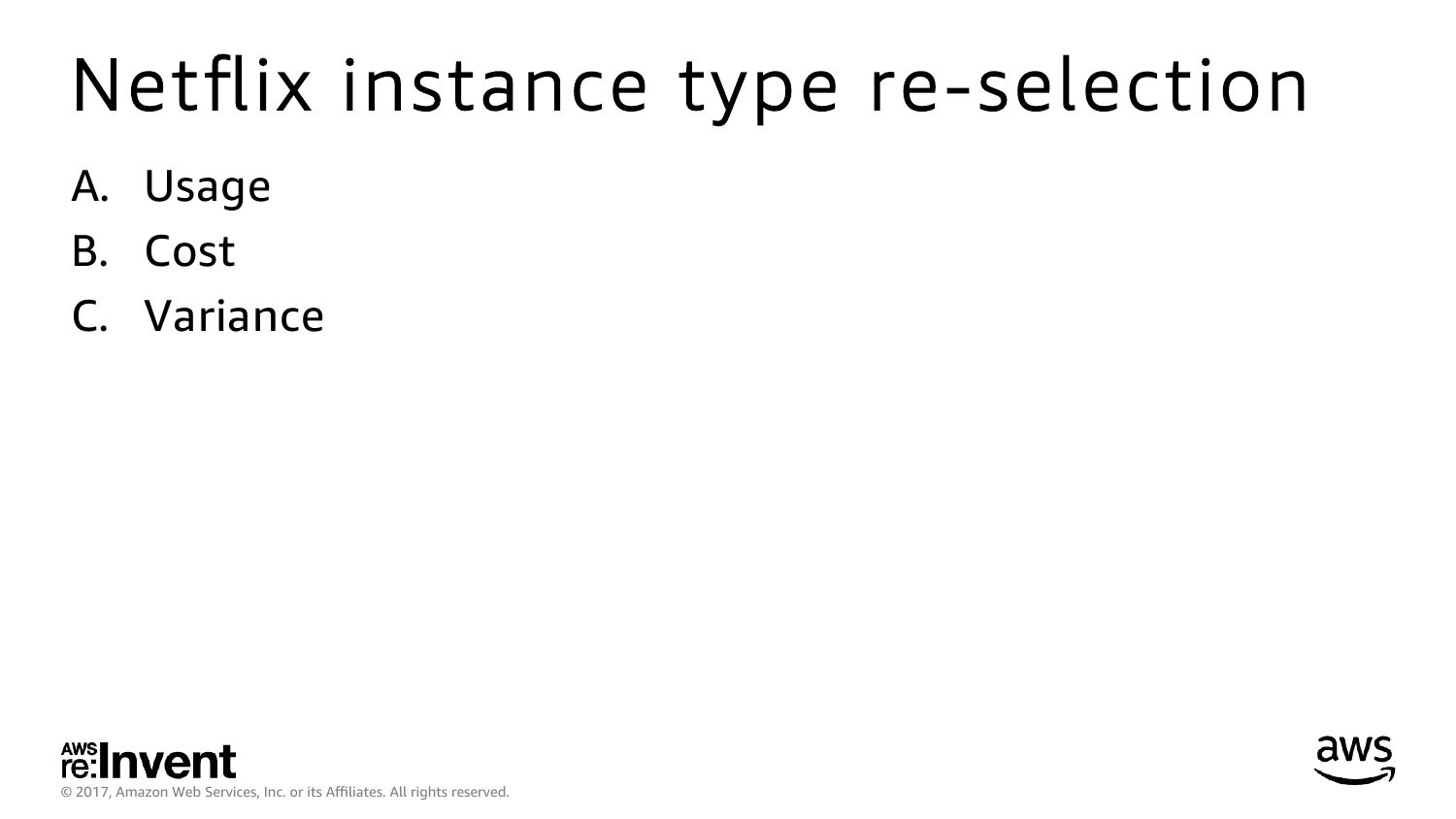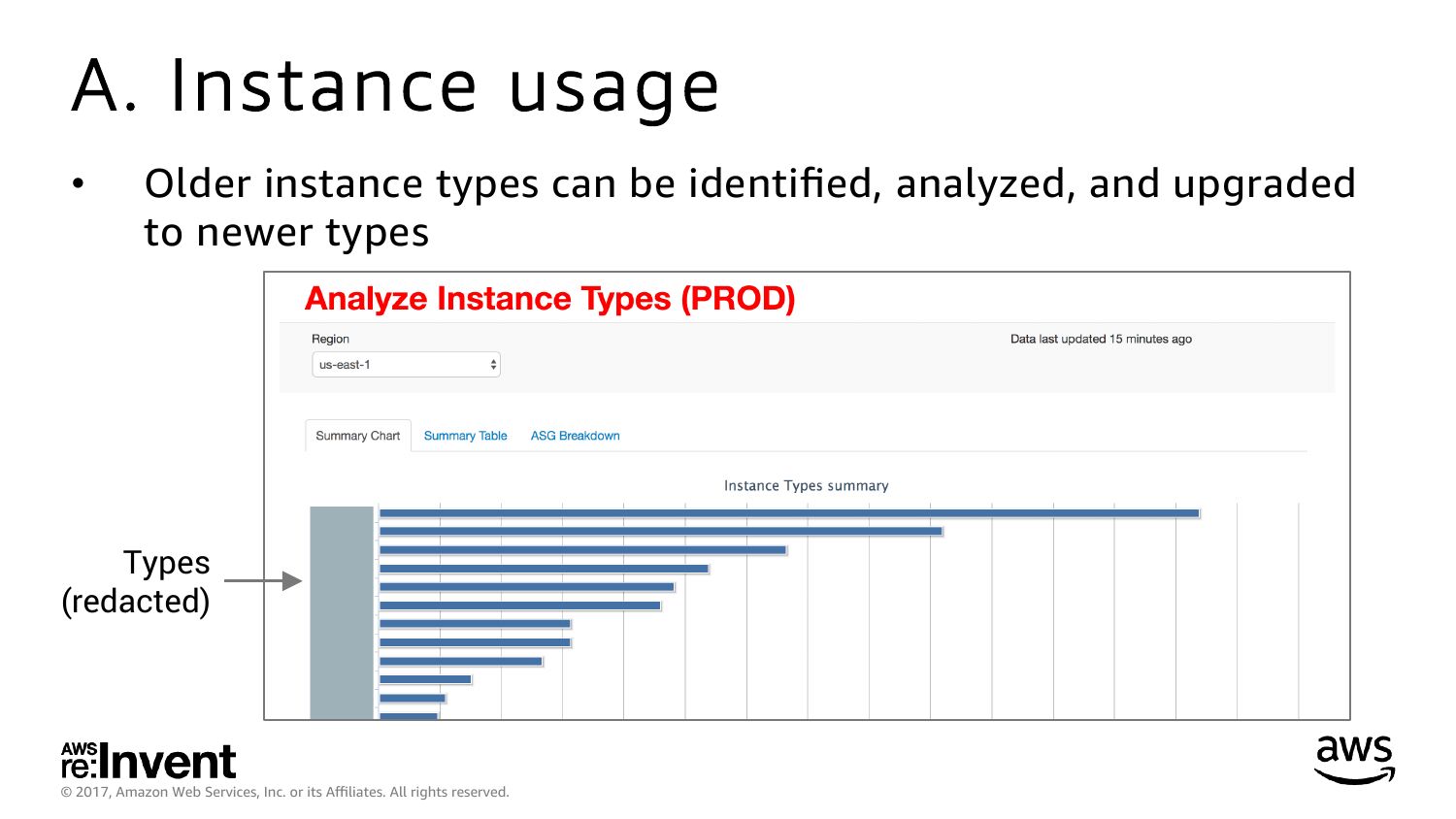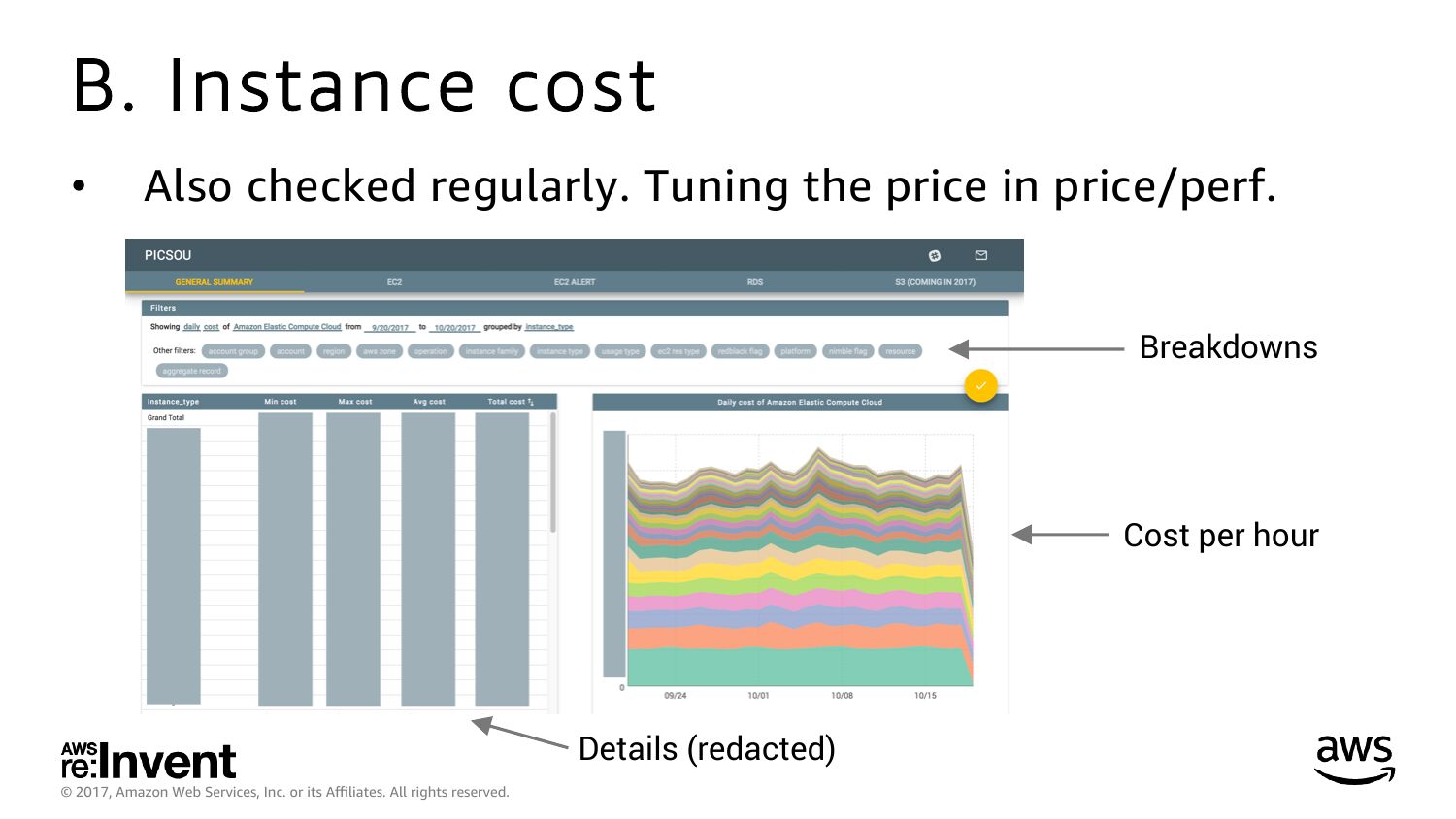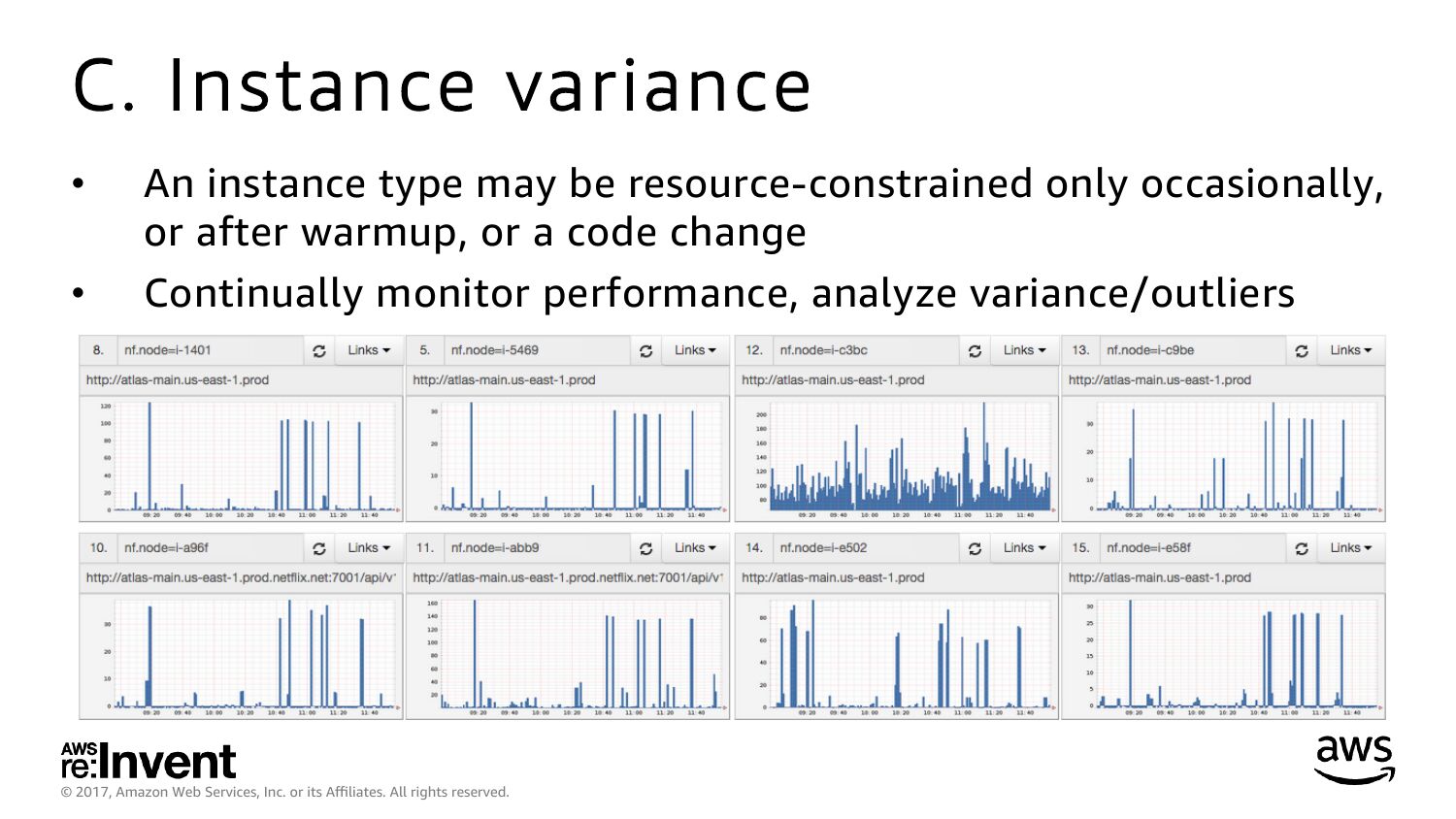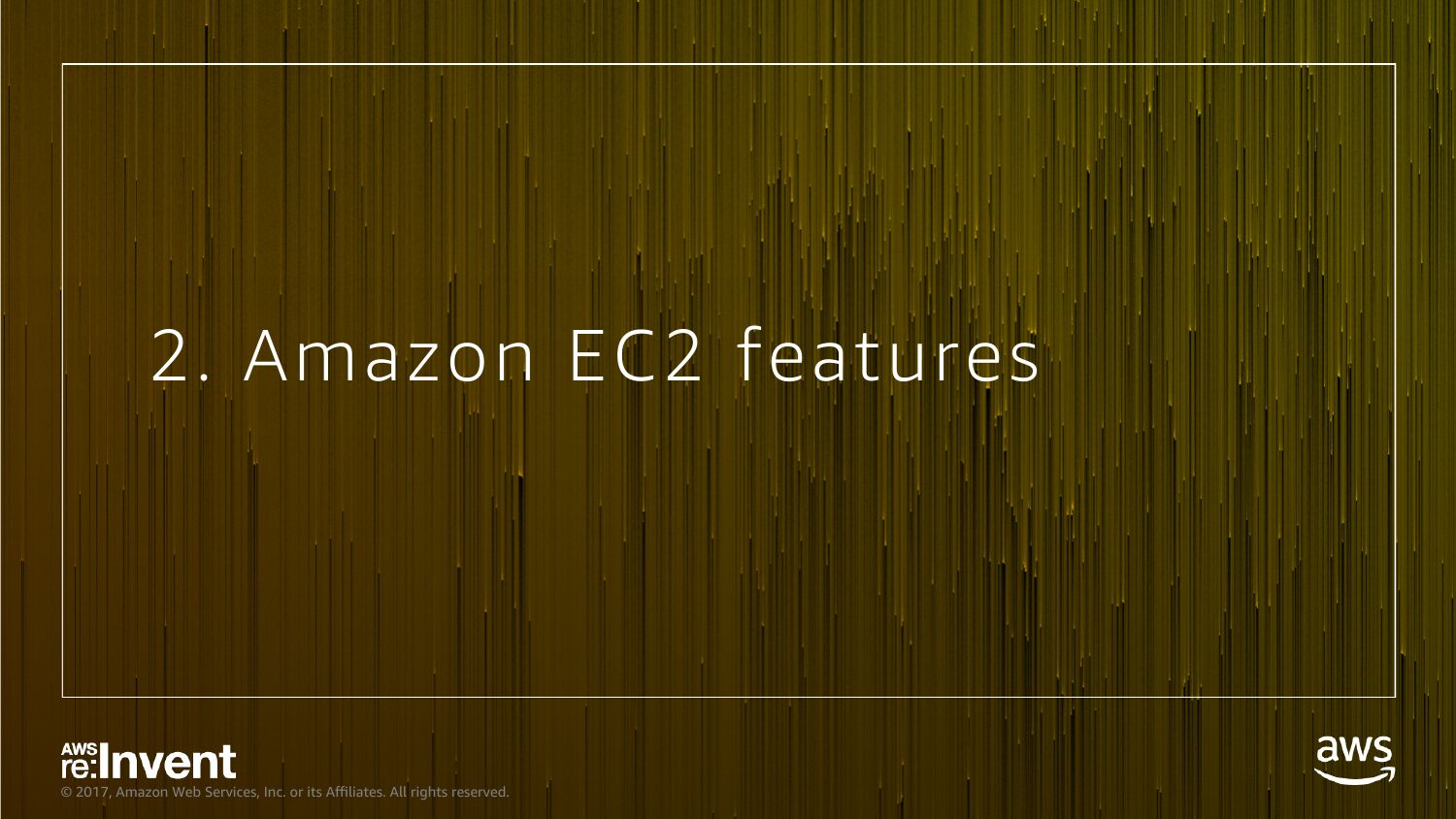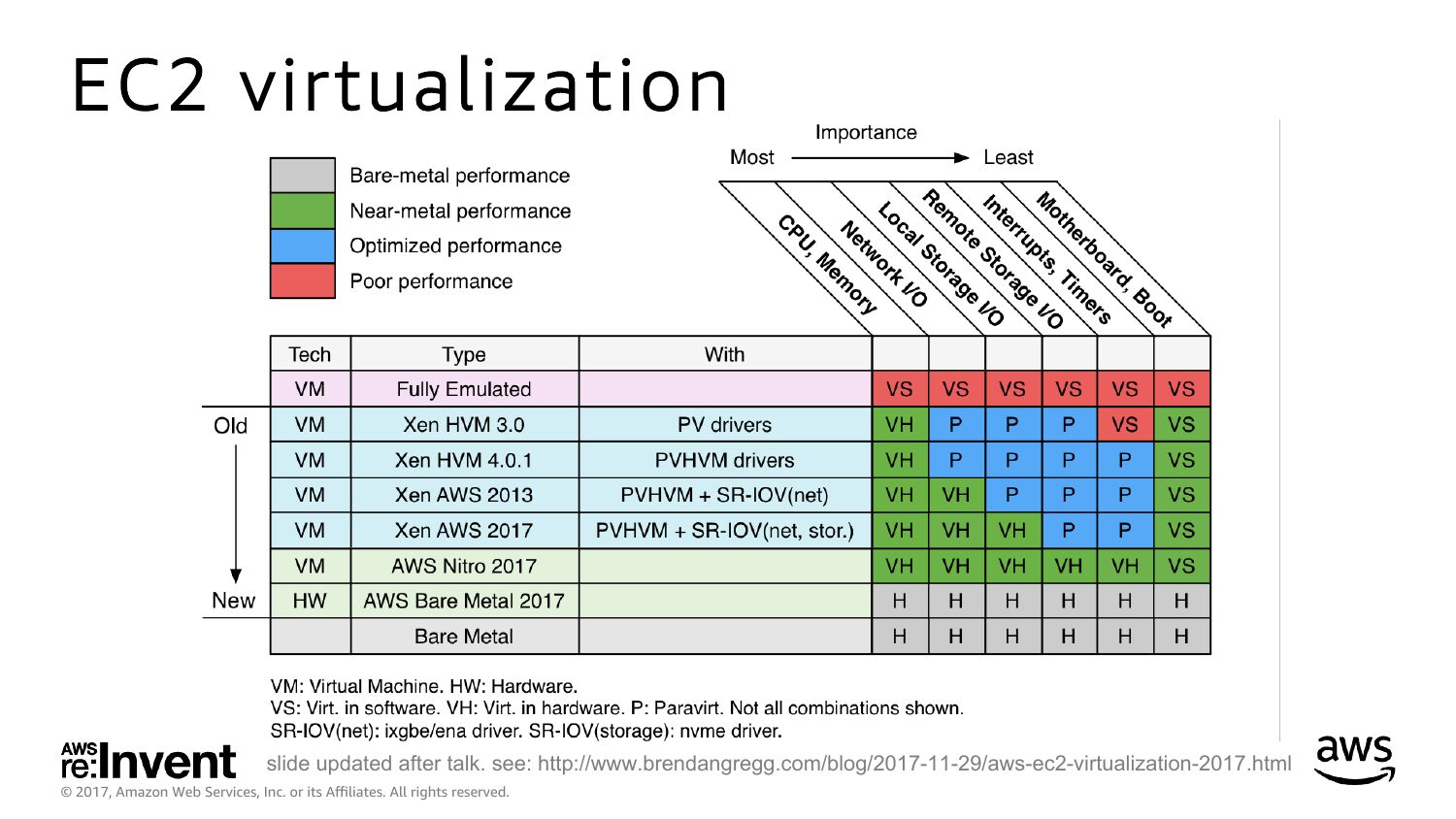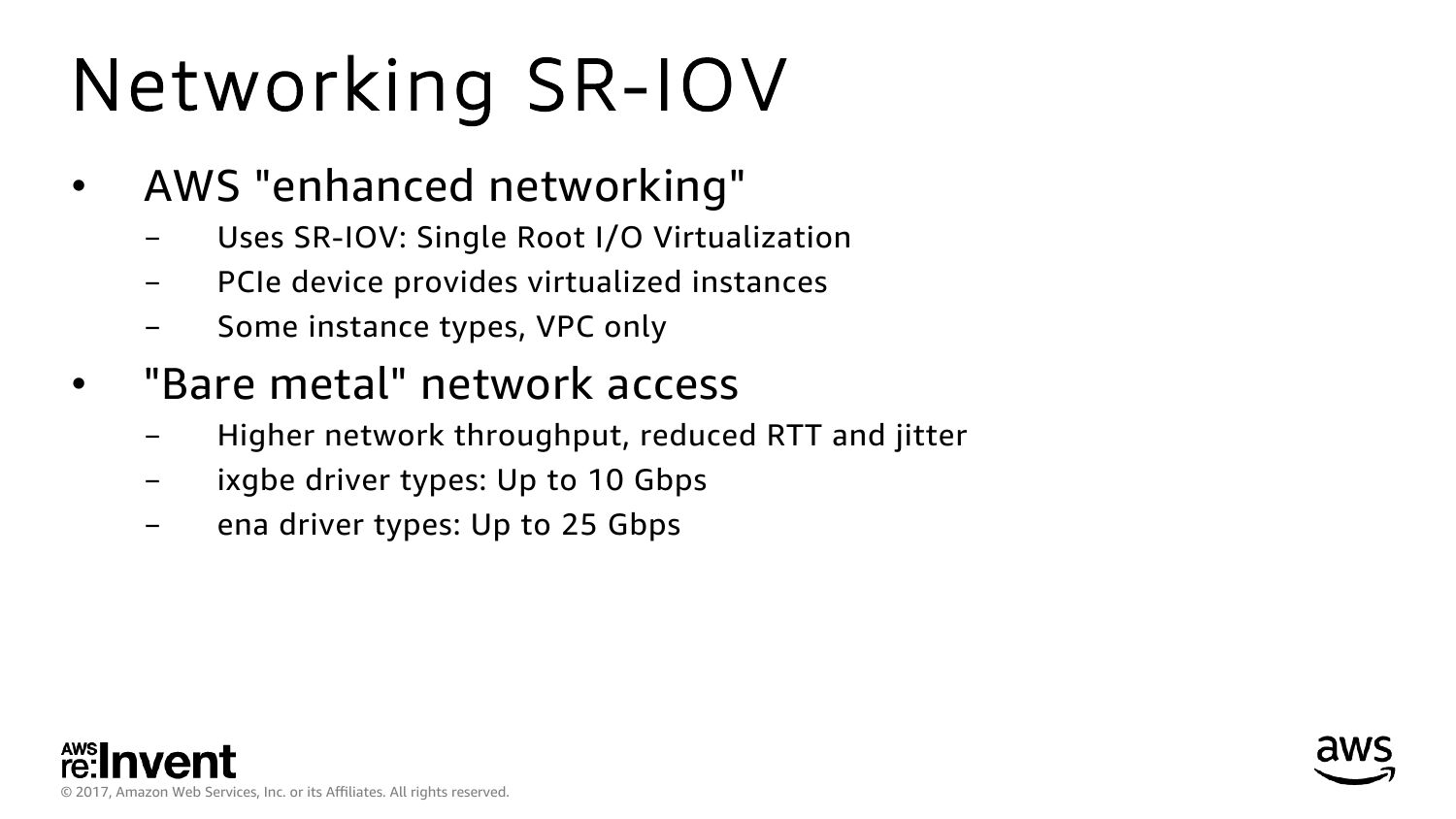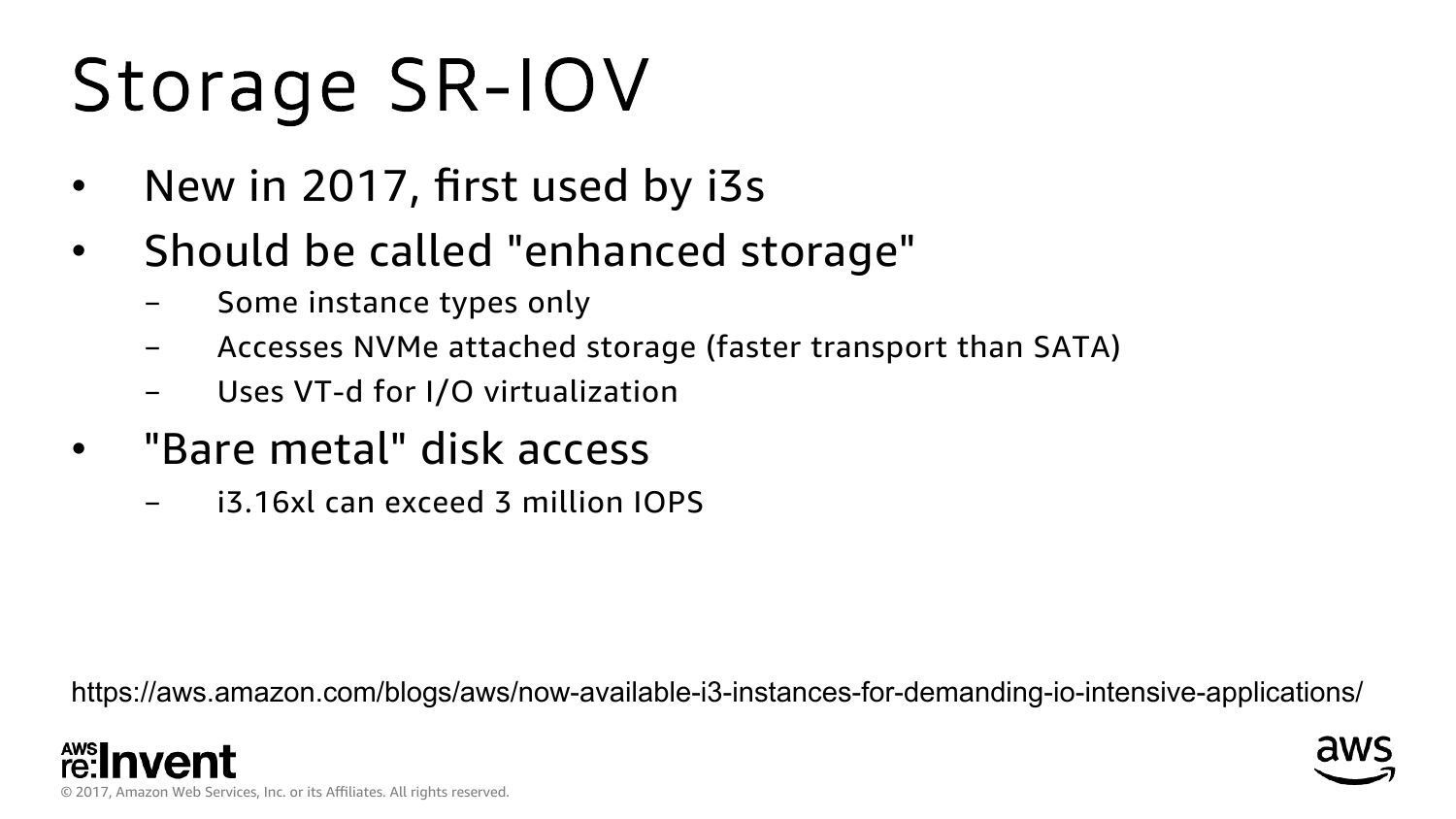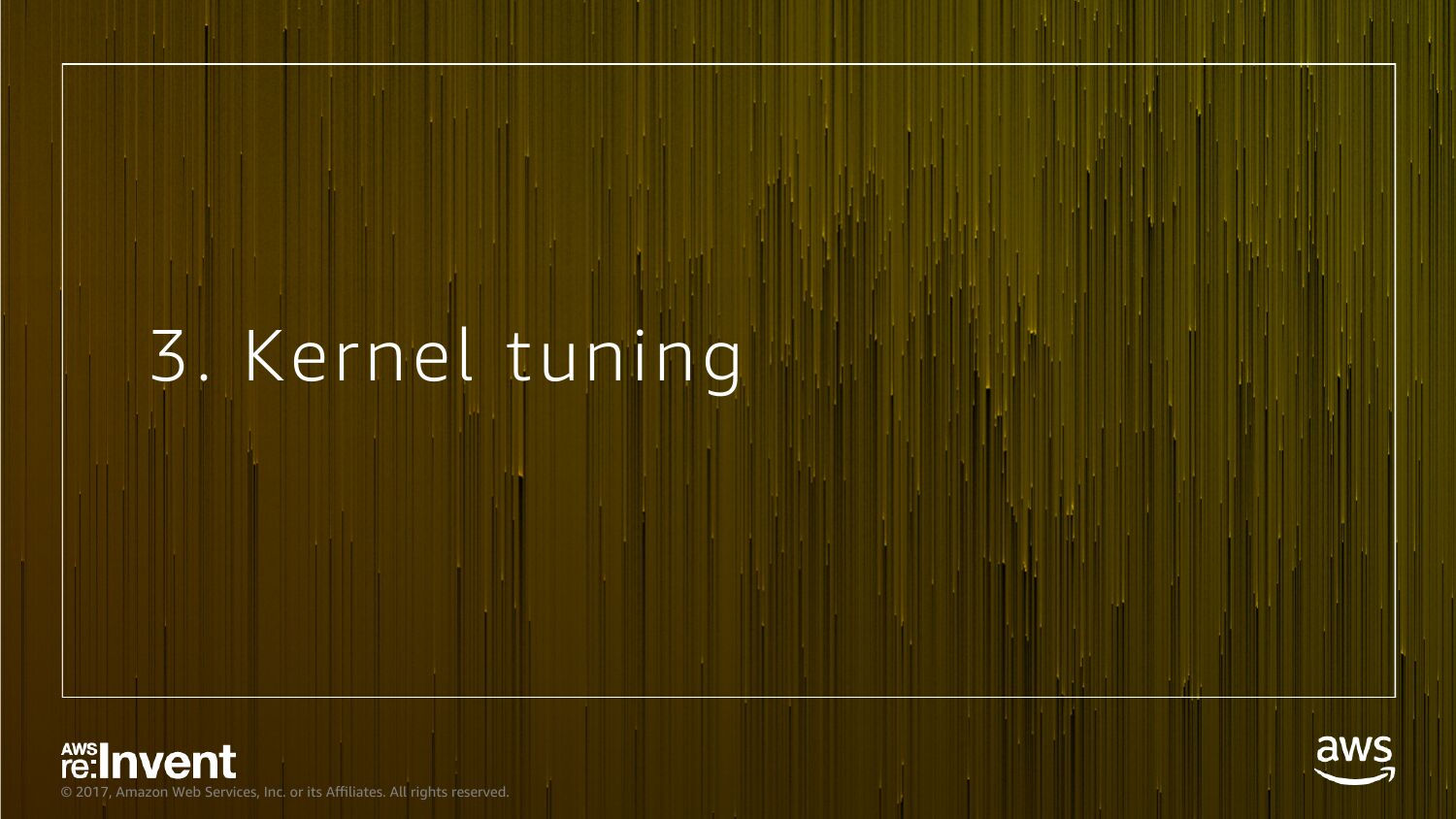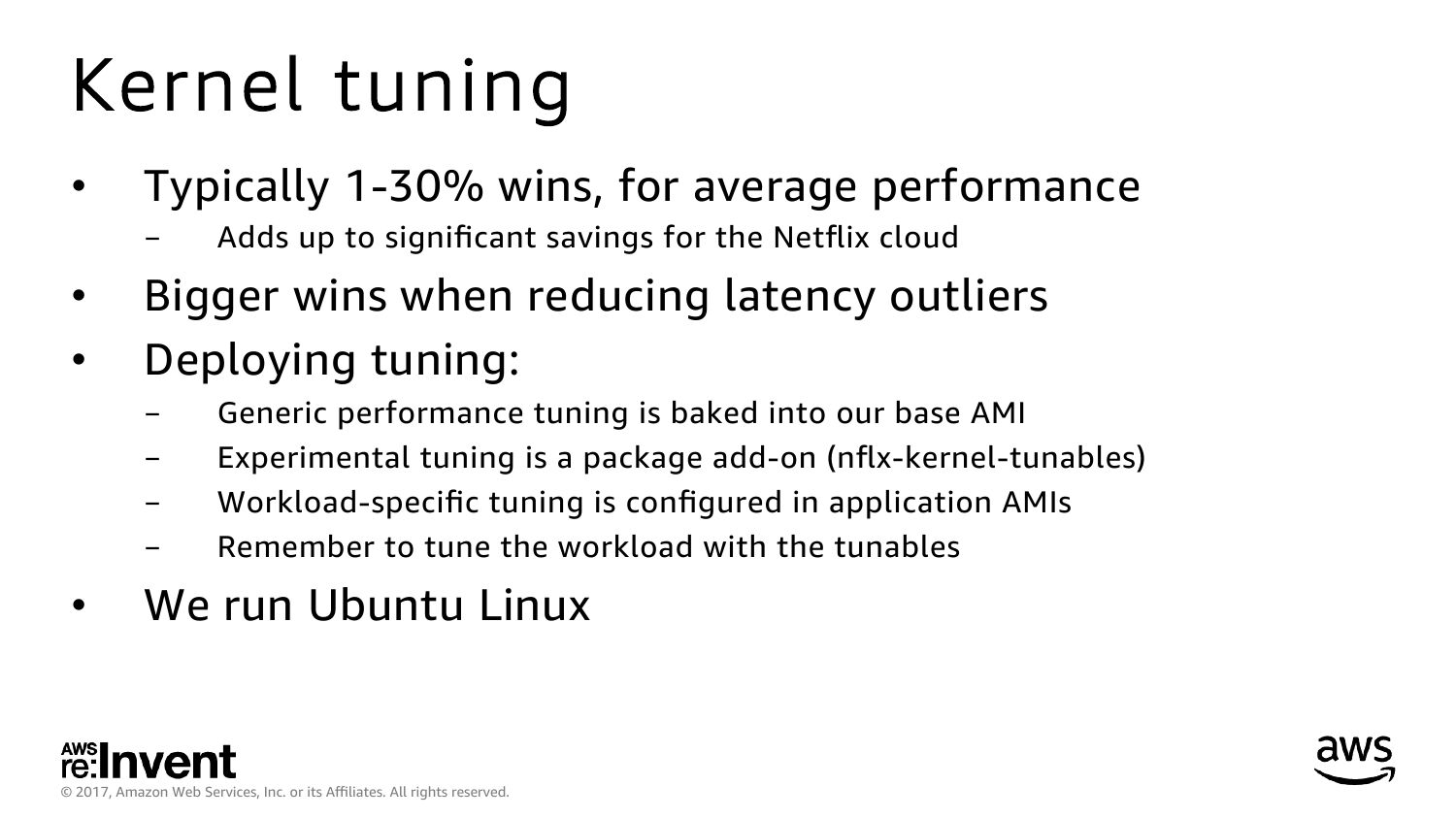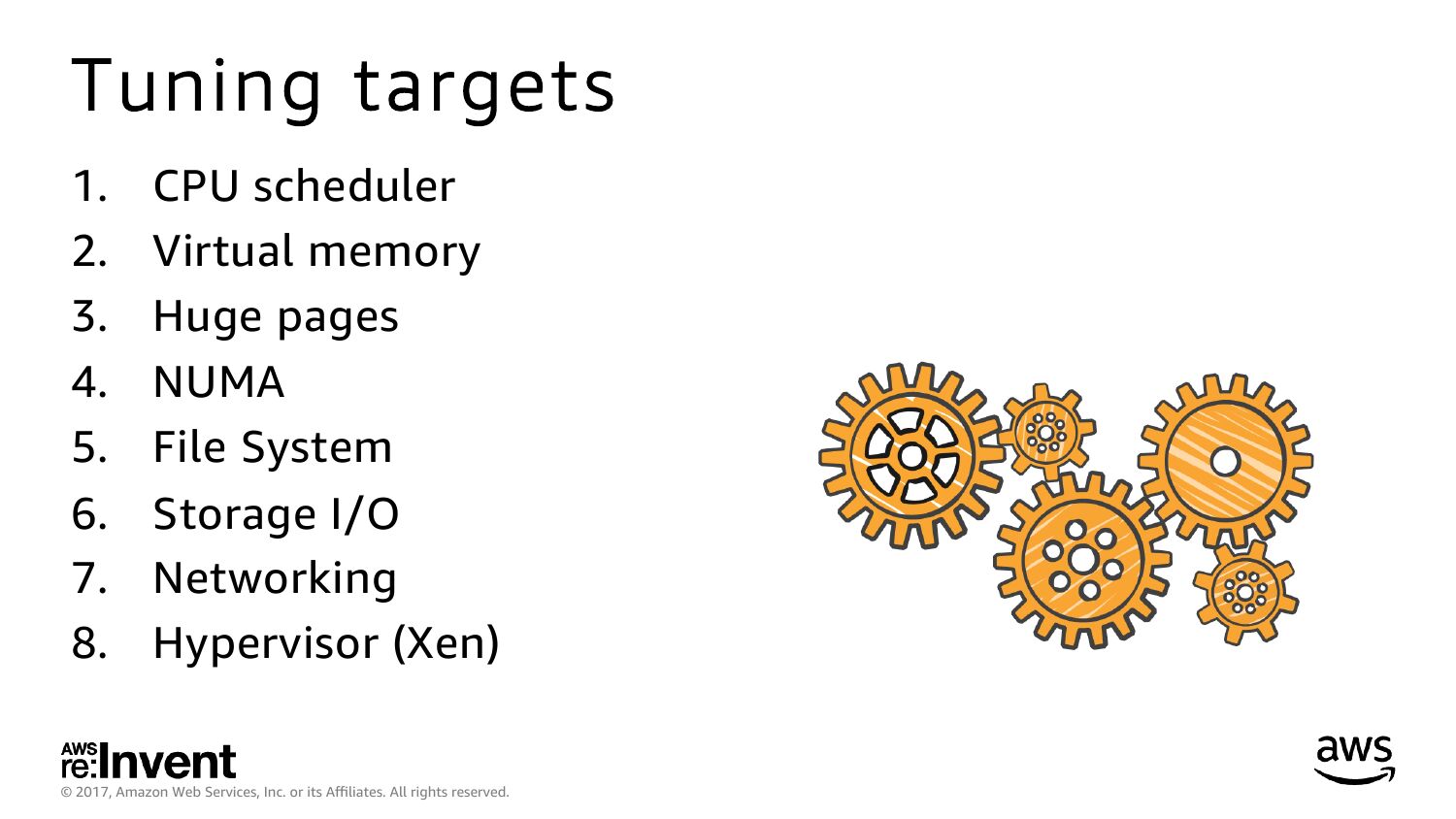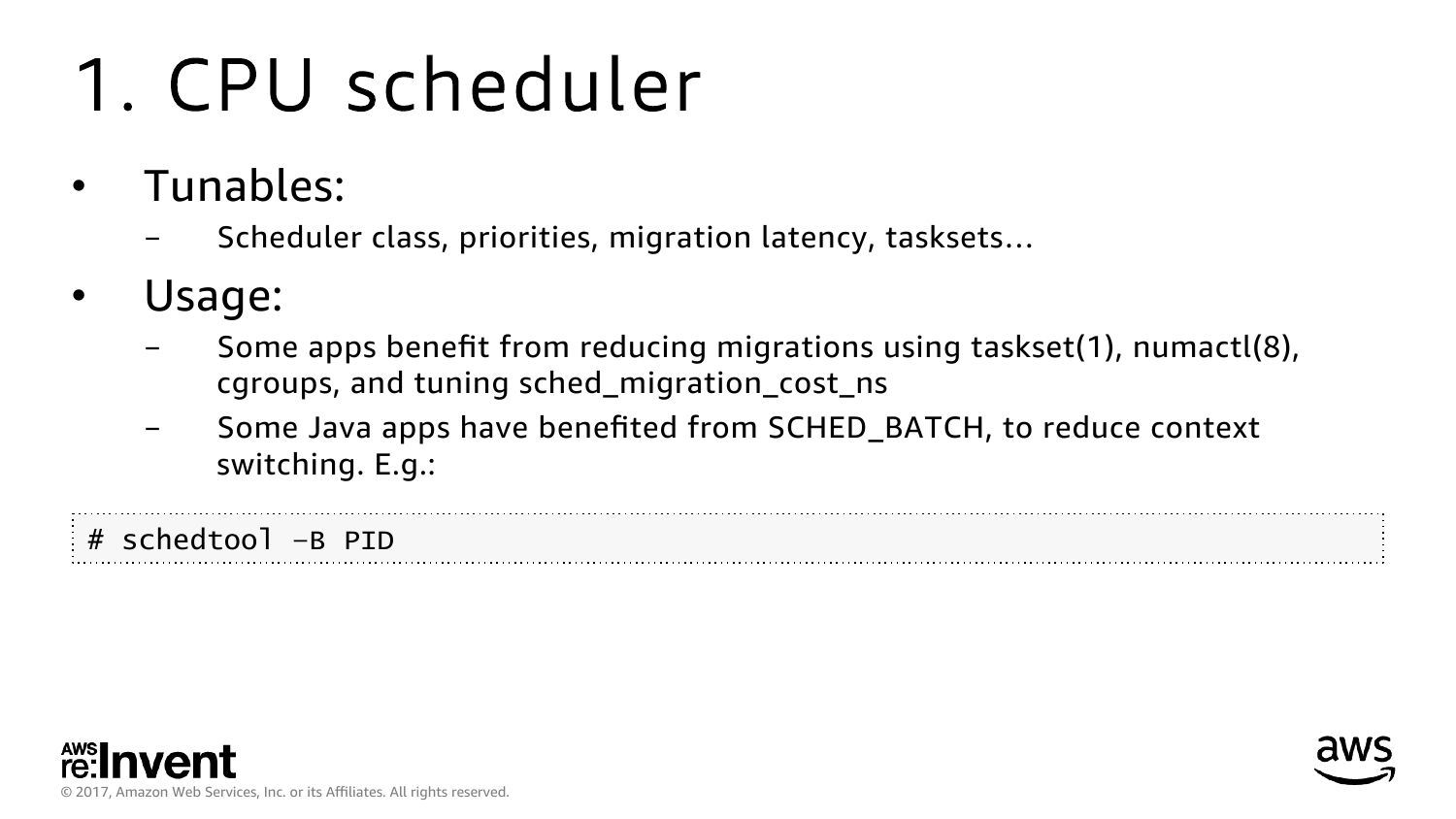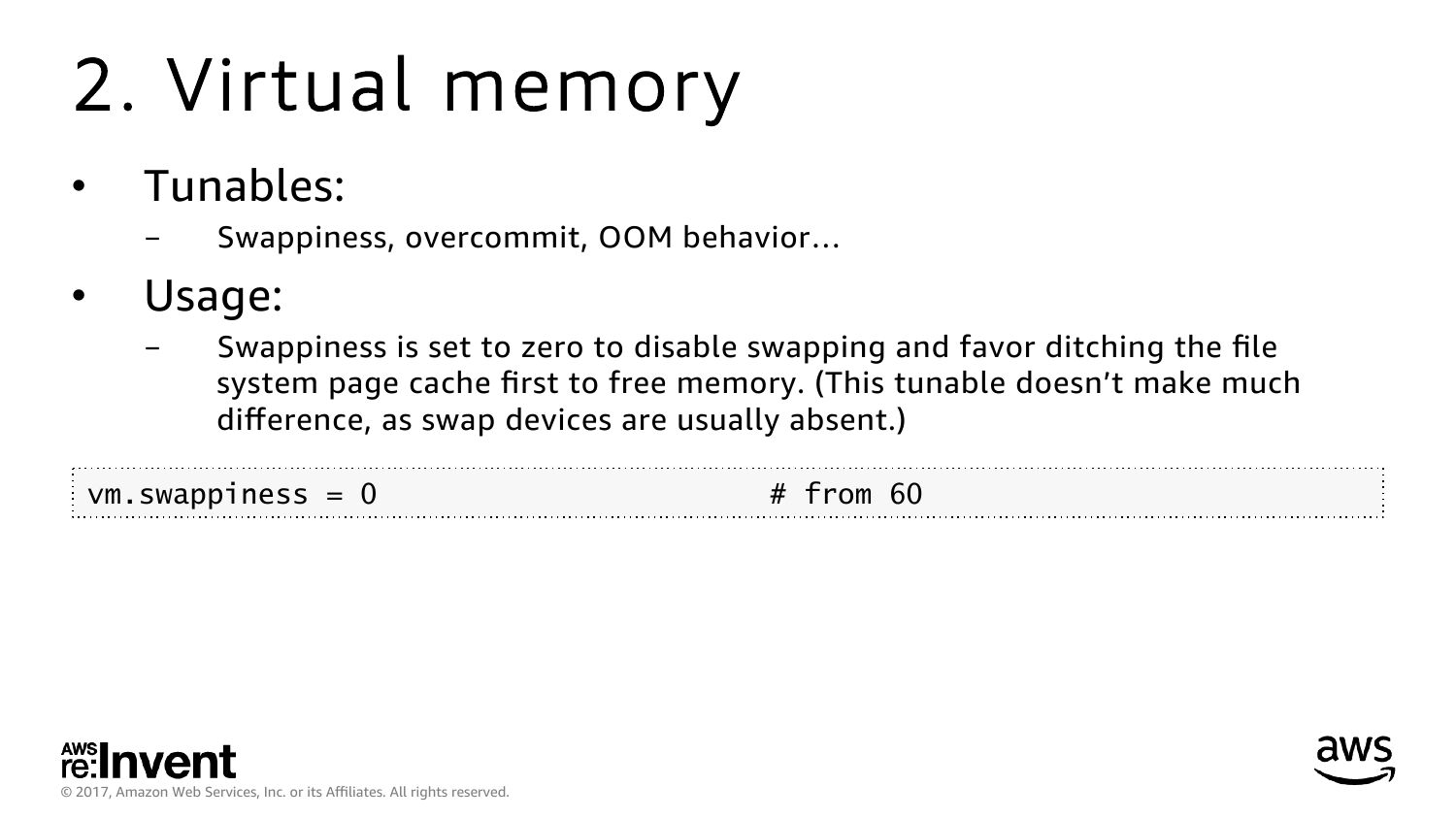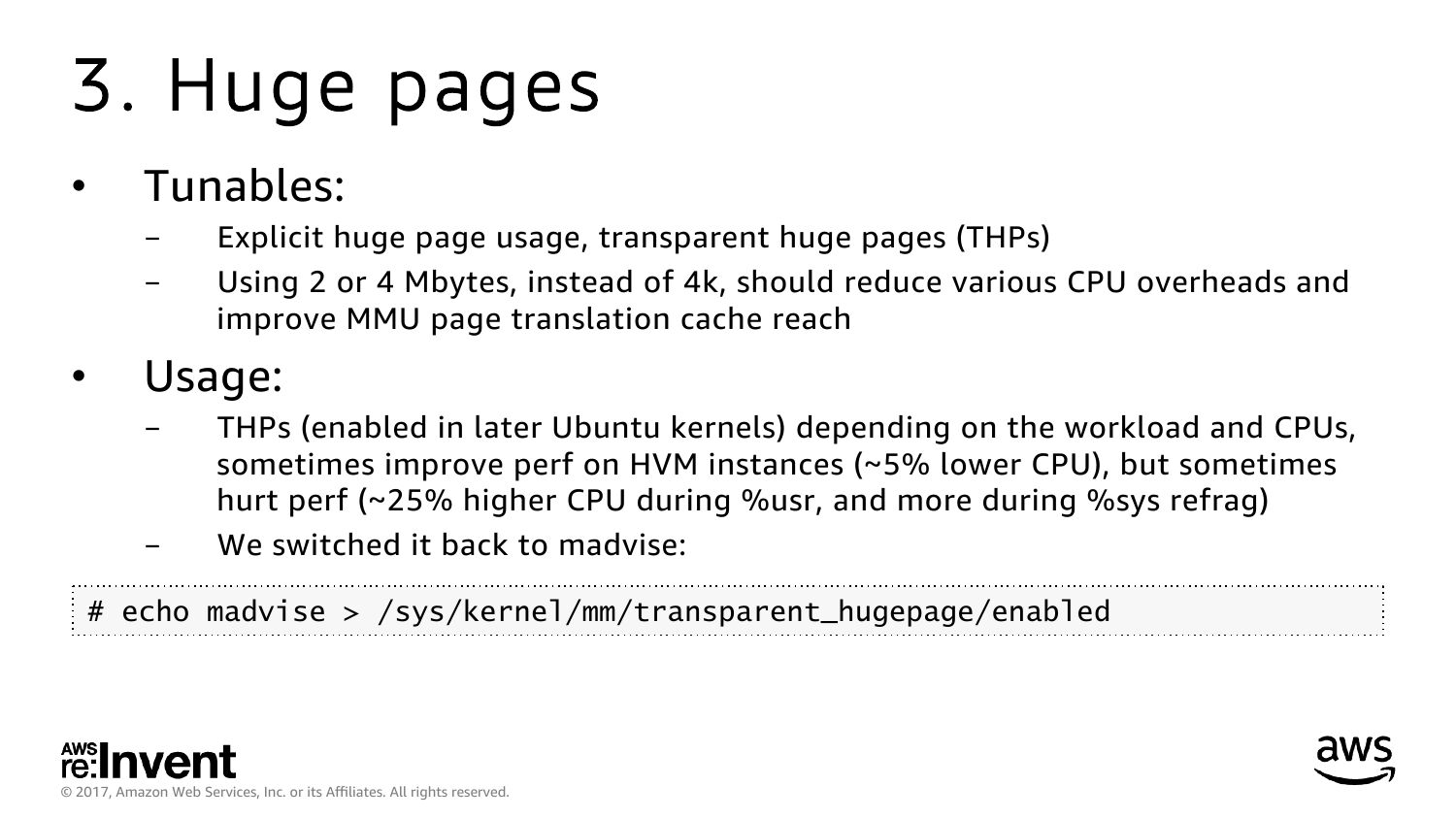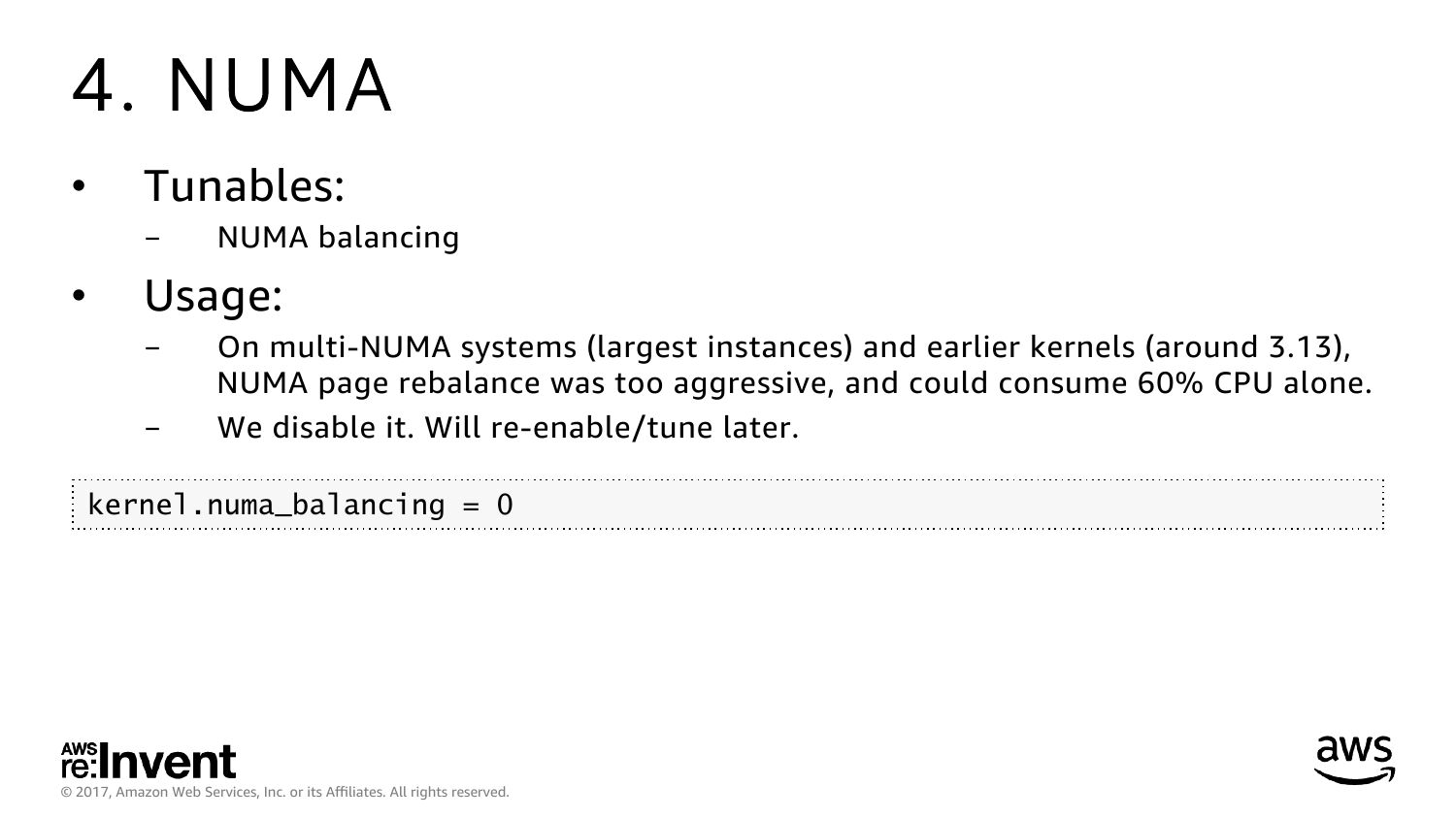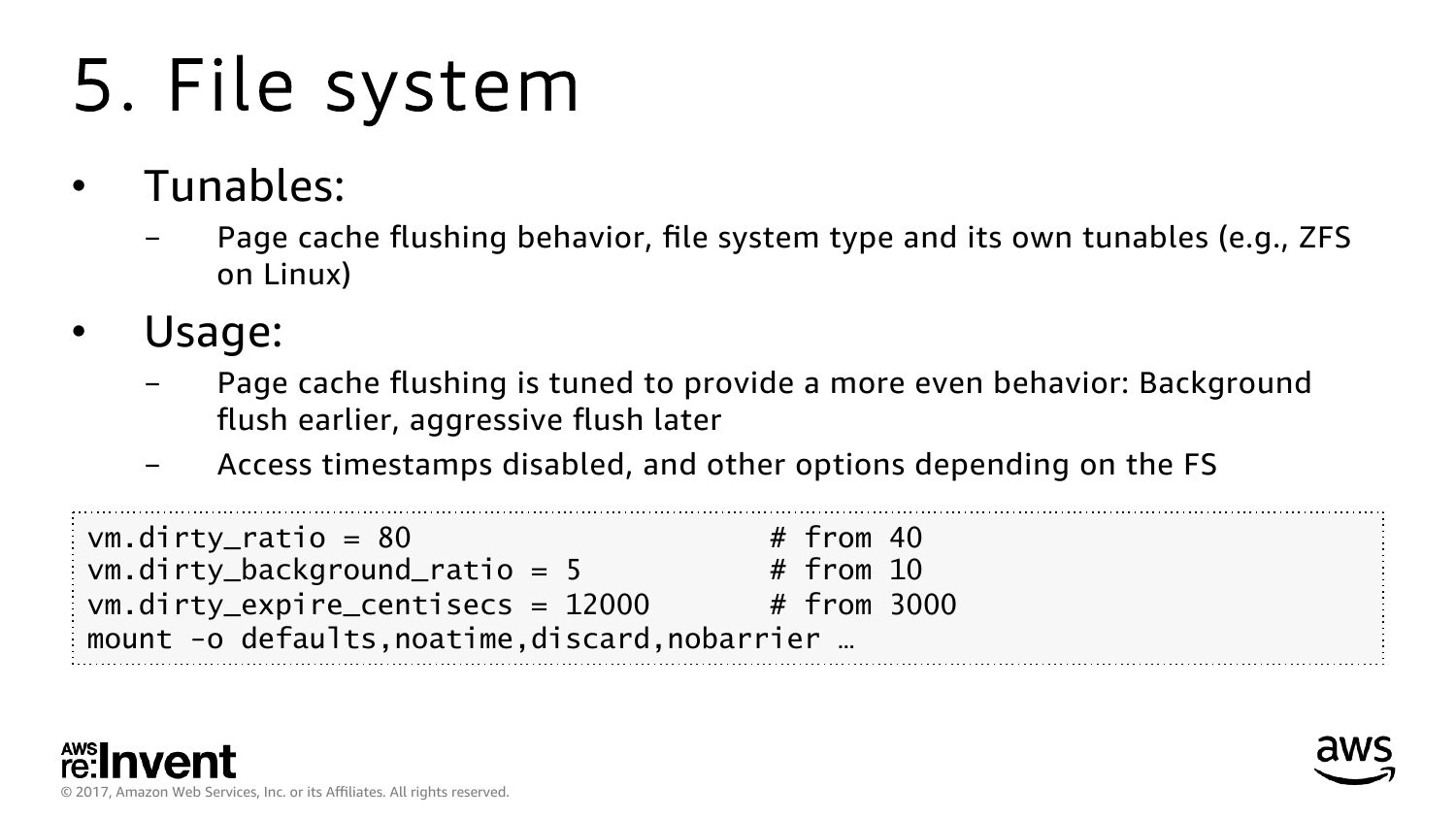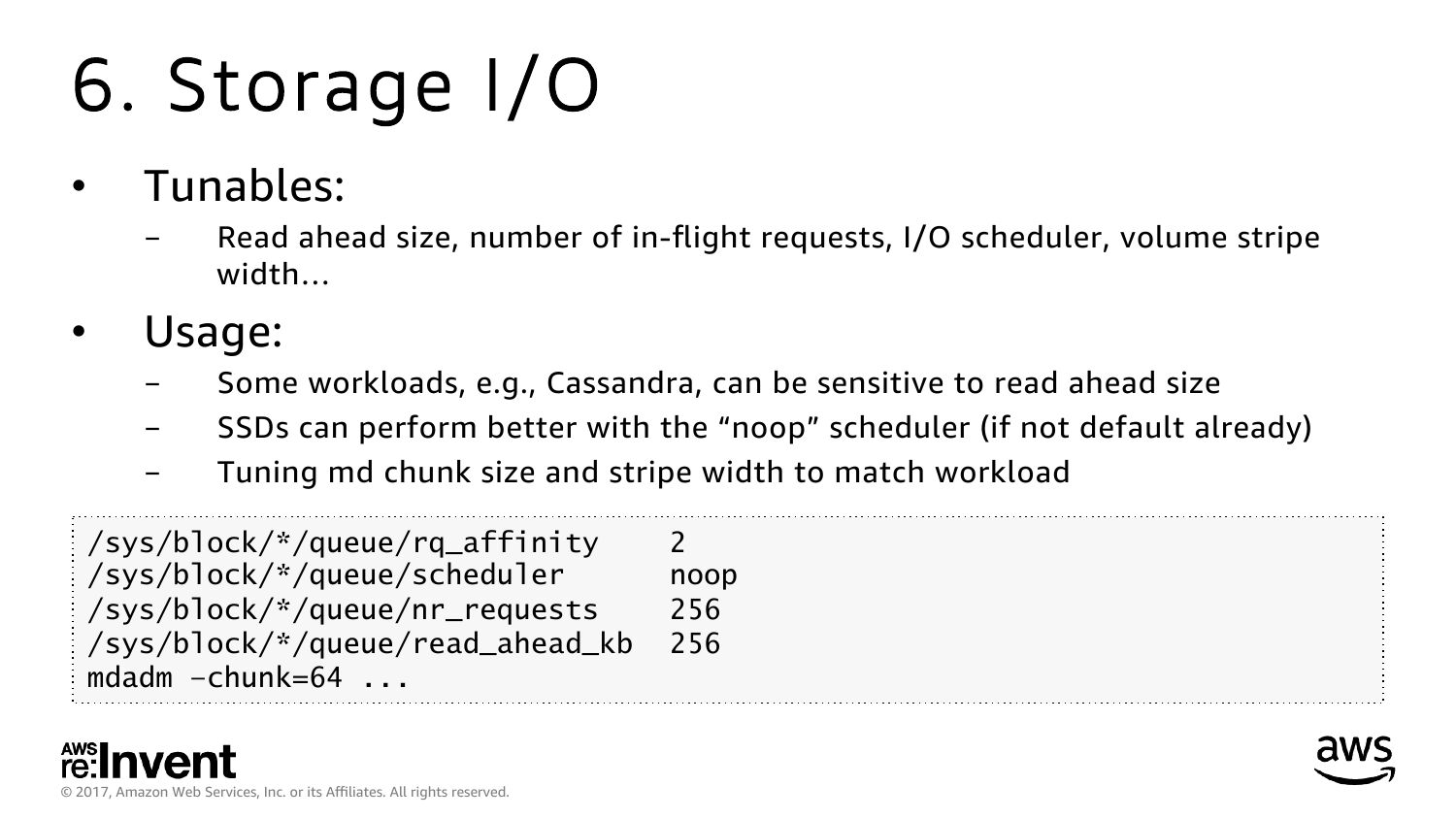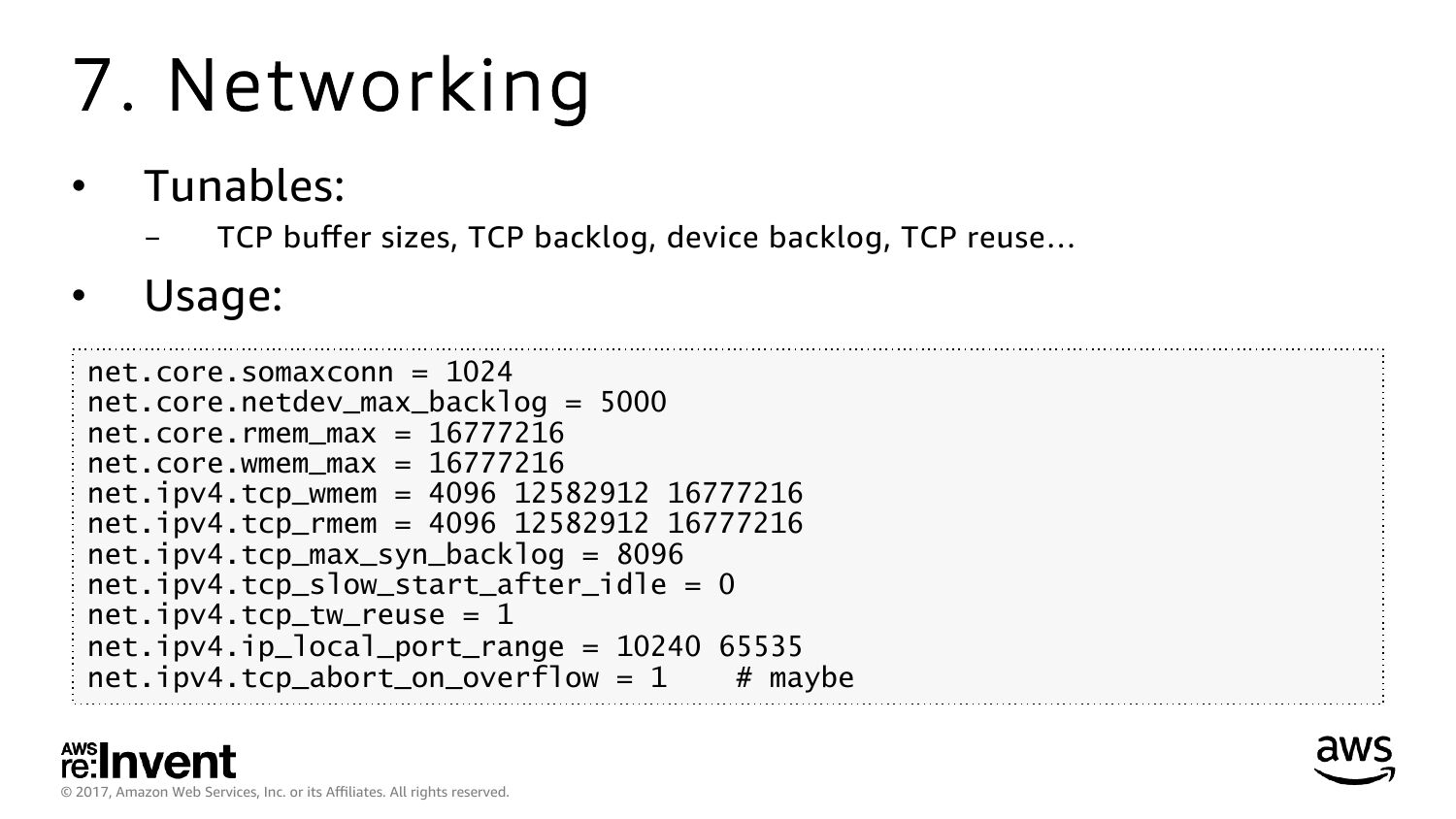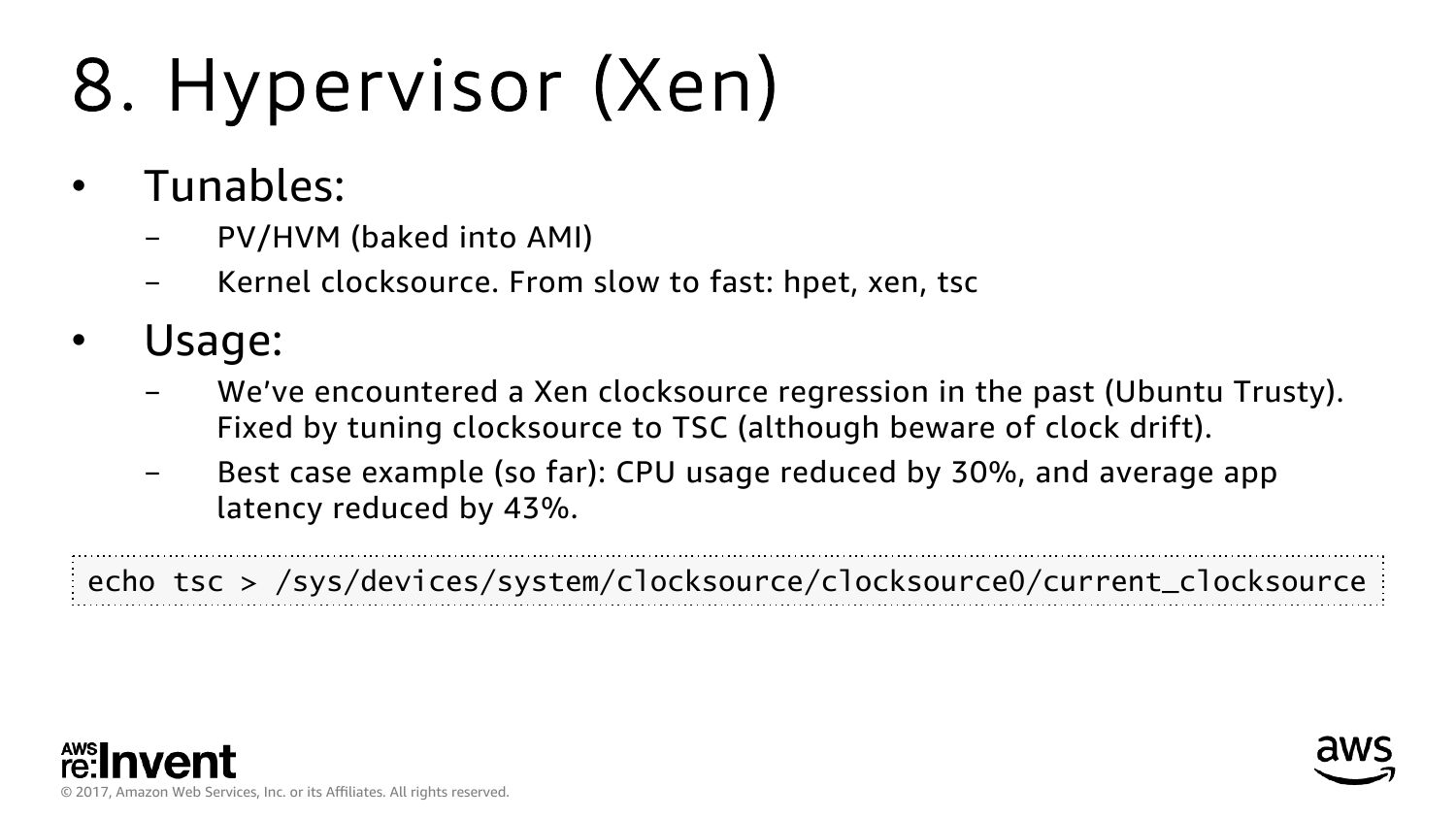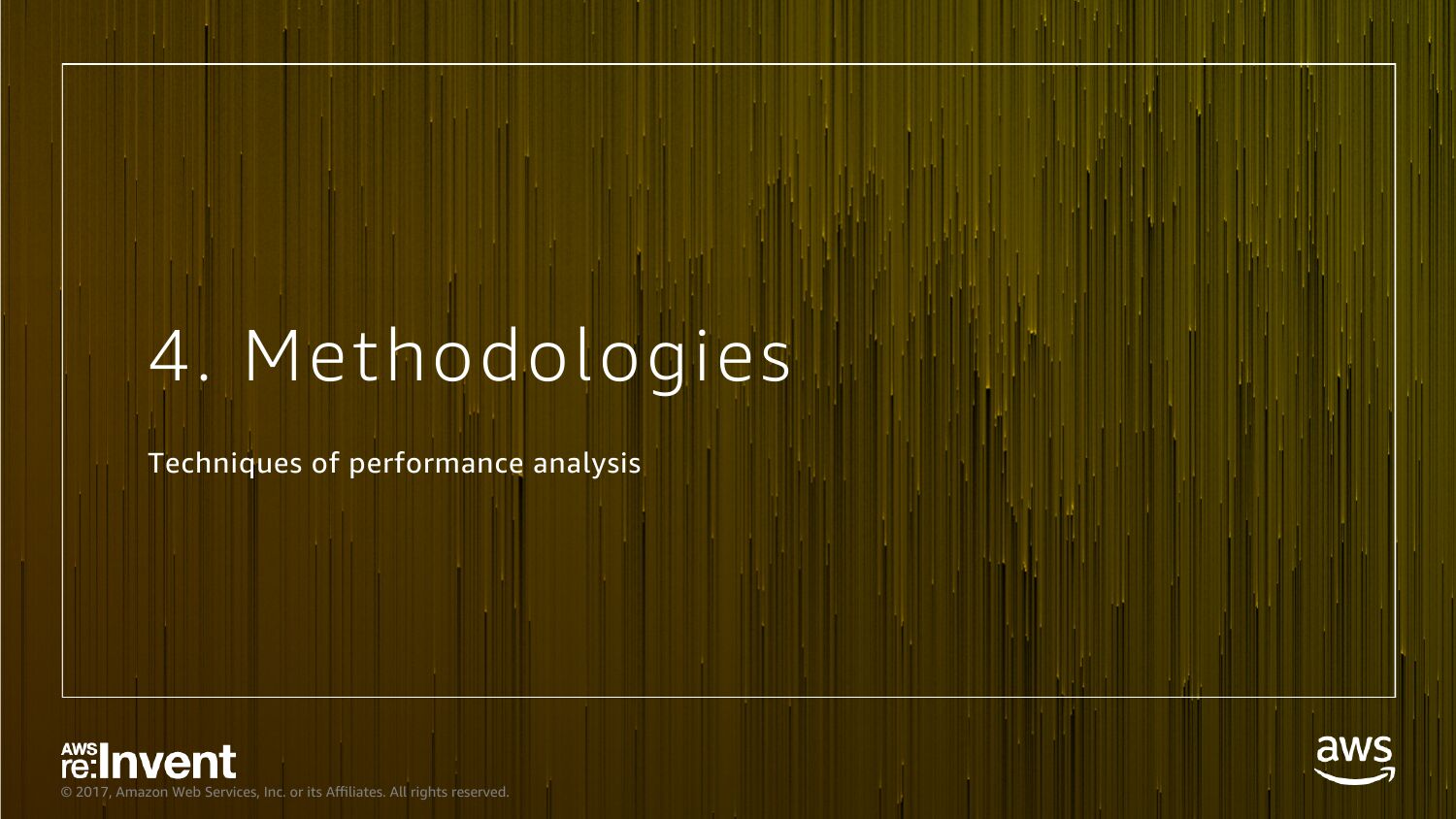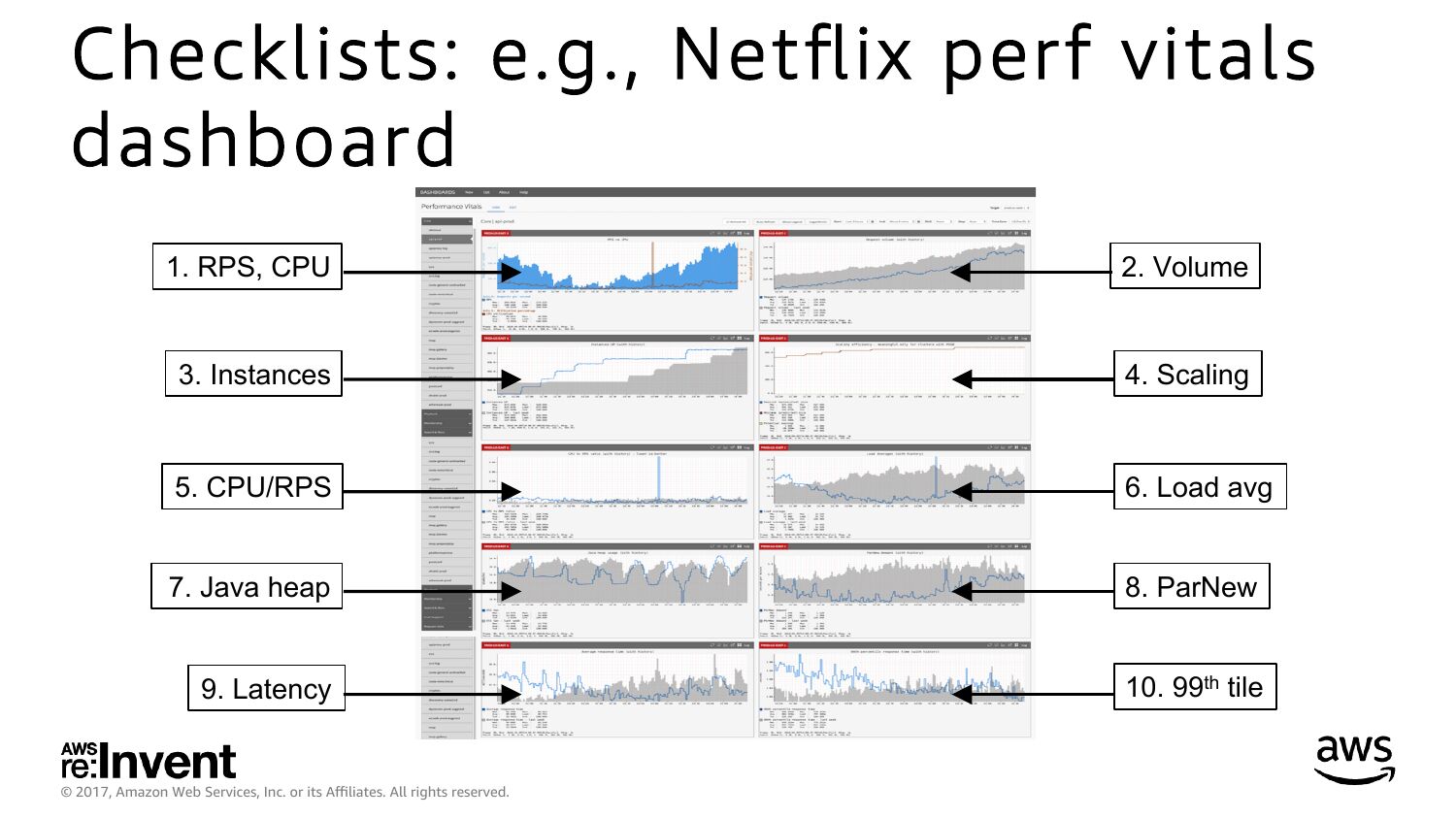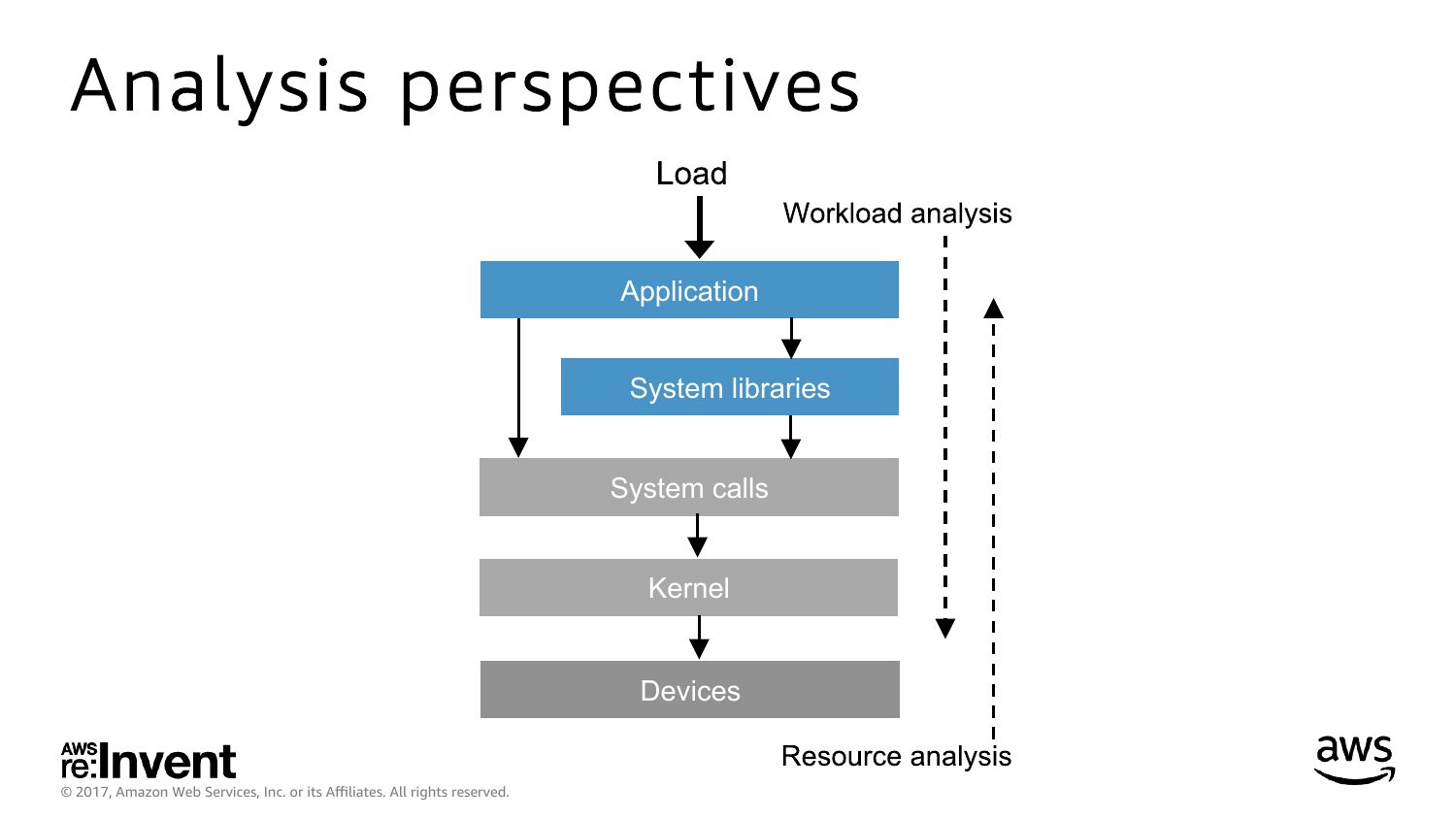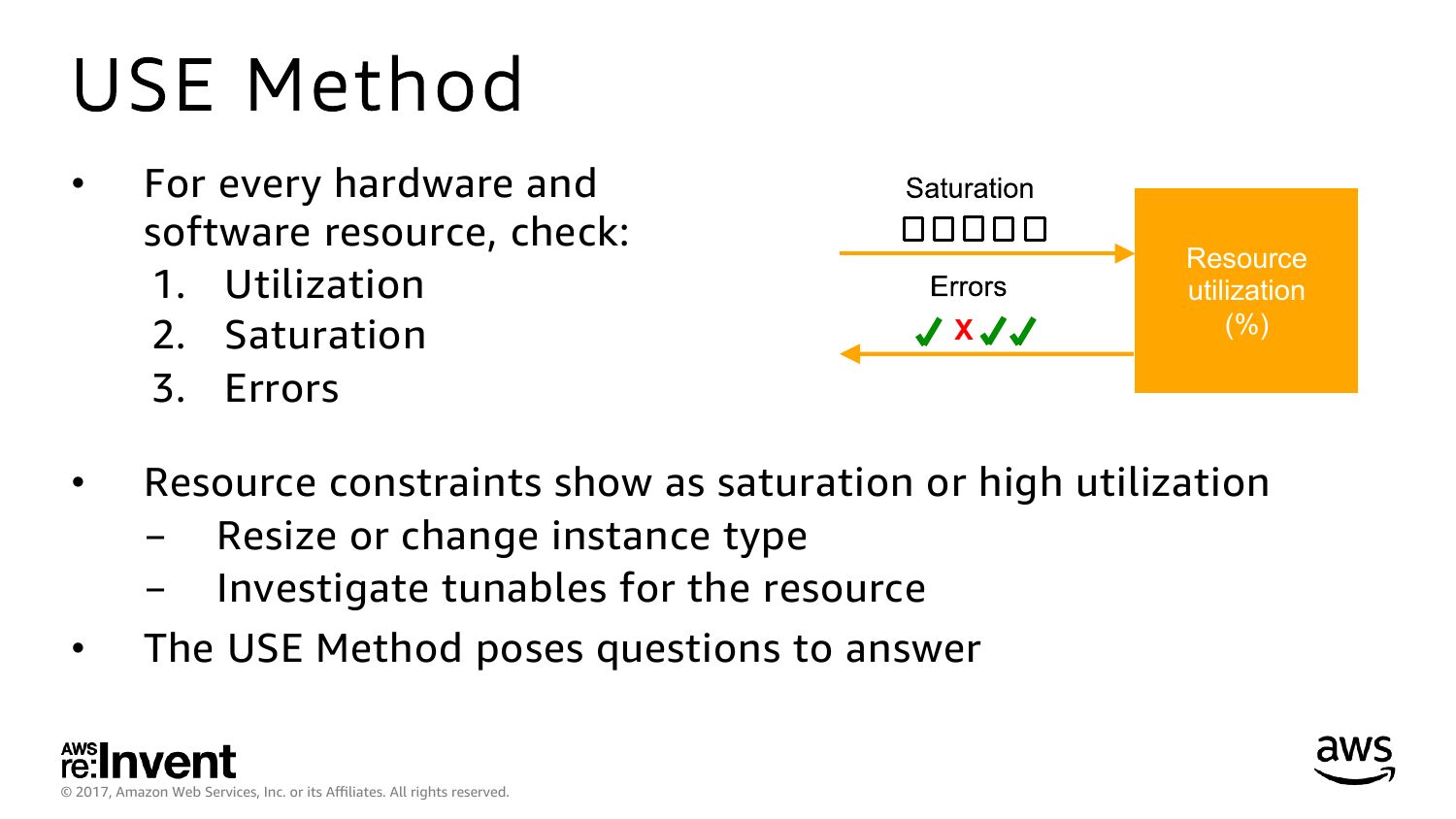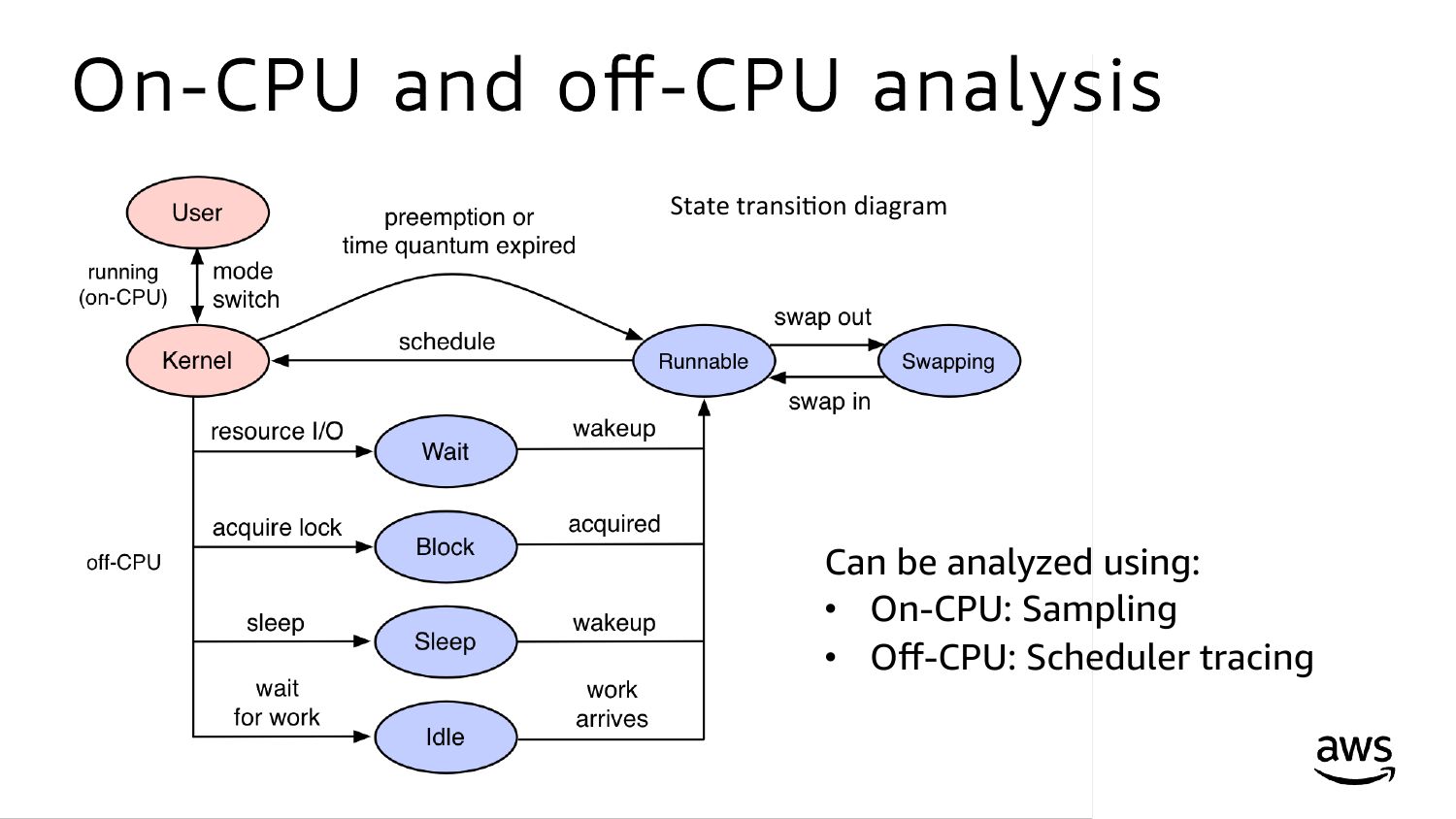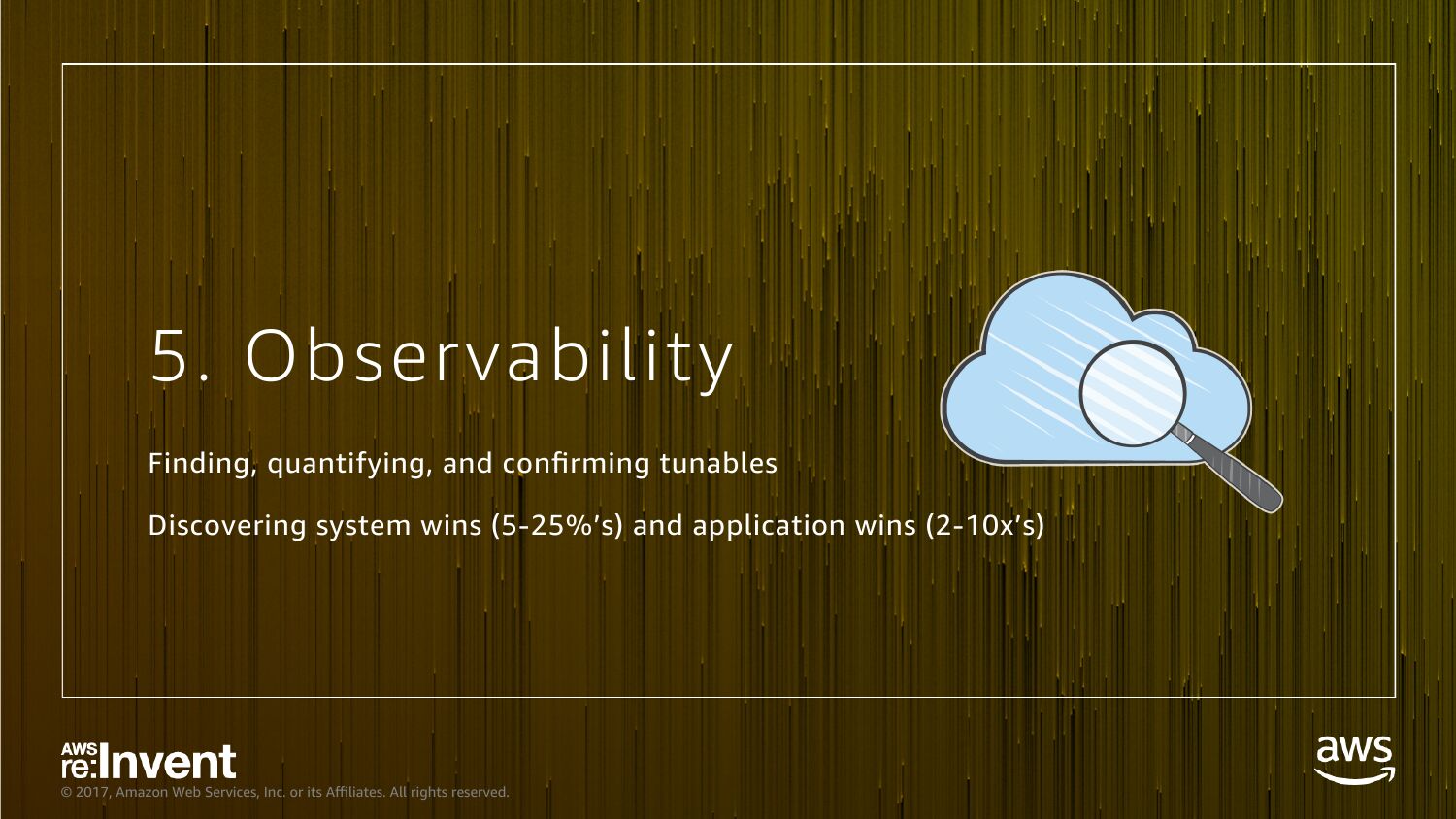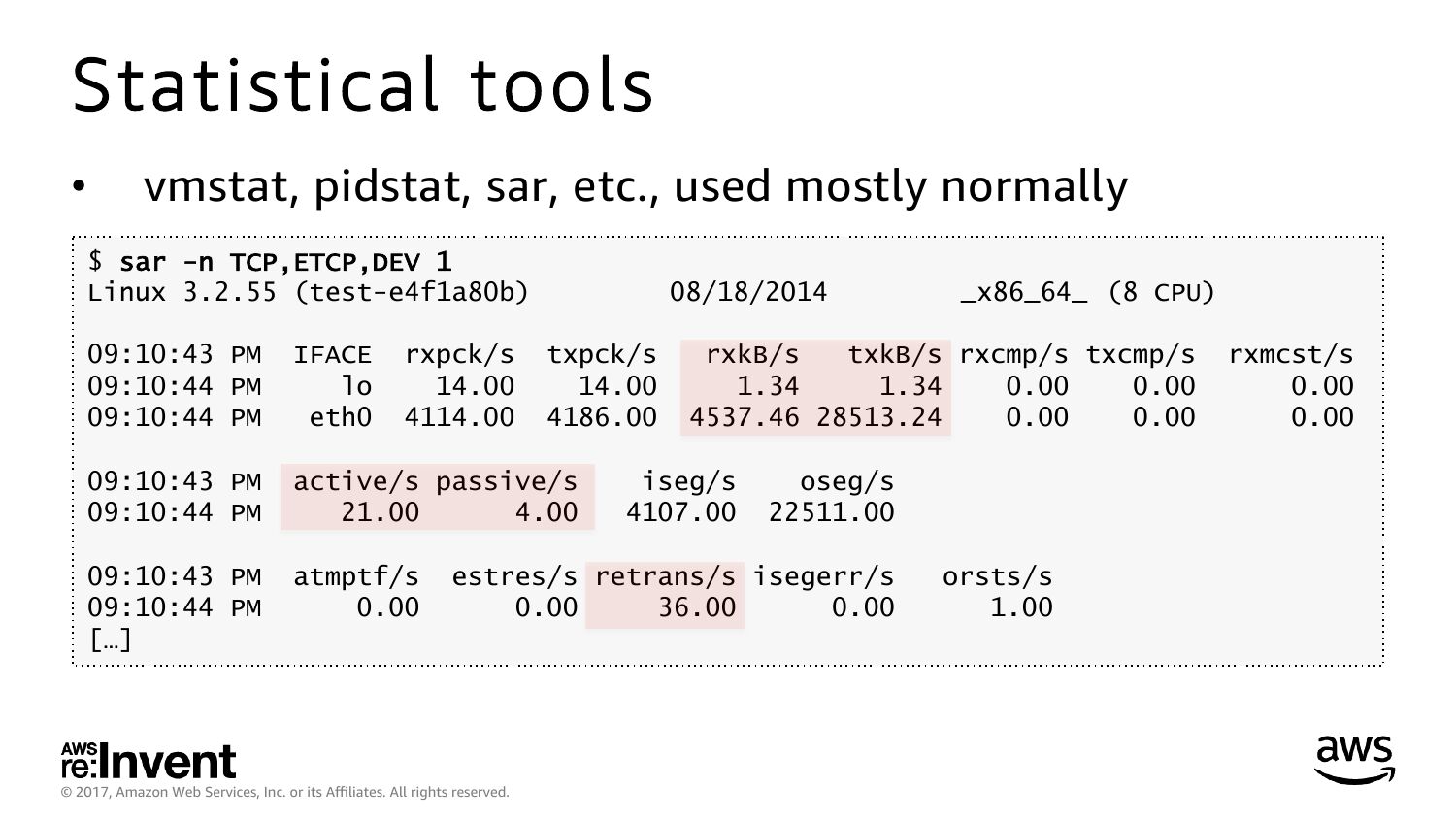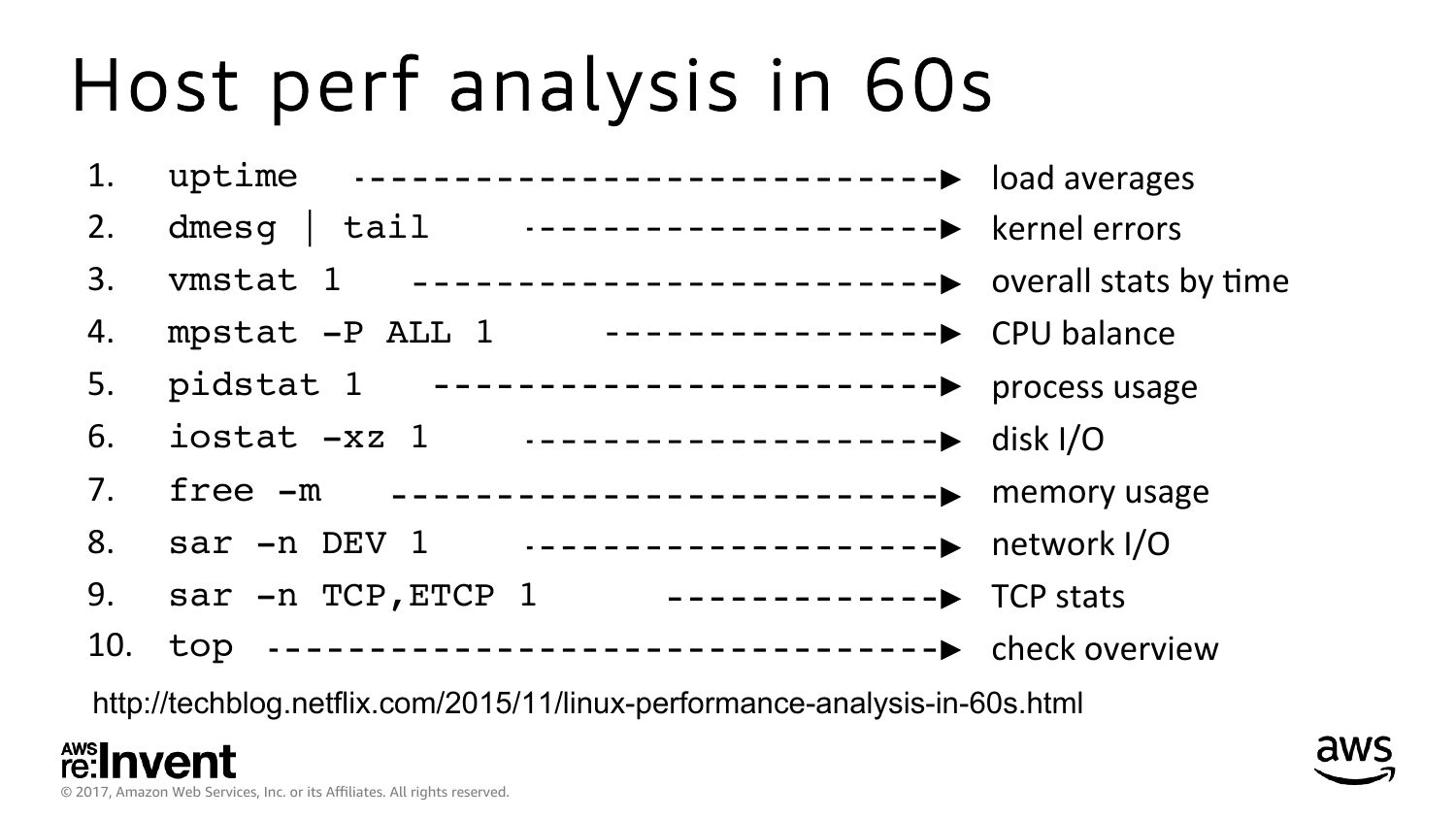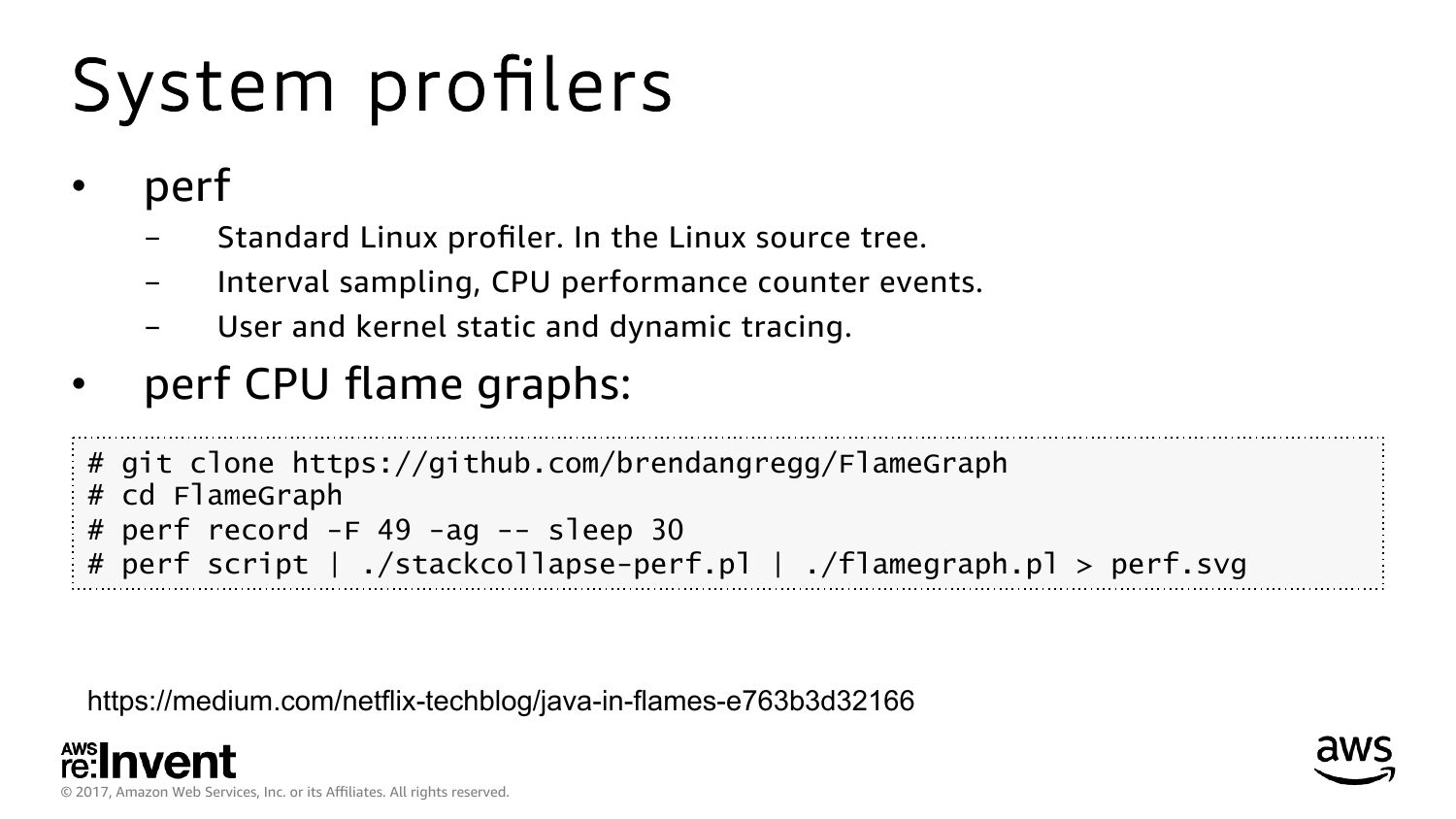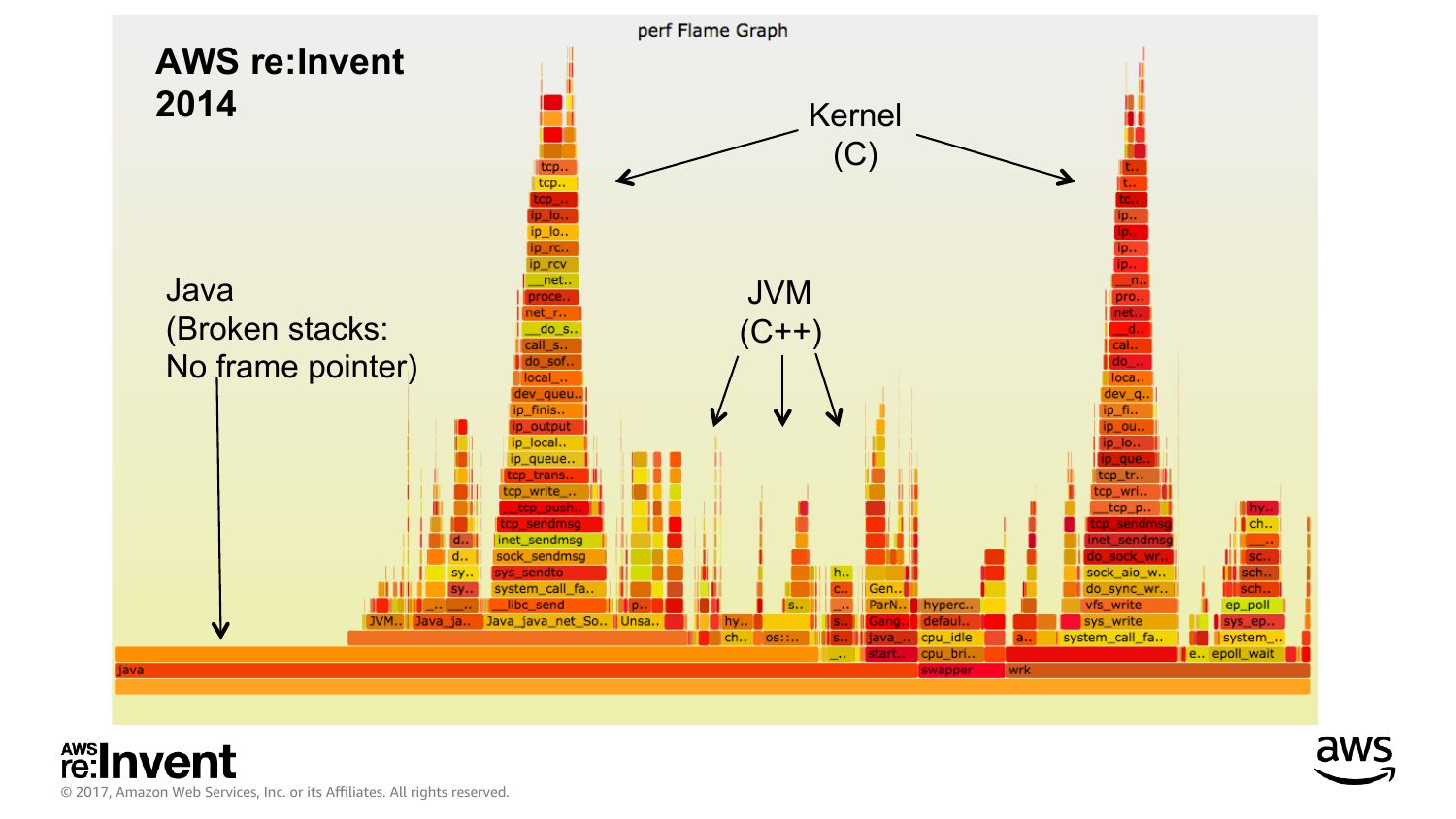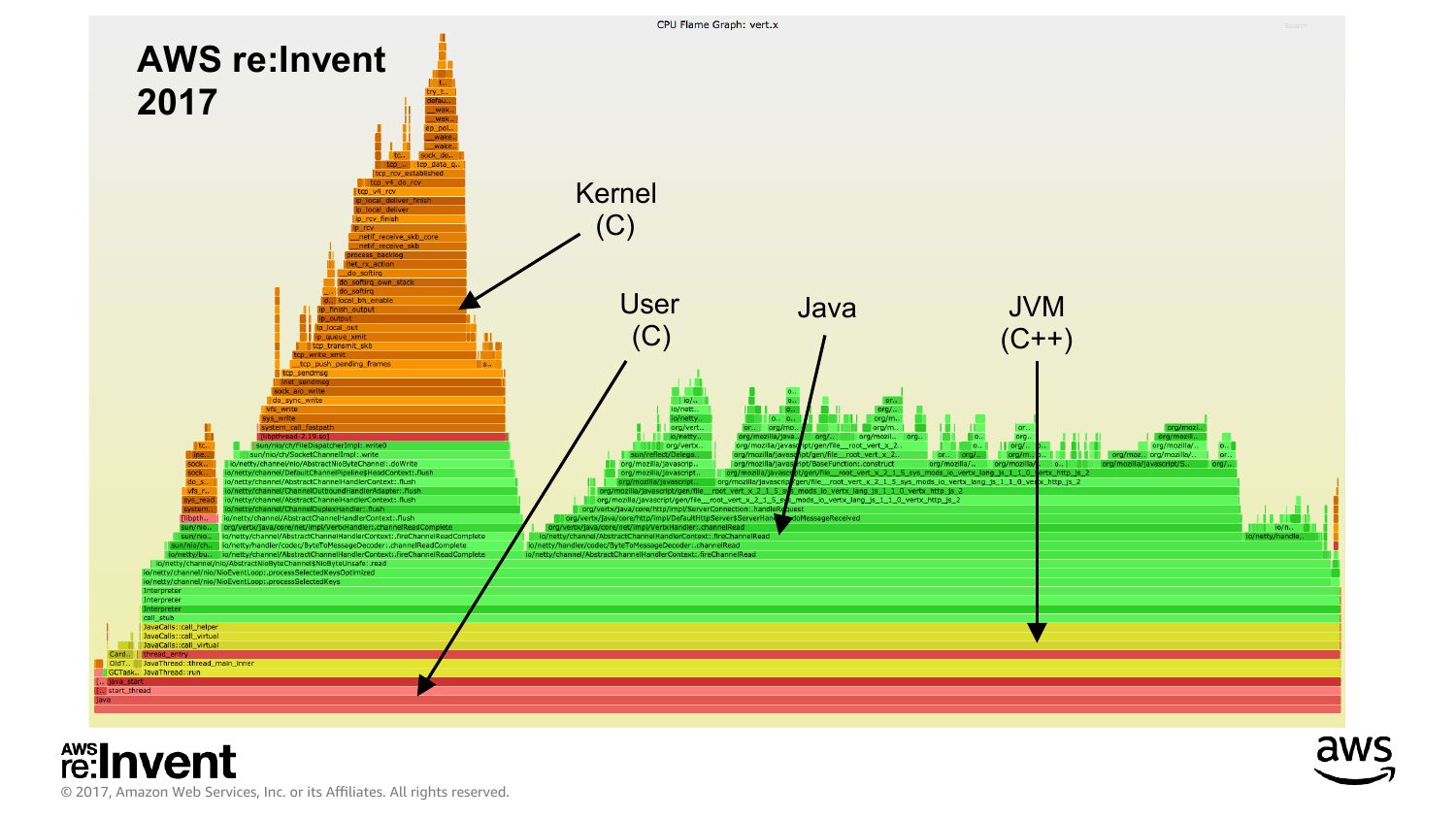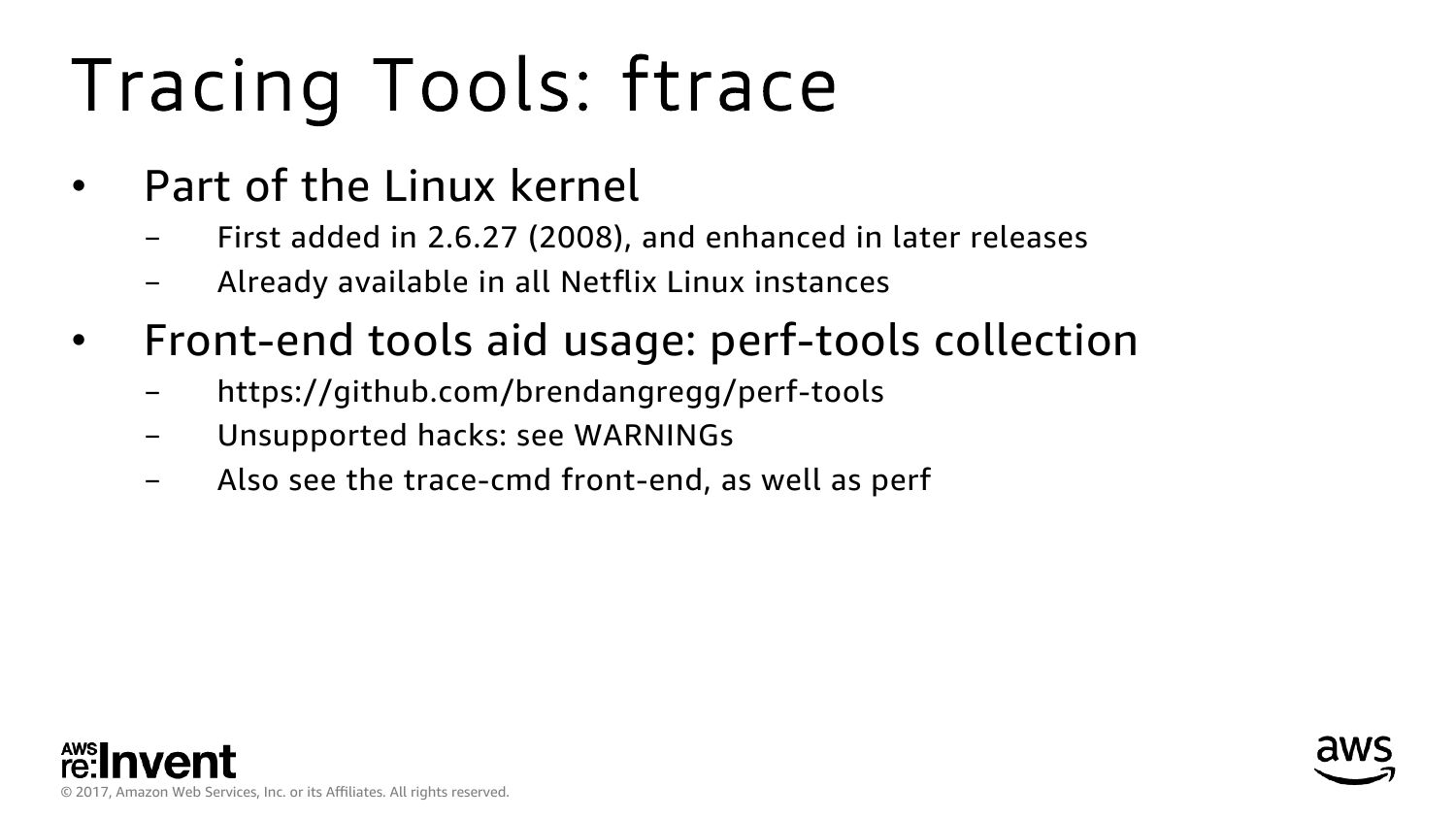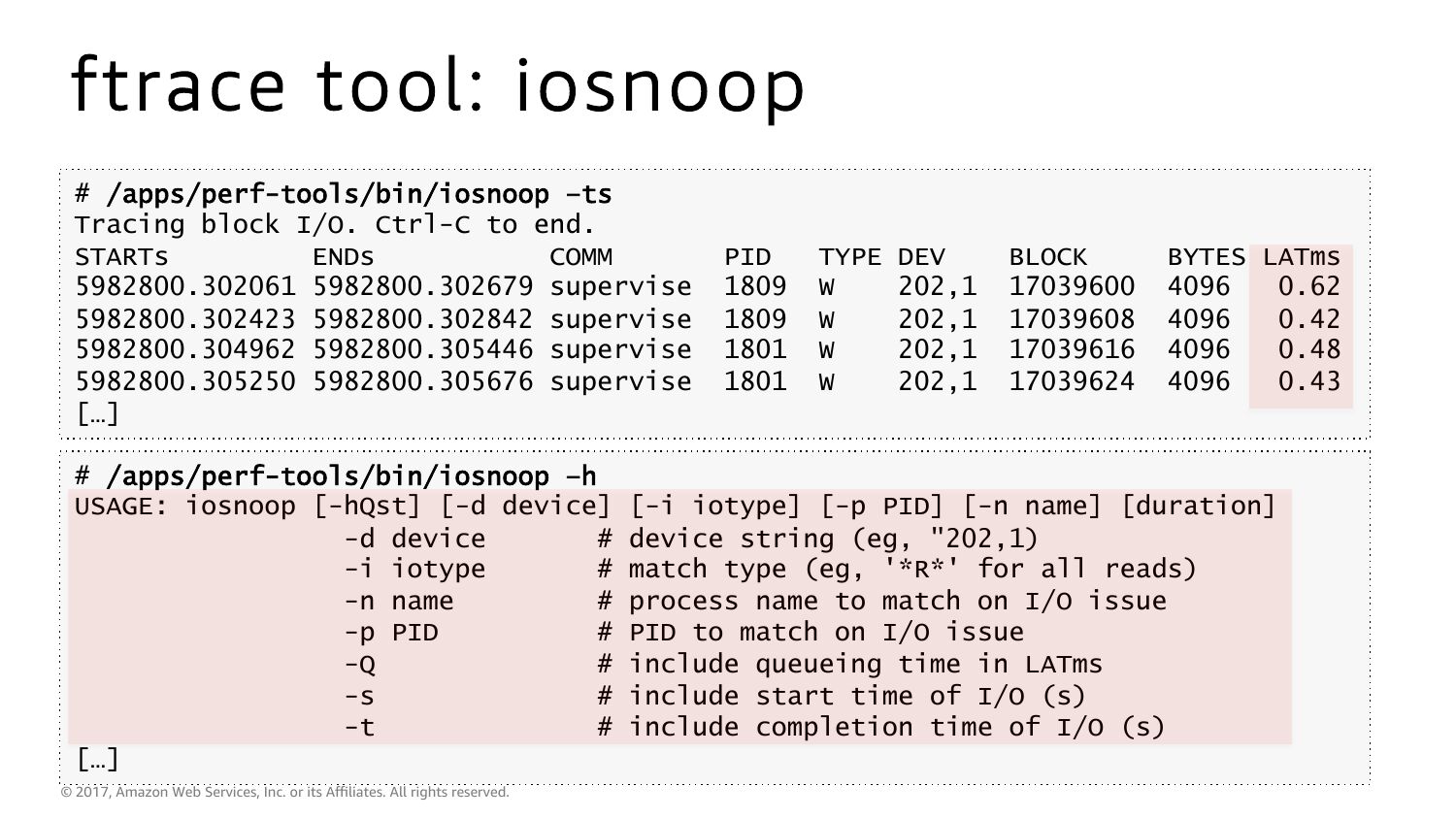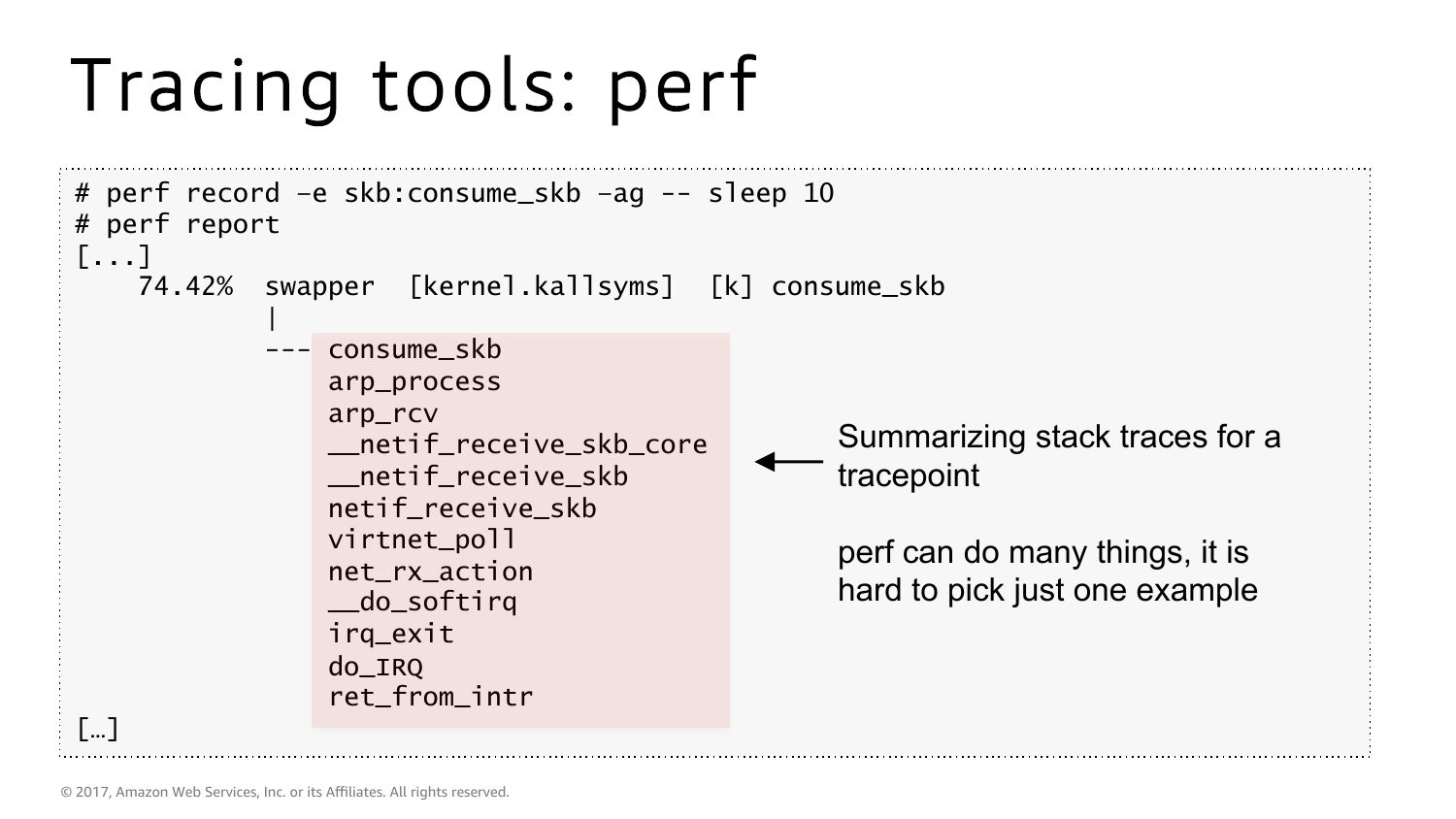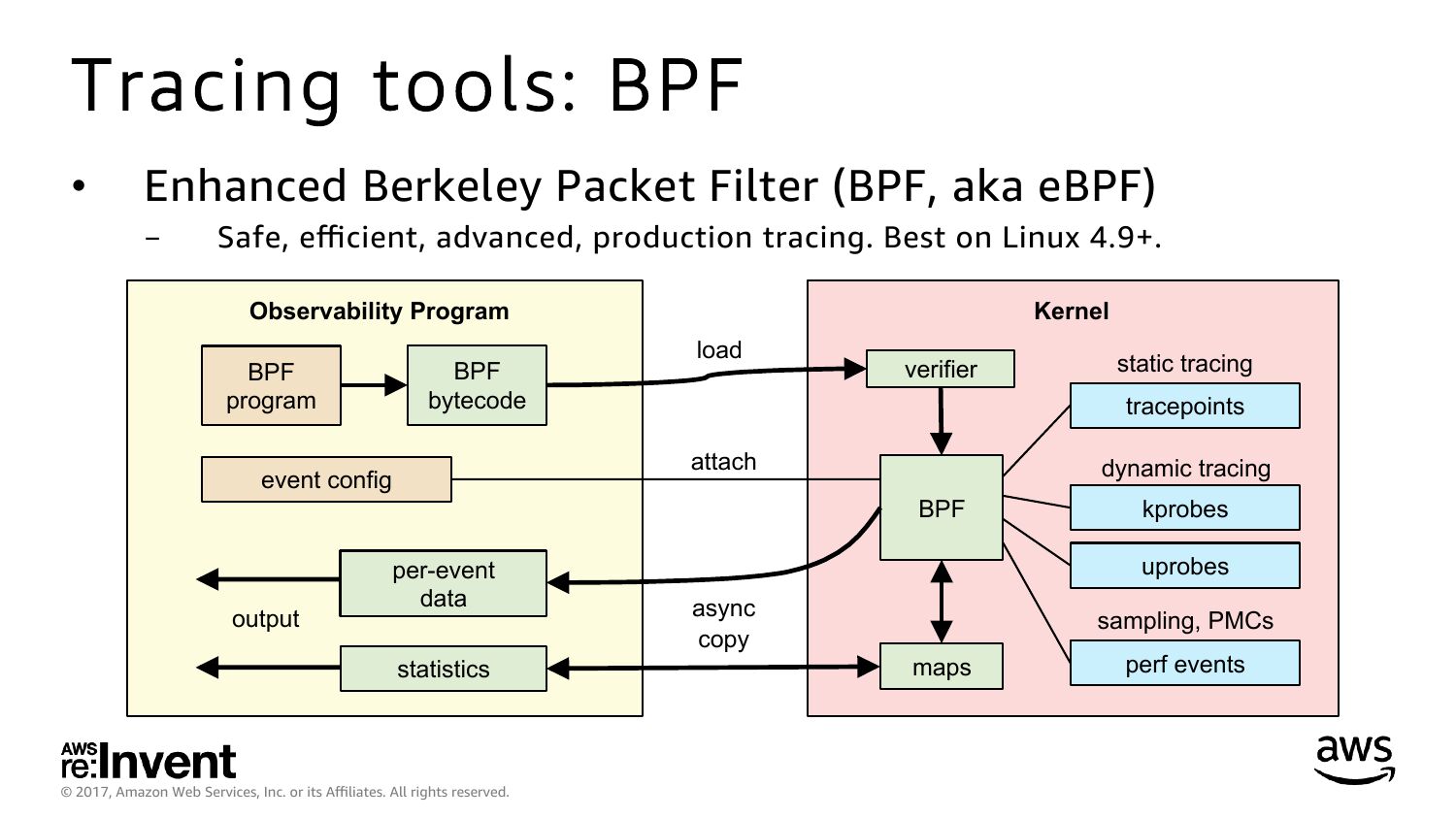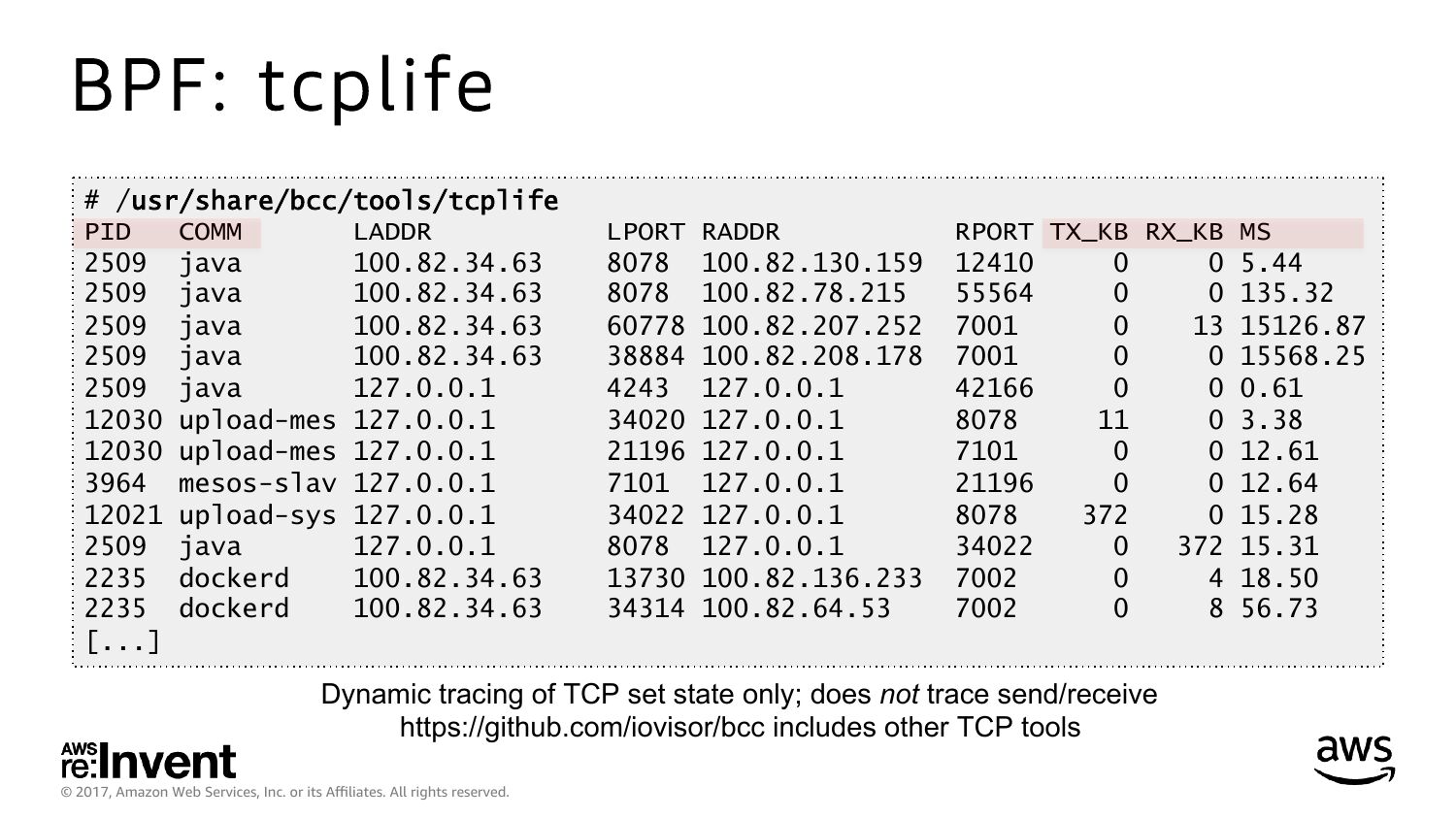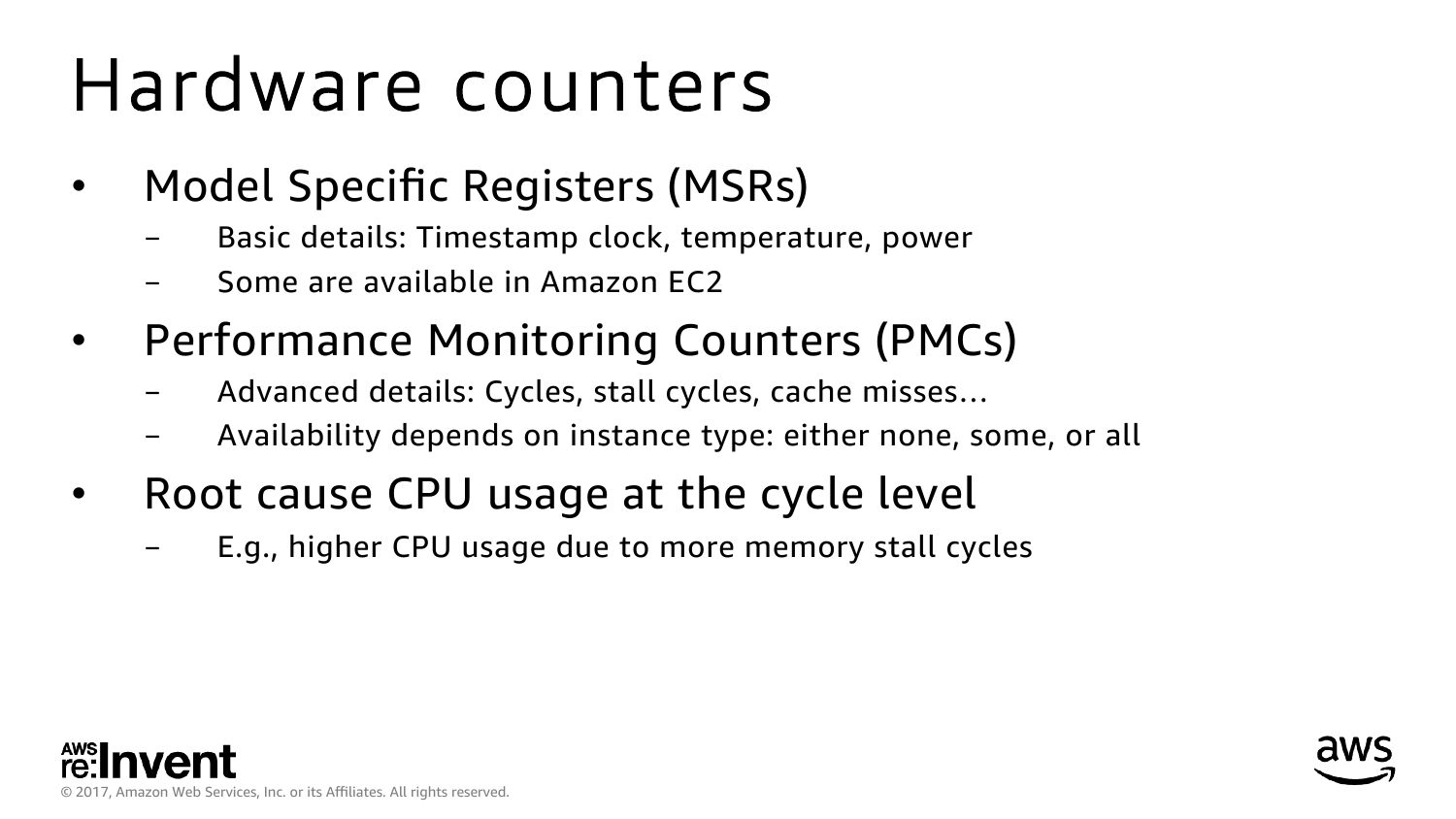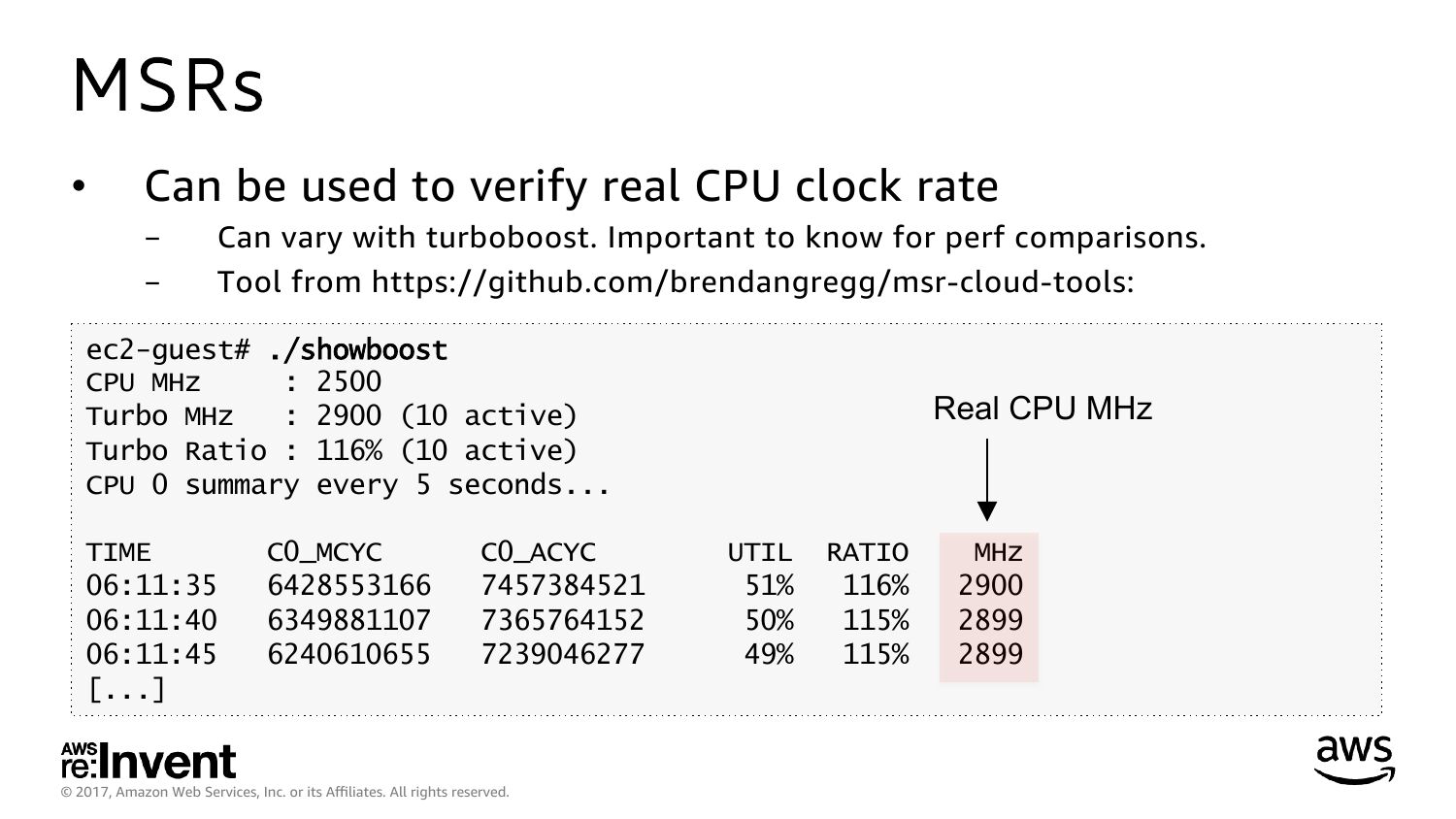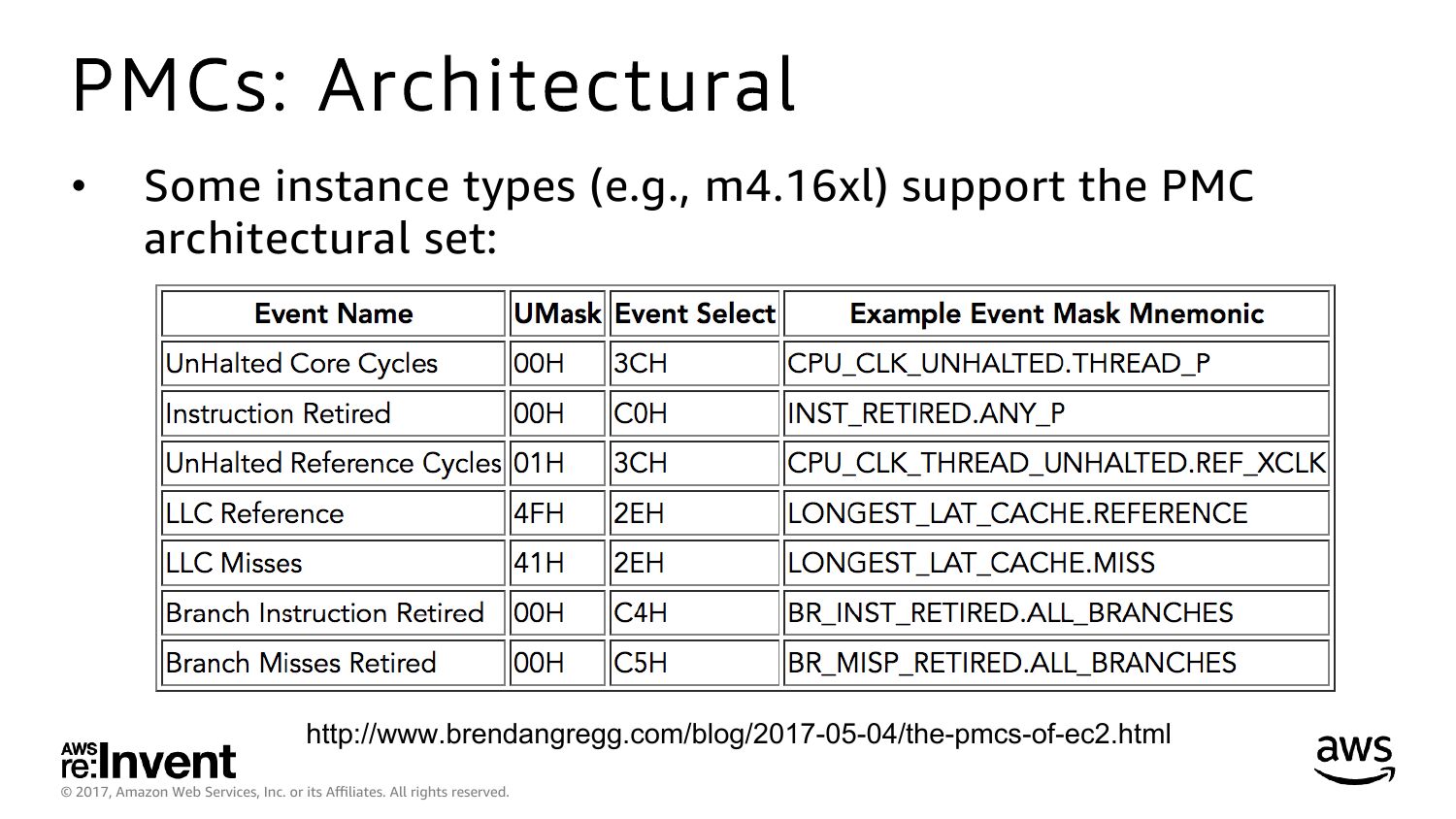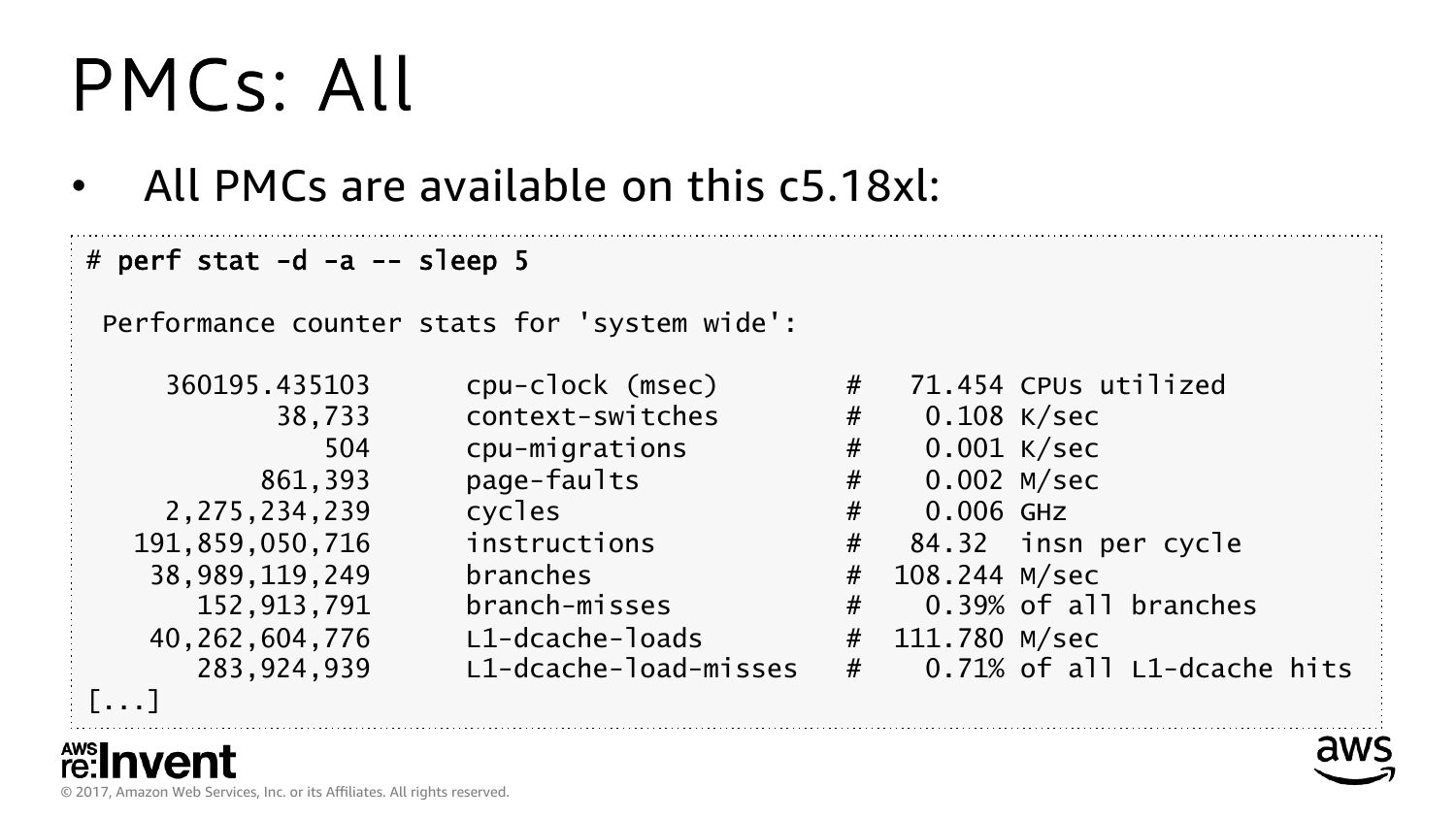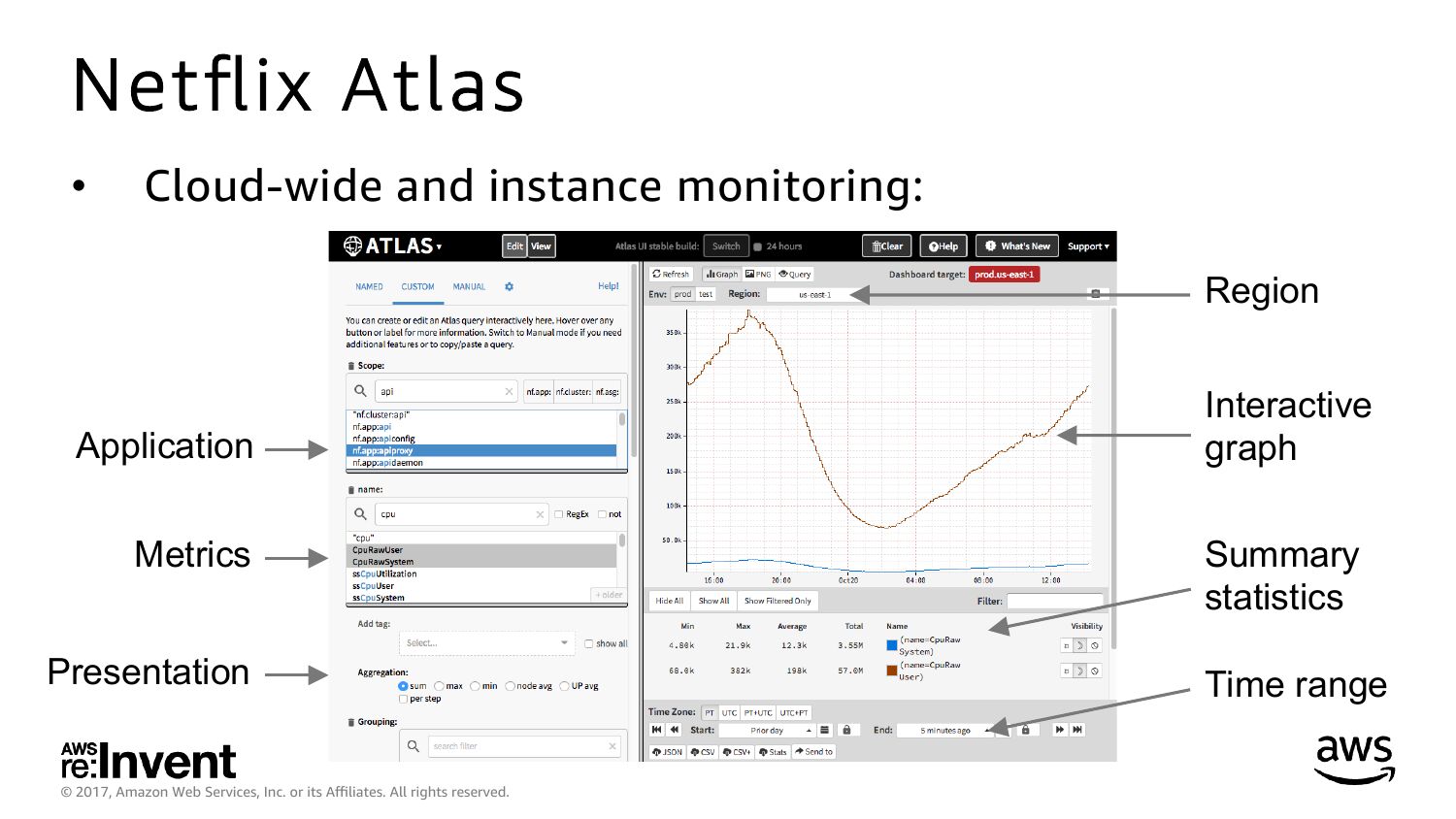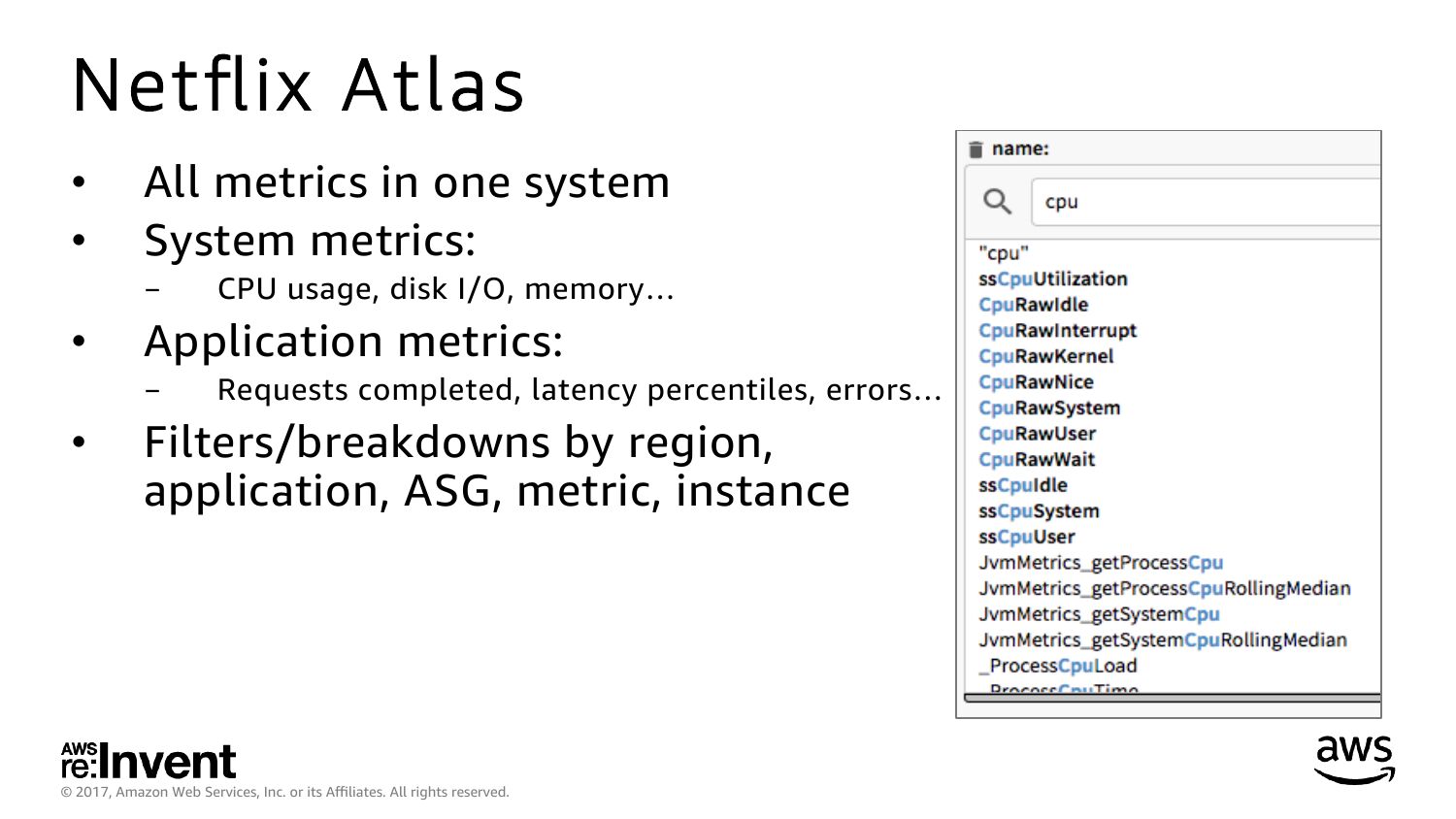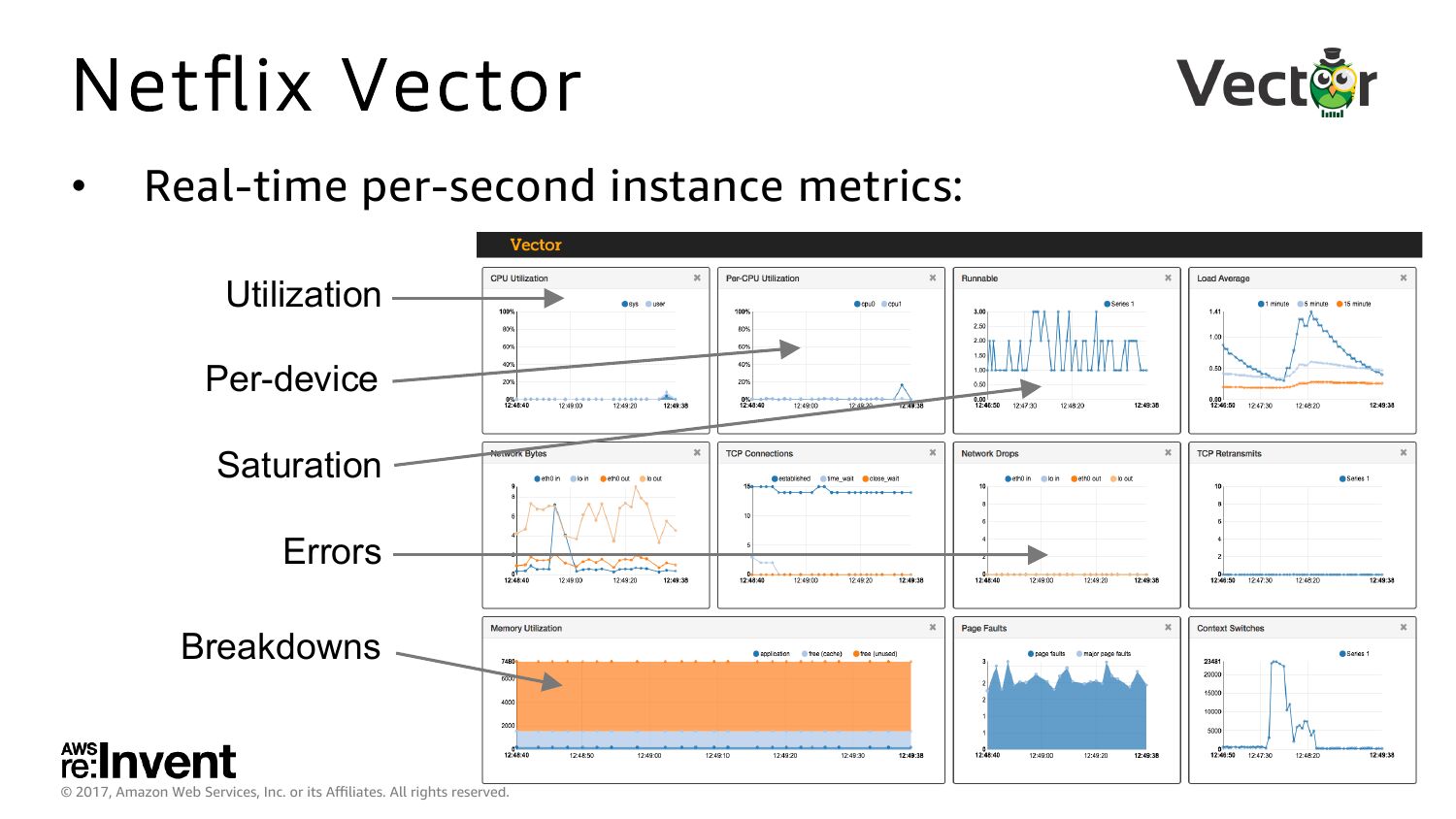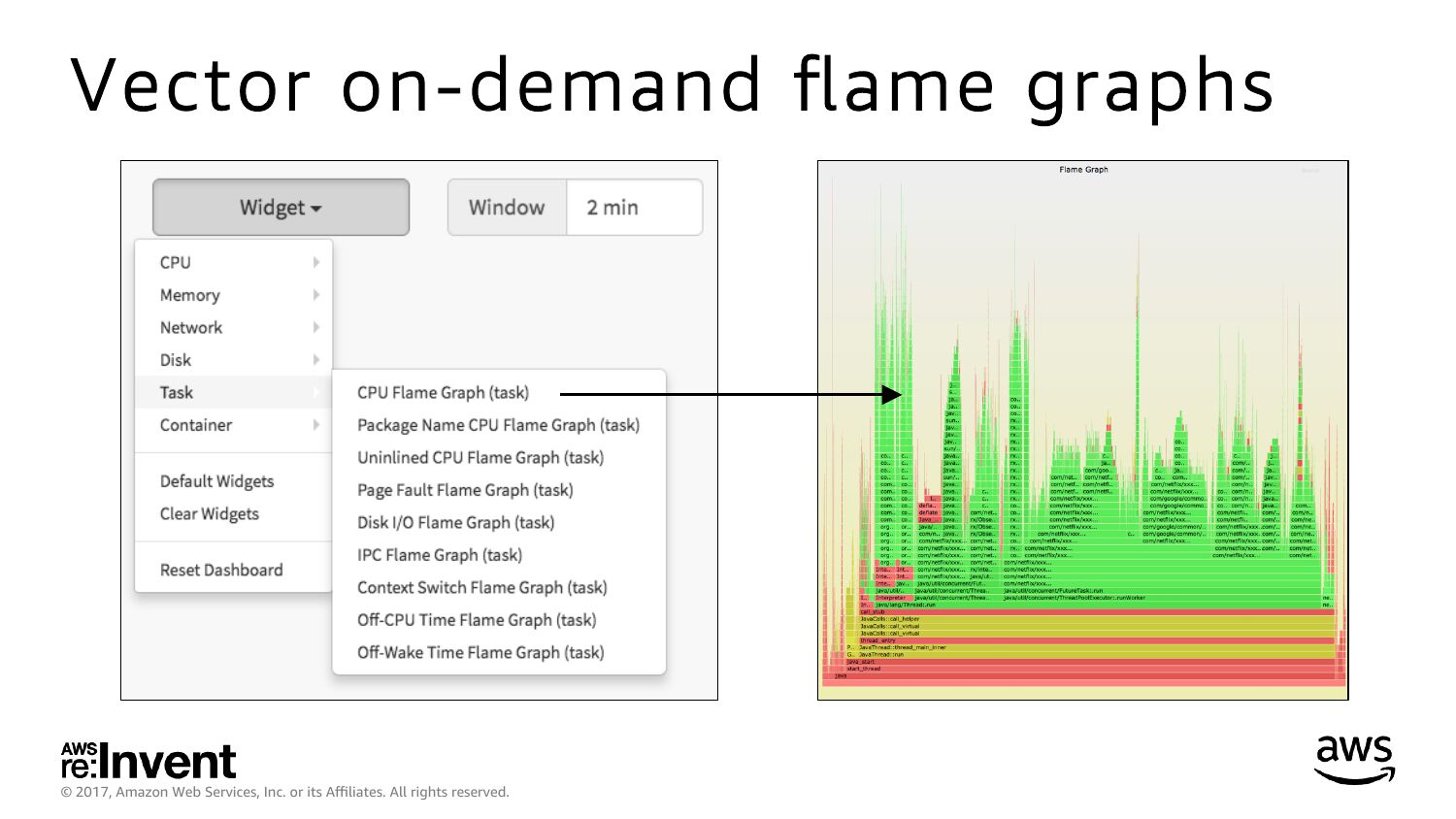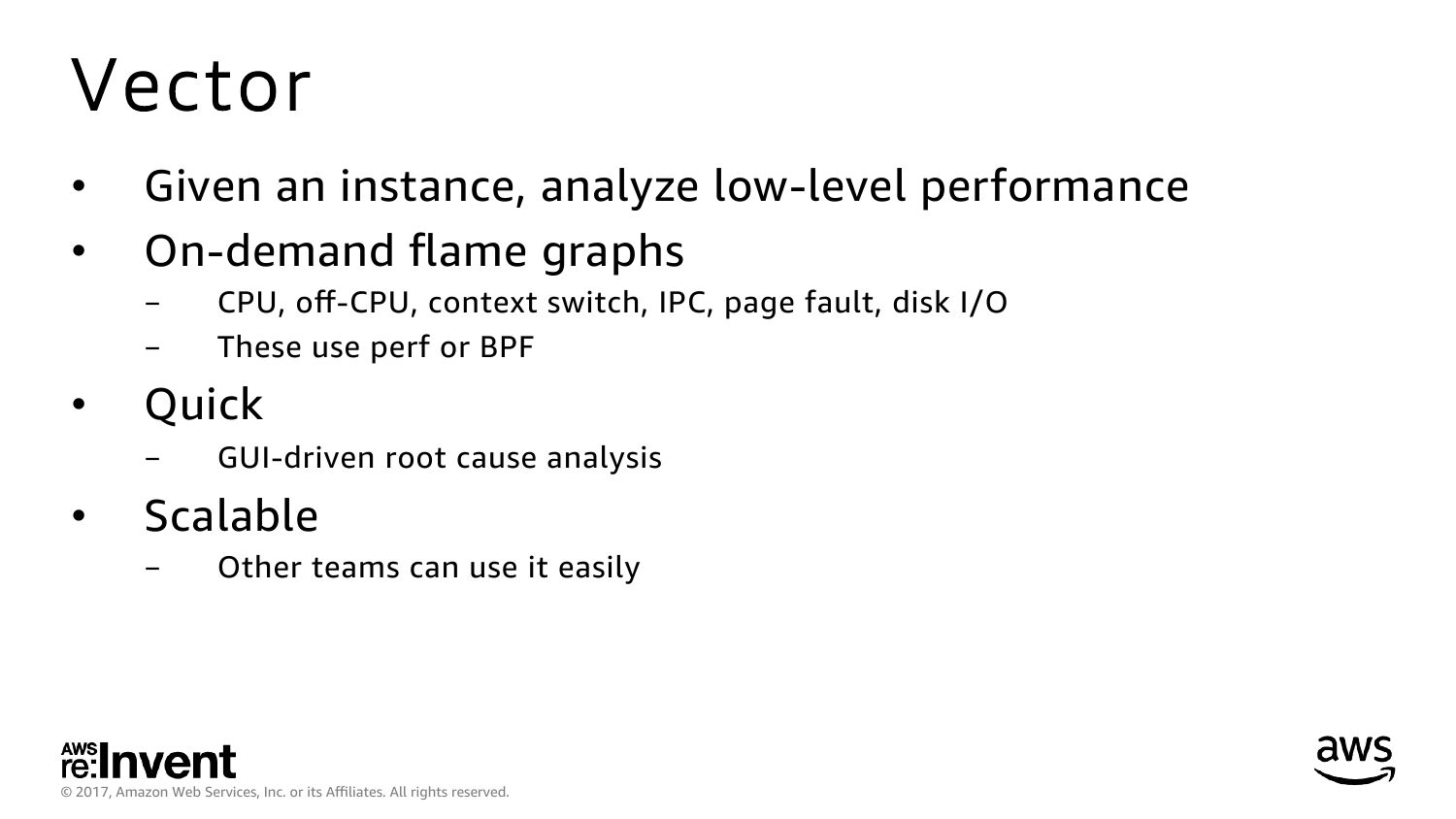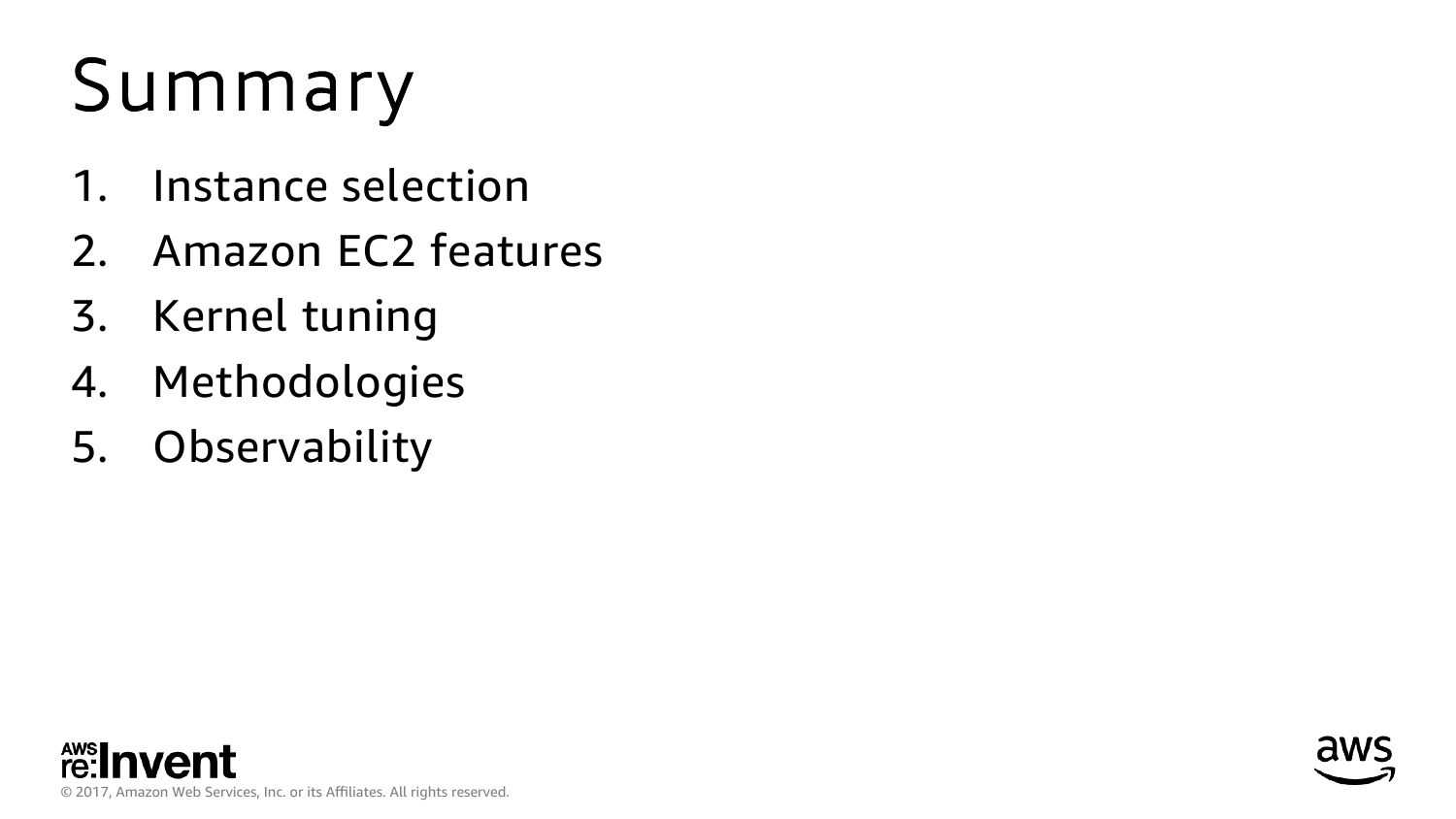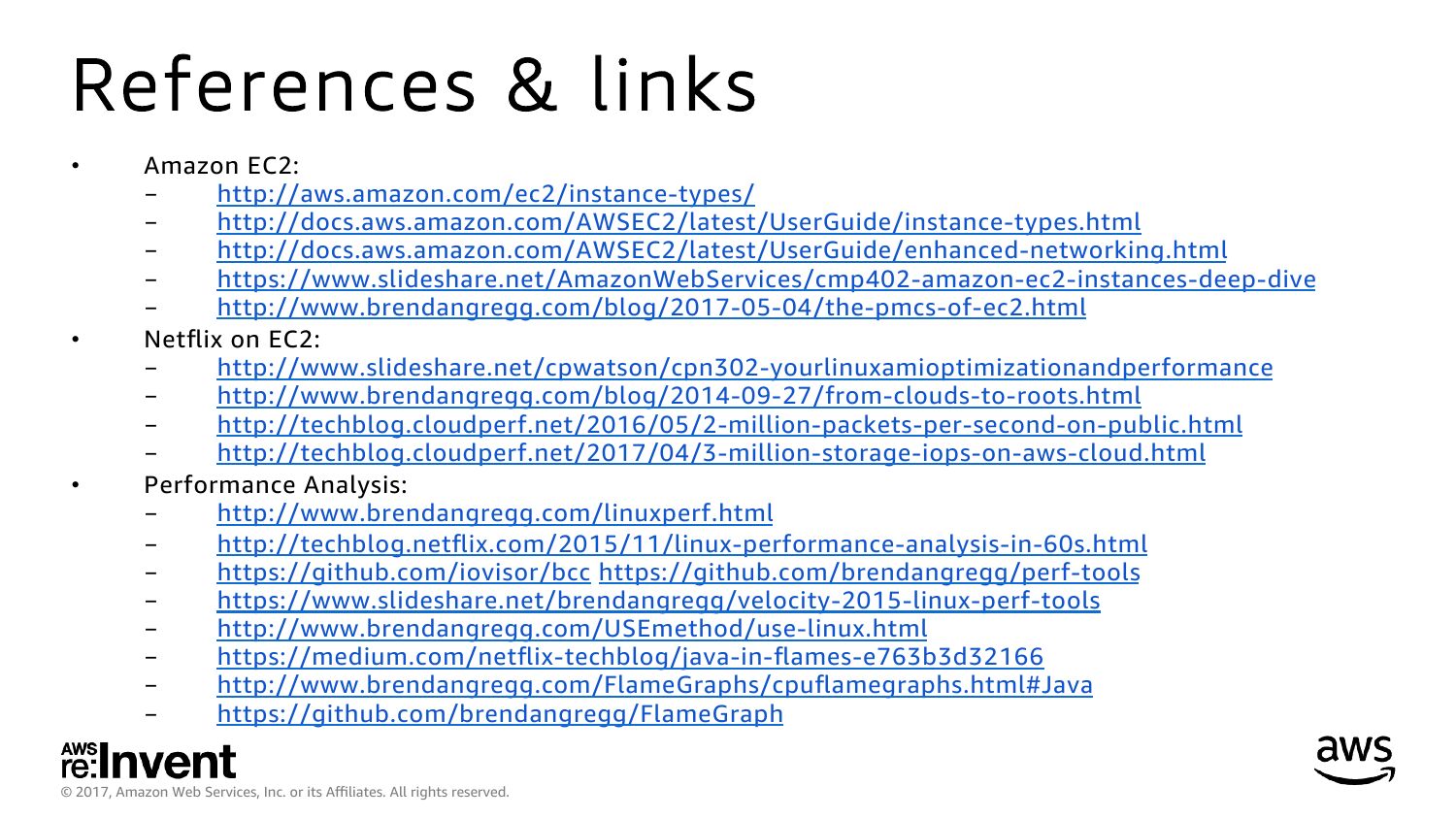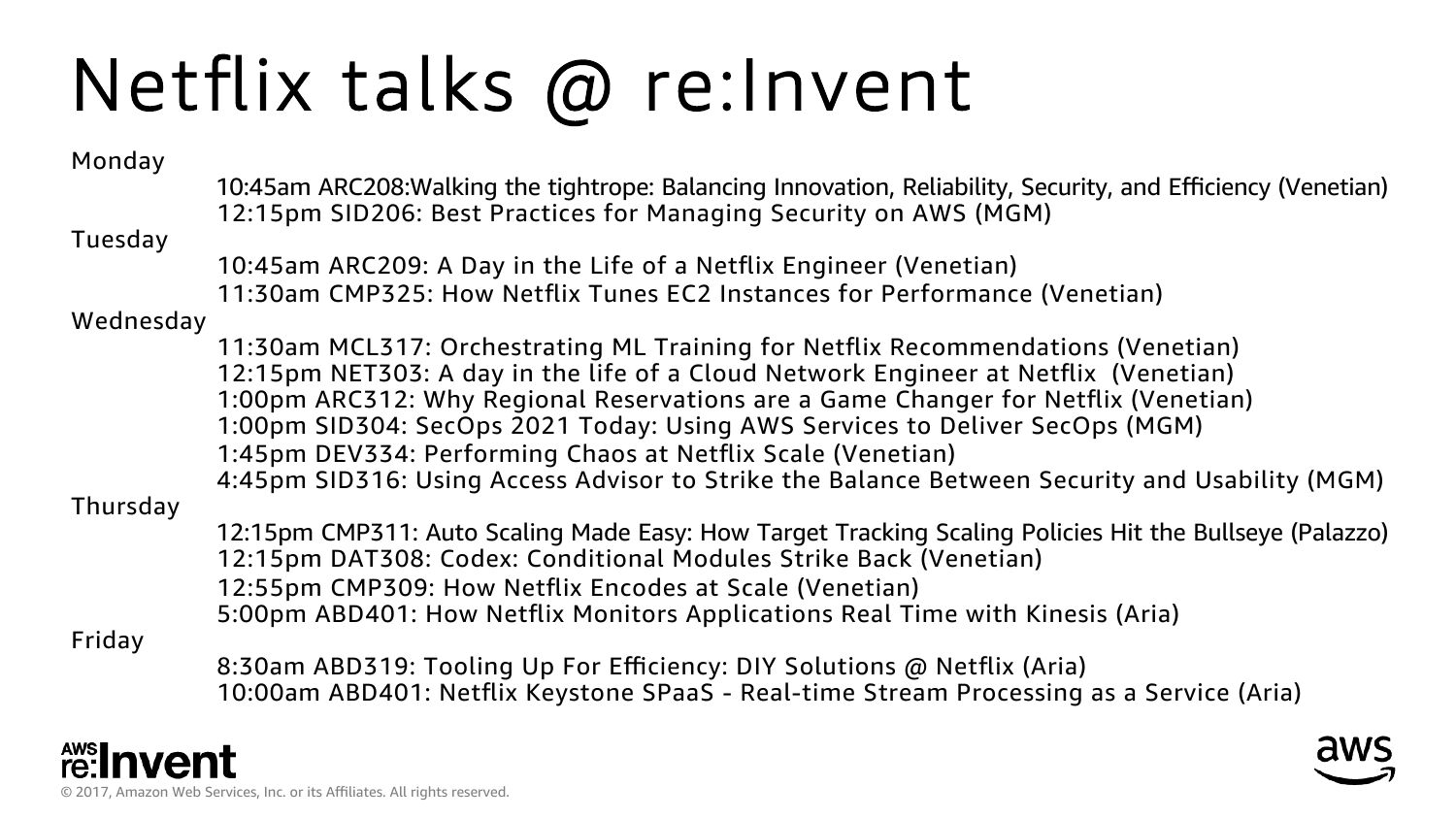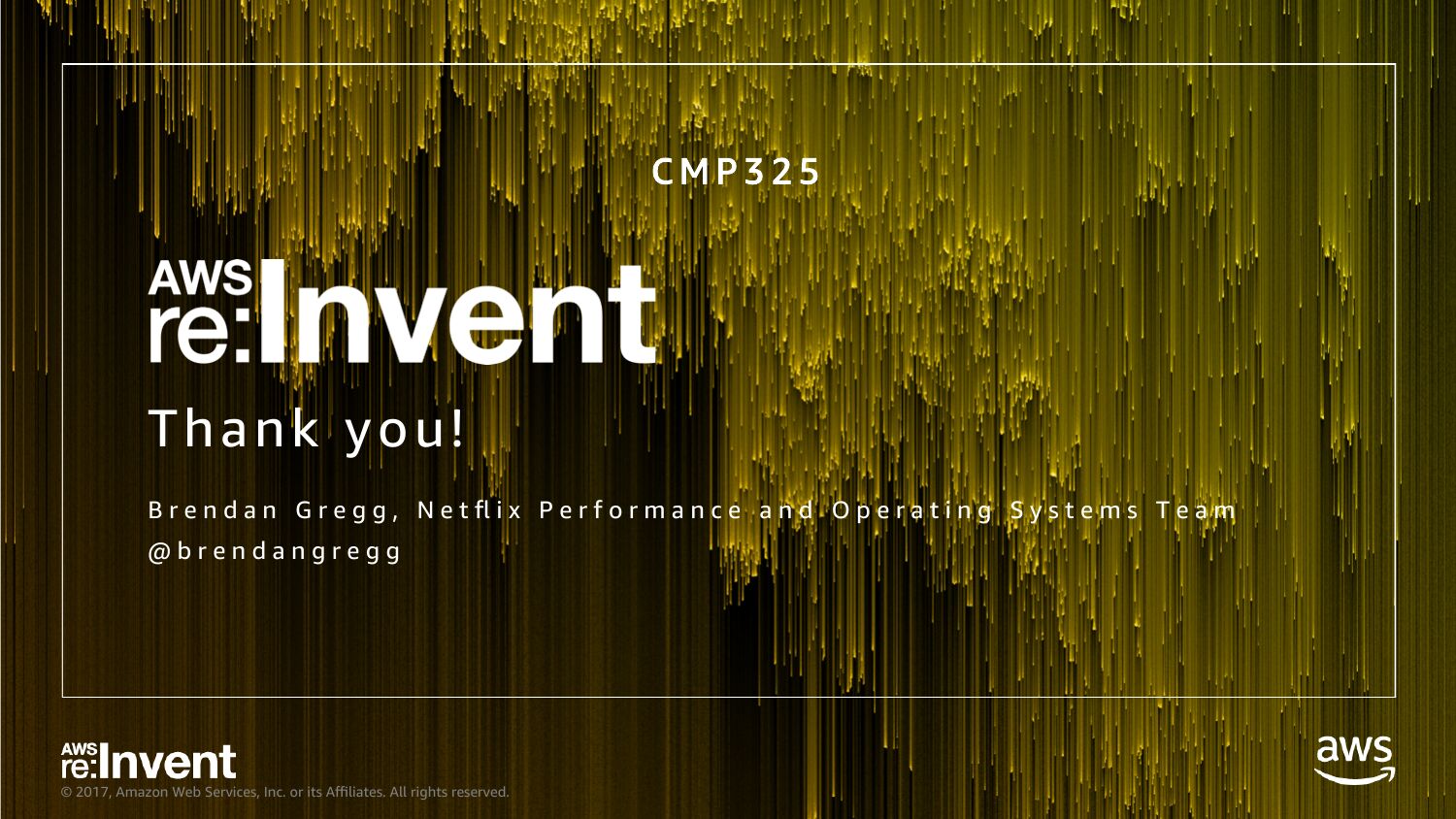AWS re:Invent 2017: How Netflix Tunes EC2 Instances for Performance
Video: https://www.youtube.com/watch?v=89fYOo1V2pACMP325 talk for AWS re:Invent 2017, by Brendan Gregg.
Description: "At Netflix we make the best use of AWS EC2 instance types and features to create a high performance cloud, achieving near bare metal speed for our workloads. This session will summarize the configuration, tuning, and activities for delivering the fastest possible EC2 instances, and will help other EC2 users improve performance, reduce latency outliers, and make better use of EC2 features. We'll show how we choose EC2 instance types, how we choose between EC2 Xen modes: HVM, PV, and PVHVM, and the importance of EC2 features such SR-IOV for bare-metal performance. SR-IOV is used by EC2 enhanced networking, and recently for the new i3 instance type for enhanced disk performance as well. We'll also cover kernel tuning and observability tools, from basic to advanced. Advanced performance analysis includes the use of Java and Node.js flame graphs, and the new EC2 Performance Monitoring Counter (PMC) feature released this year."
| next prev 1/63 | |
| next prev 2/63 | |
| next prev 3/63 | |
| next prev 4/63 | |
| next prev 5/63 | |
| next prev 6/63 | |
| next prev 7/63 | |
| next prev 8/63 | |
| next prev 9/63 | |
| next prev 10/63 | |
| next prev 11/63 | |
| next prev 12/63 | |
| next prev 13/63 | |
| next prev 14/63 | |
| next prev 15/63 | |
| next prev 16/63 | |
| next prev 17/63 | |
| next prev 18/63 | |
| next prev 19/63 | |
| next prev 20/63 | |
| next prev 21/63 | |
| next prev 22/63 | |
| next prev 23/63 | |
| next prev 24/63 | |
| next prev 25/63 | |
| next prev 26/63 | |
| next prev 27/63 | |
| next prev 28/63 | |
| next prev 29/63 | |
| next prev 30/63 | |
| next prev 31/63 | |
| next prev 32/63 | |
| next prev 33/63 | |
| next prev 34/63 | |
| next prev 35/63 | |
| next prev 36/63 | |
| next prev 37/63 | |
| next prev 38/63 | |
| next prev 39/63 | |
| next prev 40/63 | |
| next prev 41/63 | |
| next prev 42/63 | |
| next prev 43/63 | |
| next prev 44/63 | |
| next prev 45/63 | |
| next prev 46/63 | |
| next prev 47/63 | |
| next prev 48/63 | |
| next prev 49/63 | |
| next prev 50/63 | |
| next prev 51/63 | |
| next prev 52/63 | |
| next prev 53/63 | |
| next prev 54/63 | |
| next prev 55/63 | |
| next prev 56/63 | |
| next prev 57/63 | |
| next prev 58/63 | |
| next prev 59/63 | |
| next prev 60/63 | |
| next prev 61/63 | |
| next prev 62/63 | |
| next prev 63/63 |
PDF: AWSreInvent2017_performance_tuning_EC2.pdf
Keywords (from pdftotext):
slide 1:
CMP325 How Netflix Tunes EC2 Instances for Performance Brendan Gregg, Performance and OS Engineering Team November 28, 2017 © 2017, Amazon Web Services, Inc. or its Affiliates. All rights reserved.slide 2:
© 2017, Amazon Web Services, Inc. or its Affiliates. All rights reserved.slide 3:
Netflix performance and operating systems team Evaluate technology Recommendations and best practices Develop tools for observability and analysis Project support Instance kernel tuning, assist app tuning Develop performance tools Instance types, Amazon Elastic Compute Cloud (EC2) options New database, programming language, software change Incident response Performance issues, scalability issues © 2017, Amazon Web Services, Inc. or its Affiliates. All rights reserved.slide 4:
Agenda Instance selection Amazon EC2 features Kernel tuning Methodologies Observability © 2017, Amazon Web Services, Inc. or its Affiliates. All rights reserved.slide 5:
Warnings This is what’s in our medicine cabinet Consider these “best before: 2018” Take only if prescribed by a performance engineer © 2017, Amazon Web Services, Inc. or its Affiliates. All rights reserved.slide 6:
1. Instance selection © 2017, Amazon Web Services, Inc. or its Affiliates. All rights reserved.slide 7:
The Netflix cloud Many application workloads: Compute, storage, caching… EC2 ELB Cassandra Applications (services) Elasticsearch EVCache © 2017, Amazon Web Services, Inc. or its Affiliates. All rights reserved. SES SQSslide 8:
Netflix AWS environment Elastic Load Balancing allows real load testing ASG Cluster prod1 Single instance canary, then, Auto scaling group Much better than microbenchmarking alone, which is error prone © 2017, Amazon Web Services, Inc. or its Affiliates. All rights reserved. ELB Canary ASG-v010 Instance Instance Instance Instance Instance ASG-v011 Instance Instance Instance Instance Instanceslide 9:
Current generation instances Families: m4: General purpose • Balanced c5: Compute-optimized • Latest CPUs, lowest price/compute perf i3, d2: Storage-optimized • SSD large capacity storage r4, x1: Memory optimized • Lowest cost/Gbyte p2, g3, f1: Accelerated computing • GPUs, FPGAs… Types: Range from medium to 16x large+, depending on family Netflix uses over 30 different instance types © 2017, Amazon Web Services, Inc. or its Affiliates. All rights reserved.slide 10:
Netflix instance type selection A. Flow chart B. By-resource C. Brute force © 2017, Amazon Web Services, Inc. or its Affiliates. All rights reserved.slide 11:
A. Instance selection flow chart Start Need large disk capacity? Disk I/O bound? Can cache? Find best balance Select memory to cache working set © 2017, Amazon Web Services, Inc. or its Affiliates. All rights reserved.slide 12:
B. By-resource approach Determine bounding resource E.g.: CPU, disk I/O, or network I/O Found using: Estimation (expertise) Resource observability with an existing real workload Resource observability with a benchmark or load test (experimentation) Choose instance type for the bounding resource If disk I/O, consider caching, and a memory-optimized type We have tools to aid this choice: Nomogram Visualization This focuses on optimizing a given workload More efficiency can be found by adjusting the workload to suit instance types © 2017, Amazon Web Services, Inc. or its Affiliates. All rights reserved.slide 13:
Nomogram Visualization tool 1. Select instance families 2. Select resources 3. From any resource, see types and cost (cost redacted) © 2017, Amazon Web Services, Inc. or its Affiliates. All rights reserved.slide 14:
C. Brute force choice Run load test on ALL instance types Measure throughput Optionally, different workload configurations as well And check for acceptable latency Calculate price/performance for all types Choose most efficient type © 2017, Amazon Web Services, Inc. or its Affiliates. All rights reserved.slide 15:
Latency requirements Check for an acceptable latency distribution when optimizing for price/performance Acceptable © 2017, Amazon Web Services, Inc. or its Affiliates. All rights reserved. Headroom Unacceptableslide 16:
Netflix instance type re-selection A. Usage B. Cost C. Variance © 2017, Amazon Web Services, Inc. or its Affiliates. All rights reserved.slide 17:
A. Instance usage Older instance types can be identified, analyzed, and upgraded to newer types Types (redacted) © 2017, Amazon Web Services, Inc. or its Affiliates. All rights reserved.slide 18:
B. Instance cost Also checked regularly. Tuning the price in price/perf. Breakdowns Cost per hour Details (redacted) © 2017, Amazon Web Services, Inc. or its Affiliates. All rights reserved.slide 19:
C. Instance variance An instance type may be resource-constrained only occasionally, or after warmup, or a code change Continually monitor performance, analyze variance/outliers © 2017, Amazon Web Services, Inc. or its Affiliates. All rights reserved.slide 20:
2. Amazon EC2 features © 2017, Amazon Web Services, Inc. or its Affiliates. All rights reserved.slide 21:
EC2 virtualization slide updated after talk. see: http://www.brendangregg.com/blog/2017-11-29/aws-ec2-virtualization-2017.html © 2017, Amazon Web Services, Inc. or its Affiliates. All rights reserved.slide 22:
Networking SR-IOV AWS "enhanced networking" Uses SR-IOV: Single Root I/O Virtualization PCIe device provides virtualized instances Some instance types, VPC only "Bare metal" network access Higher network throughput, reduced RTT and jitter ixgbe driver types: Up to 10 Gbps ena driver types: Up to 25 Gbps © 2017, Amazon Web Services, Inc. or its Affiliates. All rights reserved.slide 23:
Storage SR-IOV New in 2017, first used by i3s Should be called "enhanced storage" Some instance types only Accesses NVMe attached storage (faster transport than SATA) Uses VT-d for I/O virtualization "Bare metal" disk access i3.16xl can exceed 3 million IOPS https://aws.amazon.com/blogs/aws/now-available-i3-instances-for-demanding-io-intensive-applications/ © 2017, Amazon Web Services, Inc. or its Affiliates. All rights reserved.slide 24:
3. Kernel tuning © 2017, Amazon Web Services, Inc. or its Affiliates. All rights reserved.slide 25:
Kernel tuning Typically 1-30% wins, for average performance Bigger wins when reducing latency outliers Deploying tuning: Adds up to significant savings for the Netflix cloud Generic performance tuning is baked into our base AMI Experimental tuning is a package add-on (nflx-kernel-tunables) Workload-specific tuning is configured in application AMIs Remember to tune the workload with the tunables We run Ubuntu Linux © 2017, Amazon Web Services, Inc. or its Affiliates. All rights reserved.slide 26:
Tuning targets CPU scheduler Virtual memory Huge pages NUMA File System Storage I/O Networking Hypervisor (Xen) © 2017, Amazon Web Services, Inc. or its Affiliates. All rights reserved.slide 27:
1. CPU scheduler Tunables: Scheduler class, priorities, migration latency, tasksets… Usage: Some apps benefit from reducing migrations using taskset(1), numactl(8), cgroups, and tuning sched_migration_cost_ns Some Java apps have benefited from SCHED_BATCH, to reduce context switching. E.g.: # schedtool –B PID © 2017, Amazon Web Services, Inc. or its Affiliates. All rights reserved.slide 28:
2. Virtual memory Tunables: Swappiness, overcommit, OOM behavior… Usage: Swappiness is set to zero to disable swapping and favor ditching the file system page cache first to free memory. (This tunable doesn’t make much difference, as swap devices are usually absent.) vm.swappiness = 0 © 2017, Amazon Web Services, Inc. or its Affiliates. All rights reserved. # from 60slide 29:
3. Huge pages Tunables: Explicit huge page usage, transparent huge pages (THPs) Using 2 or 4 Mbytes, instead of 4k, should reduce various CPU overheads and improve MMU page translation cache reach Usage: THPs (enabled in later Ubuntu kernels) depending on the workload and CPUs, sometimes improve perf on HVM instances (~5% lower CPU), but sometimes hurt perf (~25% higher CPU during %usr, and more during %sys refrag) We switched it back to madvise: # echo madvise >gt; /sys/kernel/mm/transparent_hugepage/enabled © 2017, Amazon Web Services, Inc. or its Affiliates. All rights reserved.slide 30:
4. NUMA Tunables: NUMA balancing Usage: On multi-NUMA systems (largest instances) and earlier kernels (around 3.13), NUMA page rebalance was too aggressive, and could consume 60% CPU alone. We disable it. Will re-enable/tune later. kernel.numa_balancing = 0 © 2017, Amazon Web Services, Inc. or its Affiliates. All rights reserved.slide 31:
5. File system Tunables: Page cache flushing behavior, file system type and its own tunables (e.g., ZFS on Linux) Usage: Page cache flushing is tuned to provide a more even behavior: Background flush earlier, aggressive flush later Access timestamps disabled, and other options depending on the FS vm.dirty_ratio = 80 # from 40 vm.dirty_background_ratio = 5 # from 10 vm.dirty_expire_centisecs = 12000 # from 3000 mount -o defaults,noatime,discard,nobarrier … © 2017, Amazon Web Services, Inc. or its Affiliates. All rights reserved.slide 32:
6. Storage I/O Tunables: Read ahead size, number of in-flight requests, I/O scheduler, volume stripe width… Usage: Some workloads, e.g., Cassandra, can be sensitive to read ahead size SSDs can perform better with the “noop” scheduler (if not default already) Tuning md chunk size and stripe width to match workload /sys/block/*/queue/rq_affinity /sys/block/*/queue/scheduler /sys/block/*/queue/nr_requests /sys/block/*/queue/read_ahead_kb mdadm –chunk=64 ... © 2017, Amazon Web Services, Inc. or its Affiliates. All rights reserved. noopslide 33:
7. Networking Tunables: TCP buffer sizes, TCP backlog, device backlog, TCP reuse… Usage: net.core.somaxconn = 1024 net.core.netdev_max_backlog = 5000 net.core.rmem_max = 16777216 net.core.wmem_max = 16777216 net.ipv4.tcp_wmem = 4096 12582912 16777216 net.ipv4.tcp_rmem = 4096 12582912 16777216 net.ipv4.tcp_max_syn_backlog = 8096 net.ipv4.tcp_slow_start_after_idle = 0 net.ipv4.tcp_tw_reuse = 1 net.ipv4.ip_local_port_range = 10240 65535 net.ipv4.tcp_abort_on_overflow = 1 # maybe © 2017, Amazon Web Services, Inc. or its Affiliates. All rights reserved.slide 34:
8. Hypervisor (Xen) Tunables: PV/HVM (baked into AMI) Kernel clocksource. From slow to fast: hpet, xen, tsc Usage: We’ve encountered a Xen clocksource regression in the past (Ubuntu Trusty). Fixed by tuning clocksource to TSC (although beware of clock drift). Best case example (so far): CPU usage reduced by 30%, and average app latency reduced by 43%. echo tsc >gt; /sys/devices/system/clocksource/clocksource0/current_clocksource © 2017, Amazon Web Services, Inc. or its Affiliates. All rights reserved.slide 35:
4. Methodologies Techniques of performance analysis © 2017, Amazon Web Services, Inc. or its Affiliates. All rights reserved.slide 36:
Checklists: e.g., Netflix perf vitals dashboard 1. RPS, CPU 2. Volume 3. Instances 4. Scaling 5. CPU/RPS 6. Load avg 7. Java heap 8. ParNew 9. Latency 10. 99th tile © 2017, Amazon Web Services, Inc. or its Affiliates. All rights reserved.slide 37:
Analysis perspectives Application System libraries System calls Kernel Devices © 2017, Amazon Web Services, Inc. or its Affiliates. All rights reserved.slide 38:
USE Method For every hardware and software resource, check: 1. Utilization 2. Saturation 3. Errors Resource utilization (%) Resource constraints show as saturation or high utilization - Resize or change instance type - Investigate tunables for the resource The USE Method poses questions to answer © 2017, Amazon Web Services, Inc. or its Affiliates. All rights reserved.slide 39:
On-CPU and off-CPU analysis State transi*on diagram Can be analyzed using: • On-CPU: Sampling • Off-CPU: Scheduler tracing © 2017, Amazon Web Services, Inc. or its Affiliates. All rights reserved.slide 40:
5. Observability Finding, quantifying, and confirming tunables Discovering system wins (5-25%’s) and application wins (2-10x’s) © 2017, Amazon Web Services, Inc. or its Affiliates. All rights reserved.slide 41:
Statistical tools vmstat, pidstat, sar, etc., used mostly normally $ sar -n TCP,ETCP,DEV 1 Linux 3.2.55 (test-e4f1a80b) rxpck/s 08/18/2014 09:10:43 PM 09:10:44 PM 09:10:44 PM IFACE eth0 txpck/s 09:10:43 PM 09:10:44 PM active/s passive/s 09:10:43 PM 09:10:44 PM […] atmptf/s rxkB/s txkB/s rxcmp/s txcmp/s 4537.46 28513.24 iseg/s oseg/s estres/s retrans/s isegerr/s © 2017, Amazon Web Services, Inc. or its Affiliates. All rights reserved. _x86_64_ (8 CPU) orsts/s rxmcst/sslide 42:
Host perf analysis in 60s uptime dmesg | tail vmstat 1 mpstat -P ALL 1 pidstat 1 iostat -xz 1 free -m sar -n DEV 1 sar -n TCP,ETCP 1 top load averages kernel errors overall stats by *me CPU balance process usage disk I/O memory usage network I/O TCP stats check overview http://techblog.netflix.com/2015/11/linux-performance-analysis-in-60s.html © 2017, Amazon Web Services, Inc. or its Affiliates. All rights reserved.slide 43:
System profilers perf Standard Linux profiler. In the Linux source tree. Interval sampling, CPU performance counter events. User and kernel static and dynamic tracing. perf CPU flame graphs: # git clone https://github.com/brendangregg/FlameGraph # cd FlameGraph # perf record -F 49 -ag -- sleep 30 # perf script | ./stackcollapse-perf.pl | ./flamegraph.pl >gt; perf.svg https://medium.com/netflix-techblog/java-in-flames-e763b3d32166 © 2017, Amazon Web Services, Inc. or its Affiliates. All rights reserved.slide 44:
AWS re:Invent Java (Broken stacks: No frame pointer) © 2017, Amazon Web Services, Inc. or its Affiliates. All rights reserved. Kernel (C) JVM (C++)slide 45:
AWS re:Invent Kernel (C) User (C) © 2017, Amazon Web Services, Inc. or its Affiliates. All rights reserved. Java JVM (C++)slide 46:
Tracing Tools: ftrace Part of the Linux kernel First added in 2.6.27 (2008), and enhanced in later releases Already available in all Netflix Linux instances Front-end tools aid usage: perf-tools collection https://github.com/brendangregg/perf-tools Unsupported hacks: see WARNINGs Also see the trace-cmd front-end, as well as perf © 2017, Amazon Web Services, Inc. or its Affiliates. All rights reserved.slide 47:
ftrace tool: iosnoop # /apps/perf-tools/bin/iosnoop –ts Tracing block I/O. Ctrl-C to end. STARTs ENDs COMM 5982800.302061 5982800.302679 supervise 5982800.302423 5982800.302842 supervise 5982800.304962 5982800.305446 supervise 5982800.305250 5982800.305676 supervise […] PID TYPE DEV 202,1 202,1 202,1 202,1 BLOCK BYTES LATms # /apps/perf-tools/bin/iosnoop –h USAGE: iosnoop [-hQst] [-d device] [-i iotype] [-p PID] [-n name] [duration] -d device # device string (eg, "202,1) -i iotype # match type (eg, '*R*' for all reads) -n name # process name to match on I/O issue -p PID # PID to match on I/O issue # include queueing time in LATms # include start time of I/O (s) # include completion time of I/O (s) […] © 2017, Amazon Web Services, Inc. or its Affiliates. All rights reserved.slide 48:
Tracing tools: perf # perf record –e skb:consume_skb –ag -- sleep 10 # perf report [...] 74.42% swapper [kernel.kallsyms] [k] consume_skb --- consume_skb arp_process arp_rcv Summarizing stack traces for a __netif_receive_skb_core __netif_receive_skb tracepoint netif_receive_skb virtnet_poll perf can do many things, it is net_rx_action hard to pick just one example __do_softirq irq_exit do_IRQ ret_from_intr […] © 2017, Amazon Web Services, Inc. or its Affiliates. All rights reserved.slide 49:
Tracing tools: BPF Enhanced Berkeley Packet Filter (BPF, aka eBPF) Safe, efficient, advanced, production tracing. Best on Linux 4.9+. Observability Program BPF program BPF bytecode Kernel load verifier tracepoints attach event config dynamic tracing BPF output per-event data statistics © 2017, Amazon Web Services, Inc. or its Affiliates. All rights reserved. static tracing kprobes uprobes async copy sampling, PMCs maps perf eventsslide 50:
BPF: tcplife # /usr/share/bcc/tools/tcplife PID COMM LADDR 2509 java 2509 java 2509 java 2509 java 2509 java 12030 upload-mes 127.0.0.1 12030 upload-mes 127.0.0.1 3964 mesos-slav 127.0.0.1 12021 upload-sys 127.0.0.1 2509 java 2235 dockerd 2235 dockerd [...] LPORT RADDR 8078 100.82.130.159 8078 100.82.78.215 60778 100.82.207.252 38884 100.82.208.178 4243 127.0.0.1 34020 127.0.0.1 21196 127.0.0.1 7101 127.0.0.1 34022 127.0.0.1 8078 127.0.0.1 13730 100.82.136.233 34314 100.82.64.53 RPORT TX_KB RX_KB MS 0 5.44 0 135.32 13 15126.87 0 15568.25 0 0.61 0 3.38 0 12.61 0 12.64 0 15.28 372 15.31 4 18.50 8 56.73 Dynamic tracing of TCP set state only; does not trace send/receive https://github.com/iovisor/bcc includes other TCP tools © 2017, Amazon Web Services, Inc. or its Affiliates. All rights reserved.slide 51:
Hardware counters Model Specific Registers (MSRs) Performance Monitoring Counters (PMCs) Basic details: Timestamp clock, temperature, power Some are available in Amazon EC2 Advanced details: Cycles, stall cycles, cache misses… Availability depends on instance type: either none, some, or all Root cause CPU usage at the cycle level E.g., higher CPU usage due to more memory stall cycles © 2017, Amazon Web Services, Inc. or its Affiliates. All rights reserved.slide 52:
MSRs Can be used to verify real CPU clock rate Can vary with turboboost. Important to know for perf comparisons. Tool from https://github.com/brendangregg/msr-cloud-tools: ec2-guest# ./showboost CPU MHz : 2500 Turbo MHz : 2900 (10 active) Turbo Ratio : 116% (10 active) CPU 0 summary every 5 seconds... TIME 06:11:35 06:11:40 06:11:45 [...] C0_MCYC C0_ACYC © 2017, Amazon Web Services, Inc. or its Affiliates. All rights reserved. Real CPU MHz UTIL 51% 50% 49% RATIO 116% 115% 115% MHzslide 53:
PMCs: Architectural Some instance types (e.g., m4.16xl) support the PMC architectural set: http://www.brendangregg.com/blog/2017-05-04/the-pmcs-of-ec2.html © 2017, Amazon Web Services, Inc. or its Affiliates. All rights reserved.slide 54:
PMCs: All All PMCs are available on this c5.18xl: # perf stat -d -a -- sleep 5 Performance counter stats for 'system wide': 38,733 861,393 2,275,234,239 191,859,050,716 38,989,119,249 152,913,791 40,262,604,776 283,924,939 [...] cpu-clock (msec) context-switches cpu-migrations page-faults cycles instructions branches branch-misses L1-dcache-loads L1-dcache-load-misses © 2017, Amazon Web Services, Inc. or its Affiliates. All rights reserved. 71.454 CPUs utilized 0.108 K/sec 0.001 K/sec 0.002 M/sec 0.006 GHz 84.32 insn per cycle 108.244 M/sec 0.39% of all branches 111.780 M/sec 0.71% of all L1-dcache hitsslide 55:
Netflix Atlas Cloud-wide and instance monitoring: Region Application Metrics Presentation © 2017, Amazon Web Services, Inc. or its Affiliates. All rights reserved. Interactive graph Summary statistics Time rangeslide 56:
Netflix Atlas All metrics in one system System metrics: Application metrics: CPU usage, disk I/O, memory… Requests completed, latency percentiles, errors… Filters/breakdowns by region, application, ASG, metric, instance © 2017, Amazon Web Services, Inc. or its Affiliates. All rights reserved.slide 57:
Netflix Vector Real-time per-second instance metrics: Utilization Per-device Saturation Errors Breakdowns © 2017, Amazon Web Services, Inc. or its Affiliates. All rights reserved.slide 58:
Vector on-demand flame graphs © 2017, Amazon Web Services, Inc. or its Affiliates. All rights reserved.slide 59:
Vector Given an instance, analyze low-level performance On-demand flame graphs Quick CPU, off-CPU, context switch, IPC, page fault, disk I/O These use perf or BPF GUI-driven root cause analysis Scalable Other teams can use it easily © 2017, Amazon Web Services, Inc. or its Affiliates. All rights reserved.slide 60:
Summary Instance selection Amazon EC2 features Kernel tuning Methodologies Observability © 2017, Amazon Web Services, Inc. or its Affiliates. All rights reserved.slide 61:
References & links Amazon EC2: http://aws.amazon.com/ec2/instance-types/ http://docs.aws.amazon.com/AWSEC2/latest/UserGuide/instance-types.html http://docs.aws.amazon.com/AWSEC2/latest/UserGuide/enhanced-networking.html https://www.slideshare.net/AmazonWebServices/cmp402-amazon-ec2-instances-deep-dive http://www.brendangregg.com/blog/2017-05-04/the-pmcs-of-ec2.html Netflix on EC2: http://www.slideshare.net/cpwatson/cpn302-yourlinuxamioptimizationandperformance http://www.brendangregg.com/blog/2014-09-27/from-clouds-to-roots.html http://techblog.cloudperf.net/2016/05/2-million-packets-per-second-on-public.html http://techblog.cloudperf.net/2017/04/3-million-storage-iops-on-aws-cloud.html Performance Analysis: http://www.brendangregg.com/linuxperf.html http://techblog.netflix.com/2015/11/linux-performance-analysis-in-60s.html https://github.com/iovisor/bcc https://github.com/brendangregg/perf-tools https://www.slideshare.net/brendangregg/velocity-2015-linux-perf-tools http://www.brendangregg.com/USEmethod/use-linux.html https://medium.com/netflix-techblog/java-in-flames-e763b3d32166 http://www.brendangregg.com/FlameGraphs/cpuflamegraphs.html#Java https://github.com/brendangregg/FlameGraph © 2017, Amazon Web Services, Inc. or its Affiliates. All rights reserved.slide 62:
Netflix talks @ re:Invent Monday Tuesday Wednesday Thursday Friday 10:45am ARC208:Walking the tightrope: Balancing Innovation, Reliability, Security, and Efficiency (Venetian) 12:15pm SID206: Best Practices for Managing Security on AWS (MGM) 10:45am ARC209: A Day in the Life of a Netflix Engineer (Venetian) 11:30am CMP325: How Netflix Tunes EC2 Instances for Performance (Venetian) 11:30am MCL317: Orchestrating ML Training for Netflix Recommendations (Venetian) 12:15pm NET303: A day in the life of a Cloud Network Engineer at Netflix (Venetian) 1:00pm ARC312: Why Regional Reservations are a Game Changer for Netflix (Venetian) 1:00pm SID304: SecOps 2021 Today: Using AWS Services to Deliver SecOps (MGM) 1:45pm DEV334: Performing Chaos at Netflix Scale (Venetian) 4:45pm SID316: Using Access Advisor to Strike the Balance Between Security and Usability (MGM) 12:15pm CMP311: Auto Scaling Made Easy: How Target Tracking Scaling Policies Hit the Bullseye (Palazzo) 12:15pm DAT308: Codex: Conditional Modules Strike Back (Venetian) 12:55pm CMP309: How Netflix Encodes at Scale (Venetian) 5:00pm ABD401: How Netflix Monitors Applications Real Time with Kinesis (Aria) 8:30am ABD319: Tooling Up For Efficiency: DIY Solutions @ Netflix (Aria) 10:00am ABD401: Netflix Keystone SPaaS - Real-time Stream Processing as a Service (Aria) © 2017, Amazon Web Services, Inc. or its Affiliates. All rights reserved.slide 63:
CMP325 Thank you! B r e n d a n G r e g g , N e t fl i x P e r f o r m a n c e a n d O p e r a t i n g S y s t e m s T e a m @brendangregg © 2017, Amazon Web Services, Inc. or its Affiliates. All rights reserved.


